Text
Singapore Stint
City Life
It turned out that Singapore was an excellent transition point between Indonesia and the UK—upon taking a taxi from the airport to our hotel, Sam and I marvelled at the clean, modern cars driving along in an orderly fashion on the smooth, wide roads; but though Singapore lacked the chaos of Indonesia, it was still warm and humid.
Sam had found us a hotel within a mall, which gave us quite the Singapore experience. our room was on the 8th floor and overlooked a park and a large highrise, but the hotel entrance was inside the mall itself, so we made our way through a maze of escalators and past flashing billboards and glassy shops to get to our room. There was even several vast climbing walls stretching up through the middle of the mall.
Upon arriving, Sam headed out to meet Seth, our longtime friend from uni who moved out to Singapore a few months ago with his wife, Helen. The two of them went out for dinner with Seth’s colleagues to a hawker’s market. Singapore, with its love of being neat and ordered, has done away with the typical Asian street food vendors. They’re now all regulated and so ply their trade in what can only be described as something resembling an old London market full of food stalls that host cuisines from all the different nationalities that call Singapore home. The food was apparently both very tasty and cheap!
Our last few days away zipped past. We spent a couple of days exploring the city either via foot or using the MRT (Singapore’s metro system). Athough I’m not a massive fan of cities and I missed the chaos and energy of Indonesia, Singapore turned out to be really interesting. It was a glassy modern place, loaded with interestingly shaped highrises. We walked along the waterfront to see the famous lion statue spouting water and the iconic Marina Bay Sands, a hotel that consisted of three highrises with a vast boat-shaped structure balanced across them, covered in trees to make a kind of floating sky garden.



Photos Above: an example of a highrise with Singapore's signature sky gardens; the two of us in front of the Singapore lion; the Marina Bay Sands hotel
The city state is home to 5.4 million people, of whom 4 million are permanent residents. Though the official instructional language is English, the permanent residents are majoratively ethnically Chinese, Malay, and Indian and this multiculturalism was really evident—besides people speaking “Singlish” (a lovely, merged version of English), it also has distinct cultural hubs, so we made sure to visit Little India, Arab Street, and Chinatown.
Little India had some of the chaotic feeling that we missed from Indonesia, consisting of a maze of roadside shops touting everything from clothes through to phone repairs and a sumptuous array of Indian food. We wandered through the streets and sampled fantastic South Indian food, then drifted down Ara street to walk around the walls of the Sultan’s Mosque, with its vast golden dome.
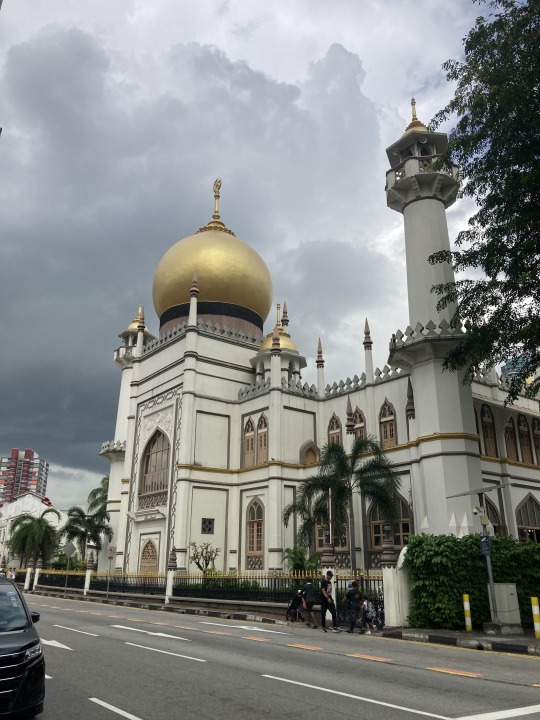
Photo Above: the Sultan's Mosque near Arab Street
We found that Chinatown was extra decorated as we were visiting so soon after the Lunar New Year. We visited the Buddhist Temple, which welcomed tourists in besides worshippers. It spanned across several floors, with amazing golden statues and statuettes on each floor. On the top floor, the entire ceiling was hung with beautiful golden lanterns, making for a spectacular view for meditators to take in.
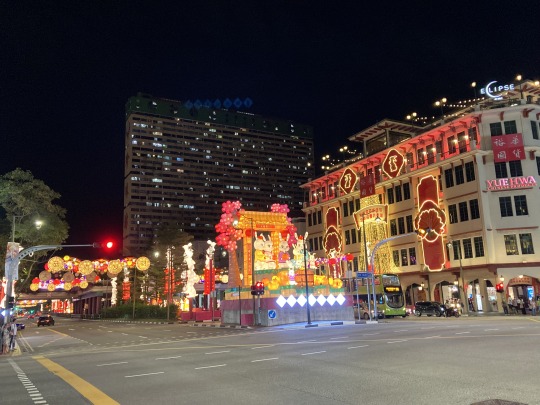


Photos Above: Chinatown decorations; inside the Buddhist temple; its roofs from the outside
We also visited a Chinese tea house with Helen and Seth, sharing a pot of jasmine tea the traditional way (which involves a complicated process of pouring tea from one teapot to another, then into one tiny vessel for sniffing, until finally it is poured into a miniscule teacup, from which you can take about three sips before starting the whole process again). Especially considering I’m not a fan of tea, it was absolutely delicious.
It was wonderful to spend time with Seth and Helen. Besides spending the majority of Sunday together, moving from Chinese tearoom to restaurant to coffee shop, we also visited them in their flat for a takeaway evening. And then while Sam and Seth went out for drinks another night, the Helens hung out (and honestly, we chatted nonstop for a solid four hours about all manner of things, but especially our love of BOOKS and reading and fiction and generally everything that’s amazing about stories).
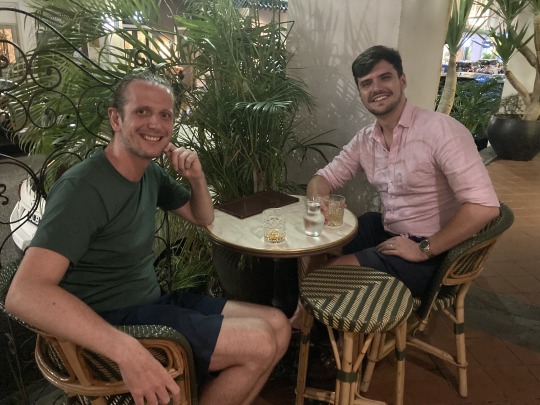

Photos Above: Seth and Sam out for drinks; the four of us in a beautiful and far too fancy coffee shop
A Tropical Respite
As I struggle being in cities, Sam had very graciously let me plan a long day out to the Gardens by the Bay, a large garden park right on the water. The gardens felt very reflective of Singapore—a merging of traditional park and modern technology. We began amid the Supertrees, 12 iconic structures that harvest solar energy for the park and are covered in literally hundreds of thousands of plants. We took a lift up the inside “trunk” of the tallest of them (which is apparently the height of a 16-storey building) to an observation deck to look out at the view across the city. I noticed several workers held in place with climbing harnesses on the spindly “branch” structures to do some painting work and felt a swoop of vertigo.
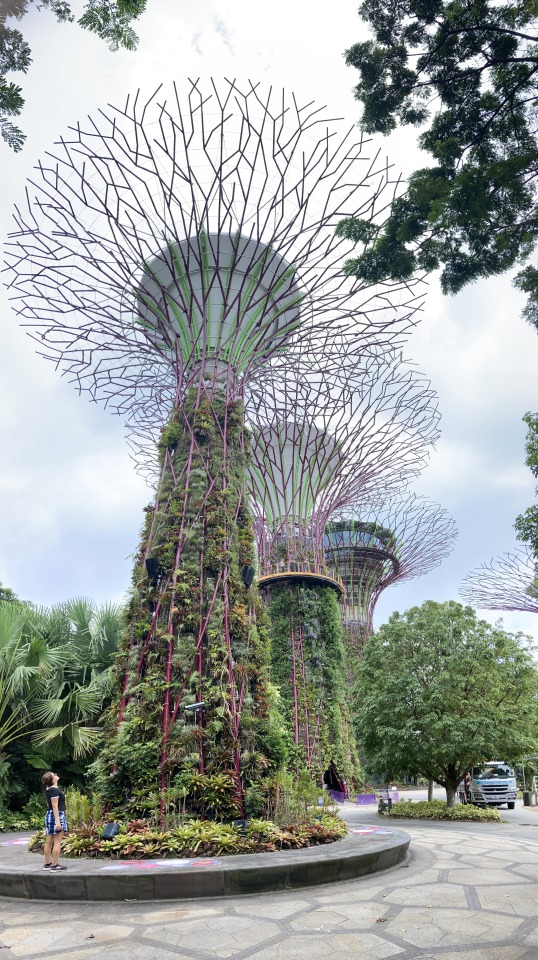
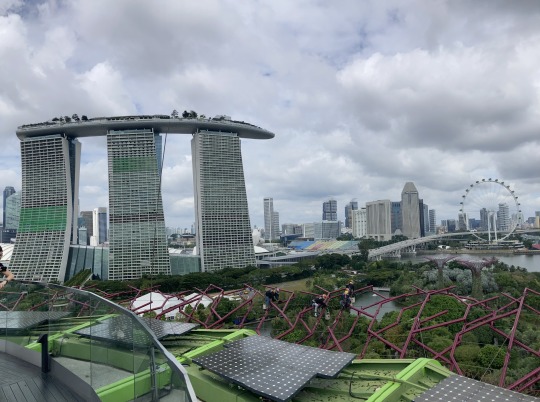
Photos Above: me gazing up at the largest of the Supertrees; the view from the observation deck at the Marina bay Sands hotel with its boat structure and the workmen tethered to the "branches"
We also wandered along a kind of boardwalk curved between several of the Supertrees to get a wider view across the city and the Supertree themselves.
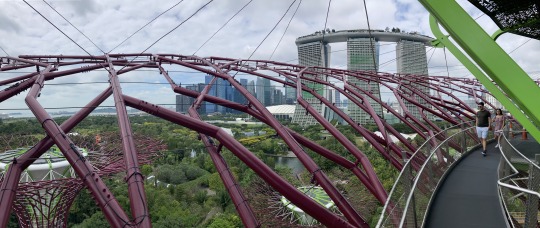
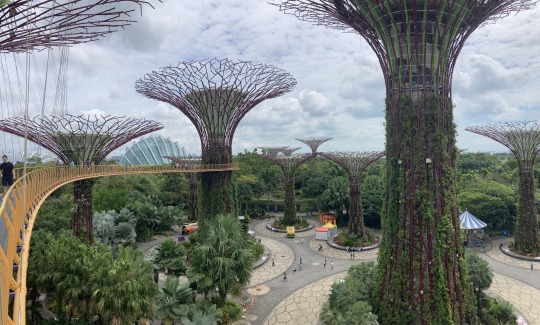
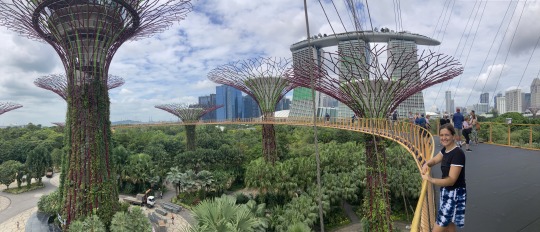
Photos Above: peeking through the "branches"; across the grove of Supertrees; wandering along the walkway
The park has three conservatory-domes. The Cloud Forest dome was the largest of the three, a huge, curved structure containing a “mountain” inside it. This mountain had a long waterfall cascading down its side and was covered in plants. We took a lift up the middle of the mountain and then slowly climbed down it via a walkway and found that the plants at the top were from cooler climes while those at the bottom mirrored the flora of a tropical rainforest. There was also an Avatar experience within the conservatory, which meant that there were several sculptures depicting creatures from the blockbuster film dotted amid the borders and a couple of gimmicky technological games to take part in—we weren’t so fussed by this aspect of it. This aside, I especially loved this dome, given my fascination with tropical plants. Sam captured my childlike wonder in a series of photos that I have artistically and not at all tongue-in-cheeked named: “Helen Gazes at Plants”.
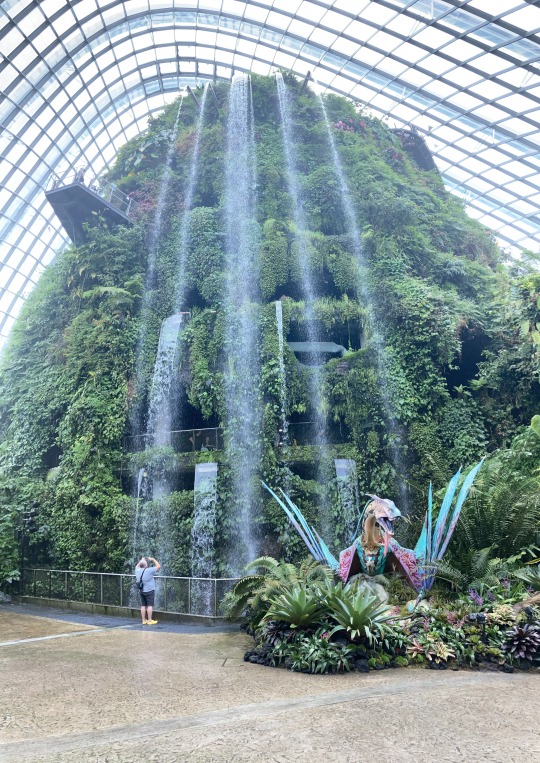
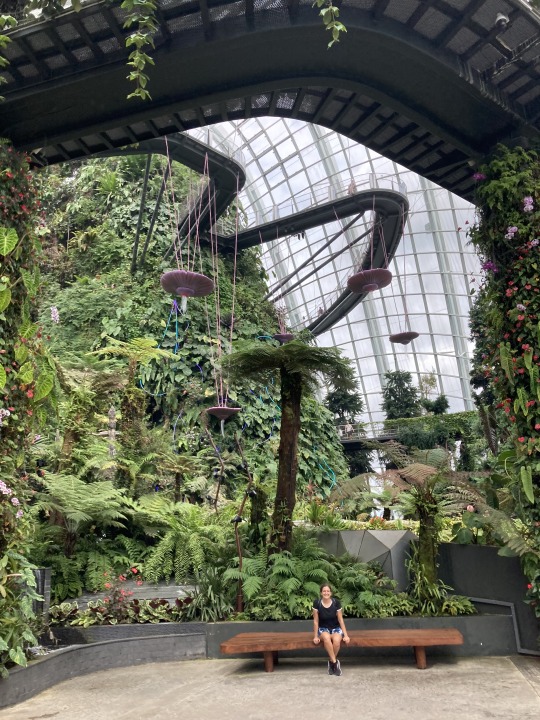
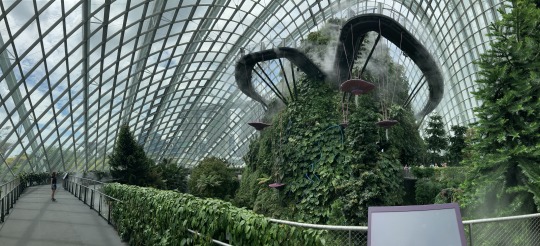
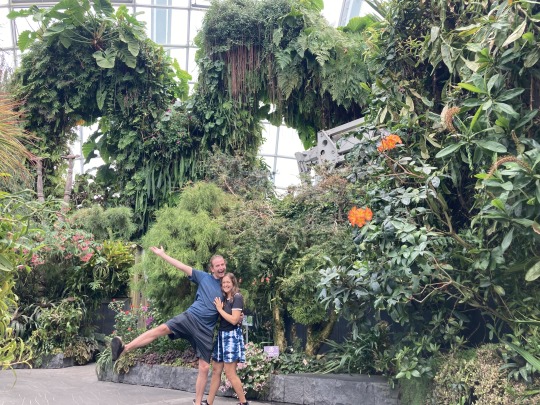

Photos Above: the cloud forest waterfall; a view from the other side of the cloud forest "mountain"; walking along the dome's boardwalk with a view of the city through the glass; together at the top of the "mountain"; inside the waterfall


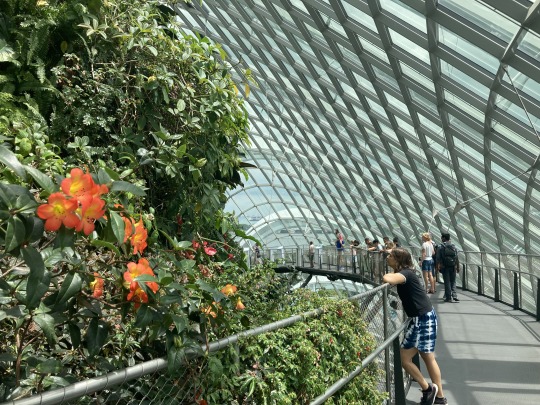

Photos Above: Helen Gazes at Plants (Part I: Cloud Forest)
The second conservatory was called the Flower Dome. We were less impressed with this one—though the succulent, Mediterranean, and Baobab sections were really cool, it was less spectacular and the piece de resistance was an incredible tacky, plasticky display set up for the Lunar New Year that seemed to be the draw for most other visitors.
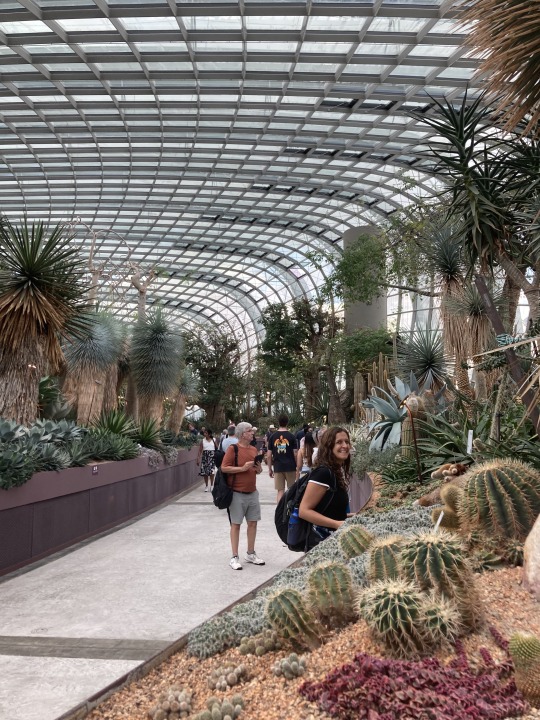

Photos Above: Helen Gazes at Plants (Part II: Flower Dome)
Finally, we wandered through Floral Fantasy. This conservatory was almost like an art installation, with creative displays made of both living plants and dried flowers making for an explosion of colour. There was also a large glassy display case, which we realised, when we peered closer, housed a number of Poison Dart Frogs from the Amazon, coloured black with vivid blots of either bright blue, yellow, or green.

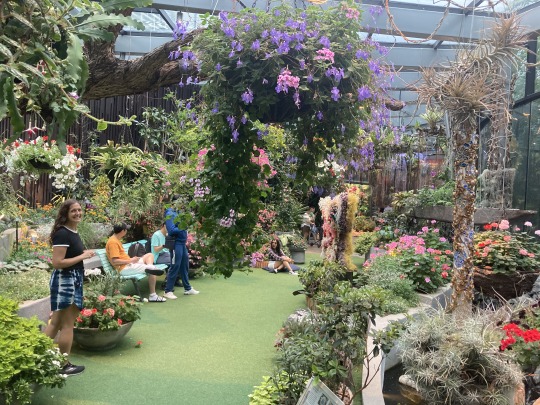
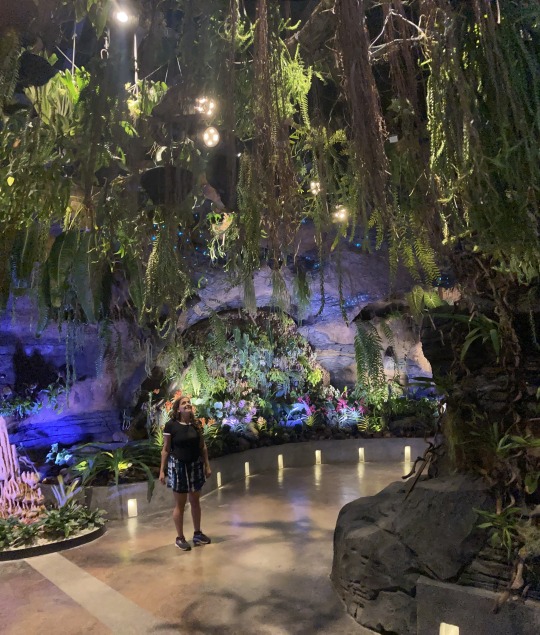

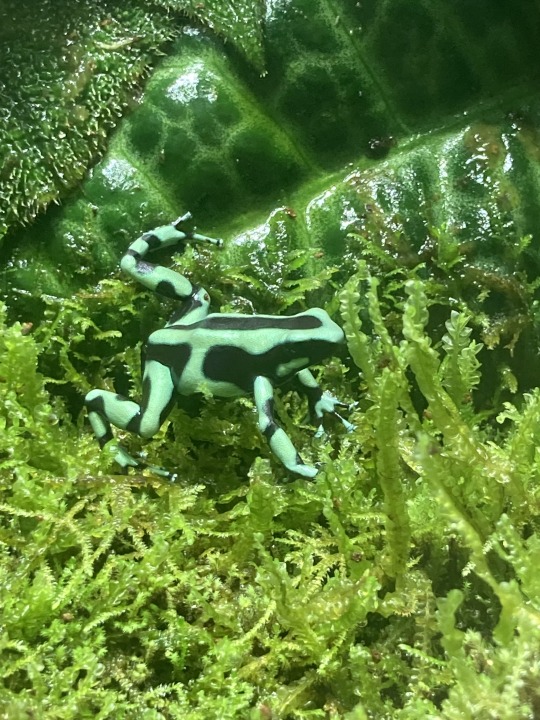
Photos Above: Helen Gazes at Plants (and Frogs) (Part III: Floral Fantasy)
Home Sweet Home
All too soon, our visit rolled by. Before my brain had really grasped what was going on, we were packing up, moving through the airport, boarding the plane home. Fourteen hours later, and exactly four months and one day after we left British soil, we landed in London to be greeted with a hug from my dad.
Of course, it was bloody freezing, but impressively the sun was out to help make the transition back just that little bit easier.
Thank you for coming along on this journey with us—the last few months have been such incredible, transformative experience for us and though we’re sure it’ll take some adjusting being back in the UK, we’re also really excited to begin setting up our new home together in Bristol.
And so with that, it’s time to say, for this trip at least… that’s all folks!
1 note
·
View note
Text
Close Encounters
The Home Stretch
Hello family and friends, Helen here, taking back control (eeep, it’s gone all political…), after the recent fantastic takeover by my sister Jo.
Sam and I parted company with Jo when she headed to the international terminal to take her flight back to the UK. With Sam’s ears still playing up, we finally gave up on diving together. So we sent our dive gear back with Jo and decided to try something different for our final ten days in Indonesia.
Sam and I flew north-west, landing in Medan in North Sumatra, the most populous city in Indonesia outside the island of Java. Having been about as far east as you can go in Indonesia just ten days ago when exploring Raja Ampat, we were now pretty much as far west as possible. We spent a couple of days in Medan planning the remainder of our Indonesian trip and wandering around. The city was bedecked with beautiful decorations in honour of the Lunar New Year, with whole streets hung with red lanterns and individual shops erecting lavish displays. On our second night in the hotel, we received a phonecall asking us to answer our room door because the staff “wanted to give us fruit”, where upon doing so two members of staff shyly handed us a red note wishing us a Happy Chinese New Year and two oranges. Adorable!
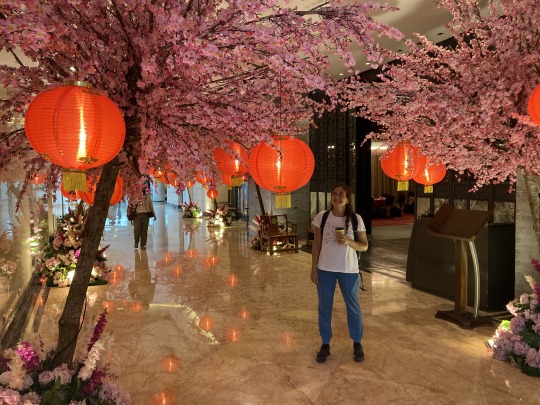
Photo Above: one of the beautiful displays in honour of the Lunar New Year
Given our love of food, we ended up doing a bit of a gastro-tour—Medan is the first place we’d been in Indonesia with a large Chinese-Indonesian (and therefore often Buddhist) population, so we found that it was incredible for vegetarians and vegans. We saw next to no foreigners, so these food spots were always aimed at locals—in fact, the Chinese-Indonesian owner of one of the vegan restaurants told us the story of visiting Ubud (the alternative yoga and arts town in Bali that we visited in November, which also had a strong vegan food scene) and how, upon walking into a vegan restaurant, he looked around in complete astonishment at the clientele and exclaimed, “where are the Chinese?!”. Given that there were so few foreigners, we were somewhat of a novelty. Case in point, when we stopped by a roadside vegetarian Makasan Padang place (Makasan Padang being a typical Sumatran cuisine, and one of Sam’s favourites from our trip), the staff requested a team photo with us.
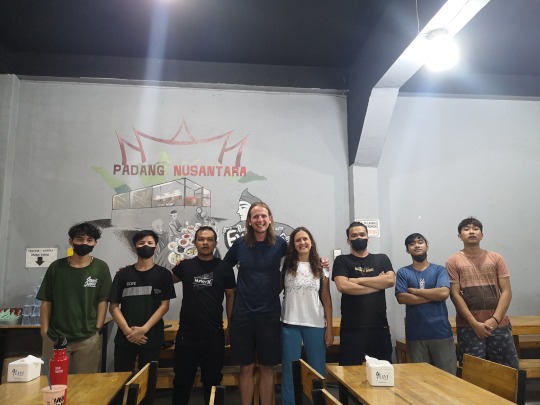
Photo Above: veggie Makasan Padang team photo!
Though Sam’s back was slowly improving, it was still causing him a fair amount of pain, so we decided to be fancy people and for the princely sum of about £15 ($19), we bought a day pass to the Marriott hotel spa to have a lovely romantic day relaxing together. We took the lifts all the way up to the spa on the seventeenth floor, our heads full of visions of our romantic day spent chatting away together in the sauna and steam room. What we didn’t account for, however, was the fact that in a Muslim-majority place, the sauna, steam room, and jacuzzi were very definitely gender-divided. So instead, during the morning when there were no men using the facilities, Sam convinced me to cheekily sneak into the men’s facilities. Later, when it got busier, we did our hardcore relaxing separately and periodically met up to swim lengths of the outdoor infinity swimming pool (complete with incredible views across the city) and giggle at the turn of events.

Photo Above: the luxurious infinity swimming pool with a view across Medan
After a couple of days eating and relaxing in Medan, we made the three-hour journey west to the rainforest village of Bukit Lawang, famous as the gateway into the jungle that is home to the Sumatran Orangutans. As the city morphed into tropical countryside, we began passing palm oil plantations, which stretched for miles along the rest of our journey. When we reached the village of Bukit Lawang itself, we were welcomed by someone from our accommodation. He hoisted our large bag onto his shoulders and led us down a small alleyway, then along a dirt track besides a river lined with rickety wooden buildings and across a narrow pedestrian suspension bridge spanning the river. On the other side, we began scaling 270 stairs, climbing high until we reached On the Rocks, our home for the next while. The lodge was nestled right next to the border of the Gunung Leuser National Park, so we picked a small, wooden cabin built into the steep side of the hill, complete with huge balcony overlooking the rainforest and a vast glassy window in the bathroom meaning we had a loo with a spectacular view. That evening, we fell asleep to a vast soundscape of rushing river, buzzing cicadas, and chattering monkeys. When we stepped onto our balcony the next morning, a troupe of Thomas’ leaf monkeys (an endemic species of primate with distinctive black and white facial markings) were climbing the trees a few metres from us and play-squabbling amongst themselves.


Photos Above: the palm oil plantations lining the road; serious porter skills
We spent a couple of days relaxing in the lodge, going for a wander around the village (mostly so that I could gleefully walk back and forth on as many of the rickety bridges as possible for fun), soaking up the stunning views, and relaxing into the lushness of the rainforest sounds, smells, and foliage.
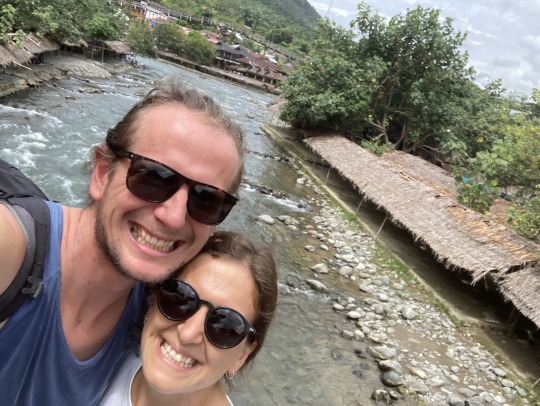
Photo Above: exploring the village
Into the Wild
On our third day there, we each packed a small rucksack and met our trekking group for the next few days up at the lodge’s restaurant. As I’m such a keen bean about all fauna, I had done my ape research beforehand. The word orangutan is, in fact, from the Indonesian, meaning “forest person”. There are three species of orangutan in the world, the Sumatran Orangutans we hoped to see being found only in Sumatra, as their name suggests. They are critically endangered, with only an estimated 14,600 remaining in the wild.
Just before we set out, a shout went up—a short way across the valley, a female orangutan and her adolescent baby were making their slow, swinging way through the trees, the mother sometimes acting as a bridge between two trees for her child to climb across. I was completely entranced by their movement, especially their seemingly outsized arms, which were far longer than their legs—orangutans can’t jump, so they always move through the trees limb to limb. As everyone joked, no need to go on the trek now!
We set off into the jungle. Our On the Rocks team was made up of an extended group—there was Ulf and Zilke, a German couple travelling with their children, Lulu (12) and Alvin (8), who were doing a shorter route than us each day, so had their own two guides, while our immediate group included Magda and Max, a couple from Germany, led by Ling and supported by Bincar. Later it would become apparent why having two guides per group was so important.
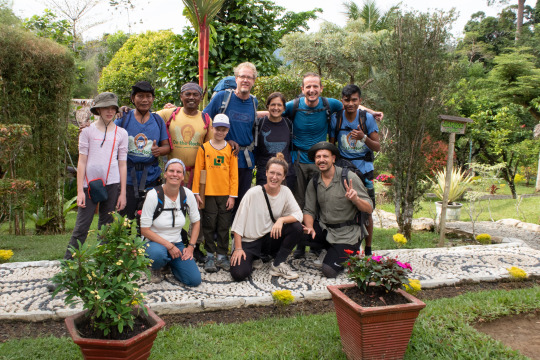
Photo Above: our extended trekking group
The trekking started gently, as we followed a trail through the jungle and Ling pointed out interesting things to us—first, the solidified gum from a gum tree, then the pungent smell of orangutans, and then a short while later, some more Thomas’ leaf monkeys who casually came down to the forest floor to check us out. We also came upon the orangutan mother and baby we had seen from the lodge and hung out below them for a while. As we walked, Ling would scan his eyes through the canopy and I could practically see his ears stood on end, so tuned in was he to his surroundings. He would periodically make orangutan noises, the sound of the female sounding like someone doing a loud kiss into the palm of their hand, while the male noise was much more like a deep gruff cough. It turned out that Ling was super experienced, having been guiding in this jungle since 1999, and it was quickly evident how much he loved the forest and how completely at home he was in it.

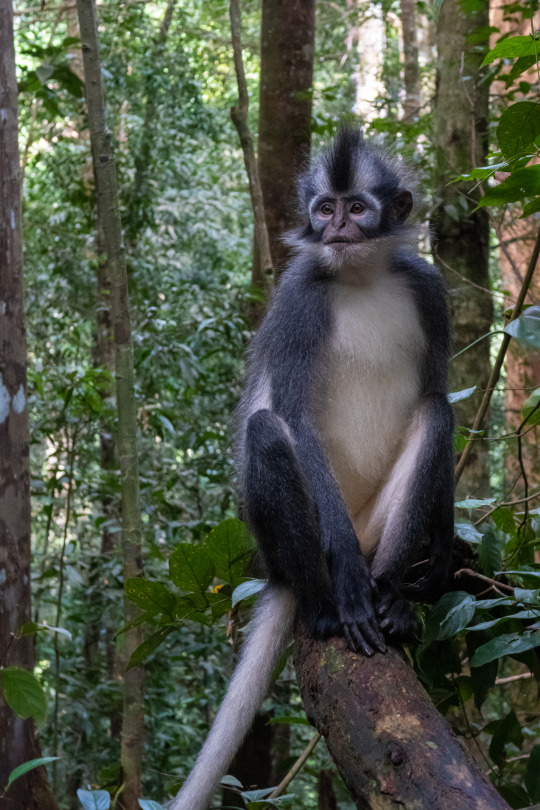
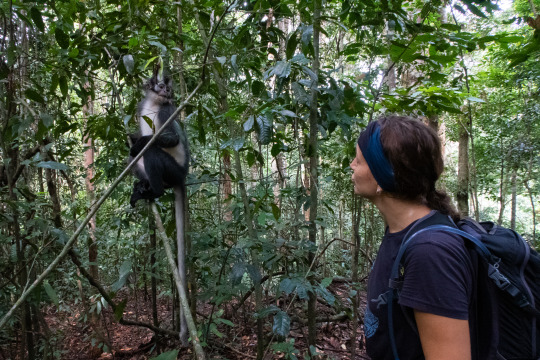
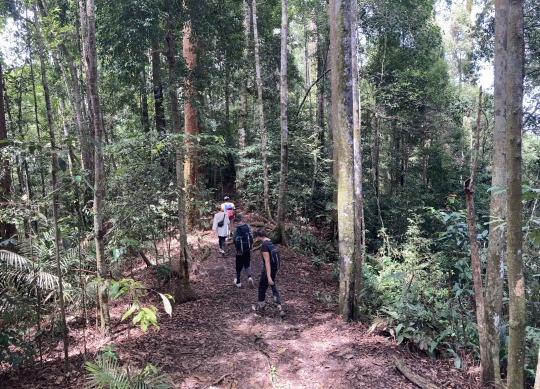
Photos Above: me gazing up at a huge gum tree; a Thomas' Leaf Monkey; making friends; walking the rainforest trail
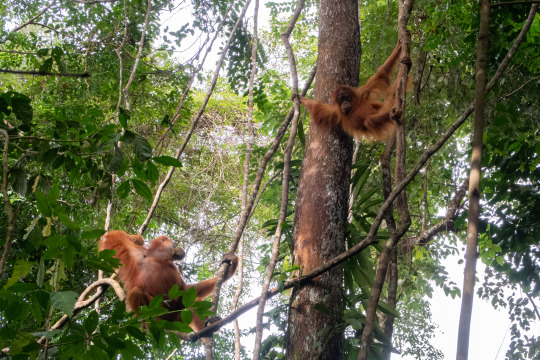

Photos Above; the mother and her baby; the mother orangutan's vast armspan
It was not long before we came across our next orangutans. This was a particularly special experience—it was an adult mother with a tiny, scraggly-looking baby clutching the fur on one side of her torso, so newly born that it’s umbilicus still hung from it, swinging in the air as the mother moved. Our guides figured that the baby was merely a day or two old, and we watched as the mother kept gently touching her fingers to her vagina and licking them because she was still bleeding from the birth. While her own fine-haired fur was a vivid russet colour, her baby looked like a pale, wrinkly little Gollum. She seemed completely unfussed by the humans peering up at her and in fact slowly swung her way towards and above us so that she passed within a few metres. I couldn’t stop staring at her, especially her face, which seemed so expressive that it was hard not to anthropomorphise her.
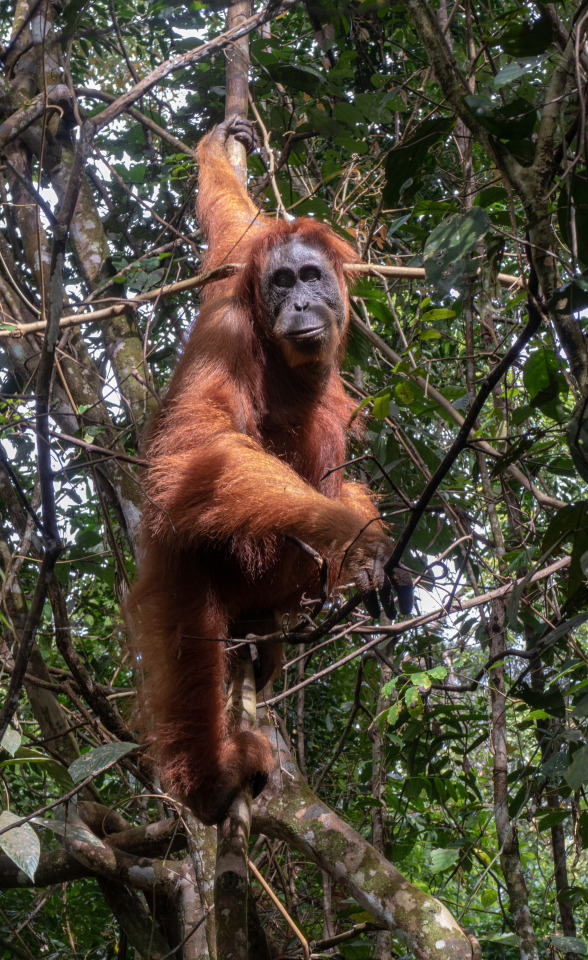

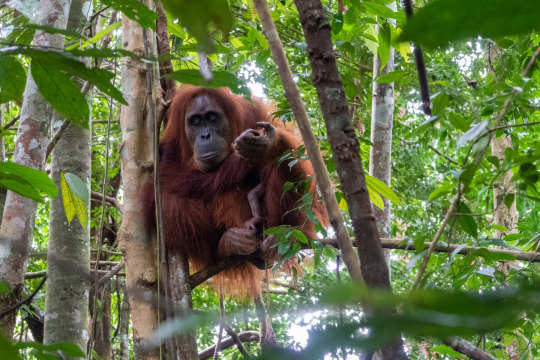

Photos Above: mama orangutan; the mother on the move, her baby clutching her side as she holds the umbilicus; chilling in the tree; inspecting the umbilicus
The second half of the trekking that day became a lot more difficult—Ling and Bincar kept up the calls of “hati hati!” (“take care!”). The terrain was at first steeply uphill and then extremely downhill, so much so that often instead of walking, we had to climb, using lianas or thick tree roots protruding from the soil as handles to help us down. By the time we reached our camp for the evening and rejoined the German family, we all felt ready for a dip in the cool water of the nearby stream. Afterwards we sat around altogether chatting, while the guides and kids carved orangutan faces into small, reddish clay pebbles from the river to create a jungle necklace. Ling handed his first carving over to me as a gift.
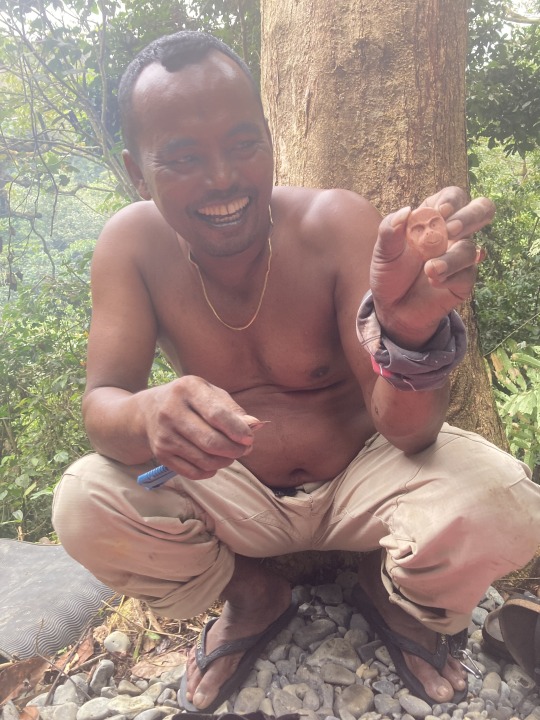
Photo Above: Ling carves me an orangutan pendant from a pebble
Our camp was made up of one roofed hut where two cooks had lit several fires to cook our dinner, plus two other roofed structures under which we would sleep for the night. With the leakproof roof, spongy mattress mats, and a large mosquito net hung over myself and Sam, it felt pretty luxurious. As the rain started that evening, we all crowded into one of the huts to be served up a feast of vegetable curry, spiced tofu and tempe, rice, and cooked vegetables. Sam and I had a great time watching the children tell raucous jokes in German—though we mostly couldn’t understand, there was plenty to appreciate in the sheer joyful giggles from the rest of the group. Though I may struggle to sleep in cities with the sound of traffic passing by, it turns out that thunderous rain on a tarp-and-thatch roof does just the trick.

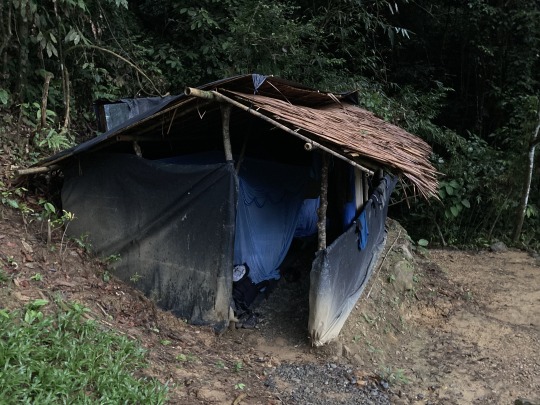
Photos Above: the cooking hut with the rainforest view behind; our bedroom for the night
Face to Face
The next day, we had a nice slow morning. Everyone sat outside, carving more orangutan pendants from pebbles, drinking tea and coffee poured from coconut husk teapots into coconut husk cups, and watching a group of Long-Tailed Macaques low in the trees around us, clearly waiting for us to leave camp before they would trawl the place to check for any leftover goodies. I managed to acquire a leech between my toes, and when I calmly pulled it off and pressed some tissue to the mini wound it had left, I caught several of the guides casting eyes at each other before one asked, was I not afraid? Turned out that they had come to expect a screeching reaction from guests.
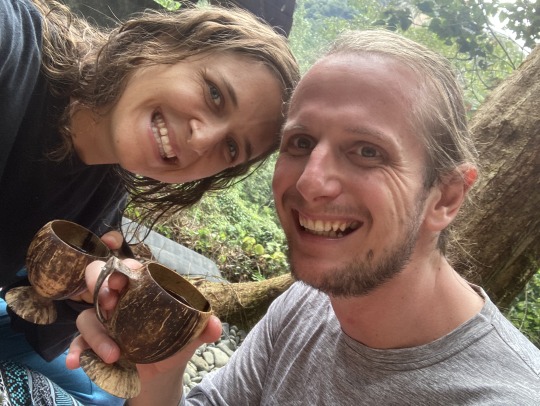
Photo Above: a genteel rainforest breakfast
I may be nonplussed by bloodsucking leeches but when we set off trekking, I found I was extremely stiff. Because of Sam’s sore back, I was carrying almost all of our water for the day and so climbing up the steep hill, I felt a bit like a tortoise trying not to swing backwards onto its heavy shell. But after an hour or so and a couple of steep slopes up and down, I had settled back into the rhythm of things. At the top of one hill, we dumped our bags amid the tree roots and paused while Ling wandered a short way away making his usual orangutan noises to see if there was anything in the vicinity. Suddenly we heard him shout “Run, run, take your bags, run!”. We couldn’t tell if he was yelling in excitement or fear nor if he wanted us to run towards him or away. Then he came dashing up to us, shouting that a male orangutan was coming. Though humans rarely experience issues with female adults, male orangutans can be aggressive, especially when patrolling their territory, and to have a large one down on the ground was unusual. We dashed up the opposite hill, just as the big male came sloping into the clearing. Rather than following us, he paused to sit at the base of a tree, simply peering at us, perhaps to get a better scope of the situation. Ling stood well in front of us, communicating clearly about how far away we should stand and how to interpret the male’s behaviour but encouraged us to take photos. He was huge, a male named Jarwao who was at least 40 years old Ling later told us, and he was flanged—meaning he had the iconic orangutan face flaps and bulging throat sack. When I had previously researched this phenomenon, I found out that the current best guess as to their purpose is as a kind of megaphone for the calls that males make as part of declaring their territory. I couldn’t contain my excitement—I had been desperate to see a flanged male and here he was, so huge and powerful that I couldn’t tear my eyes away from him. It was barely a minute before he started coming towards us again, his long-muscular arms giving him a formidable presence. Ling held up a huge stick and hit it on the ground—making yourself big and aggressive is an important part of a guide’s role to ensure everyone remains safe. Jarwao didn’t react at all besides simply standing and watching Ling. We all hurriedly walked on, with Ling holding back to create space for us to traverse a steep downhill—he told us that orangutans are extremely fast downhill compared to humans so we trekked all the way down the vast hill before stopping besides a stream for lunch.
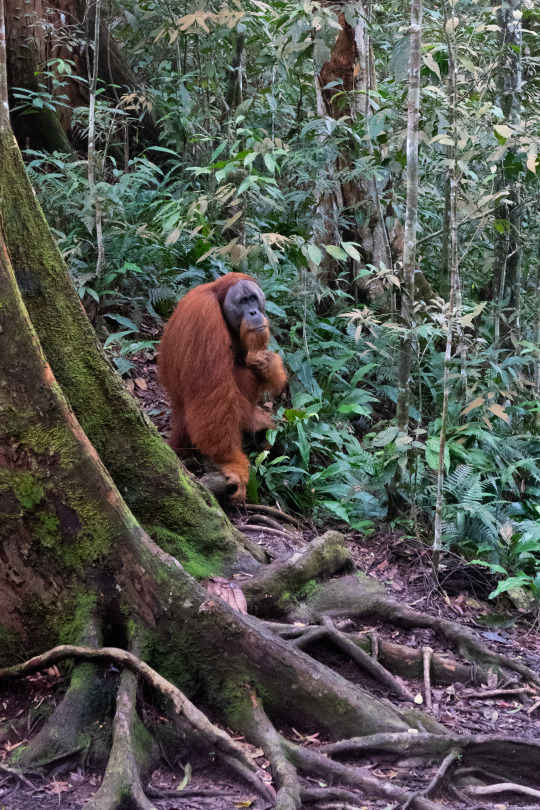

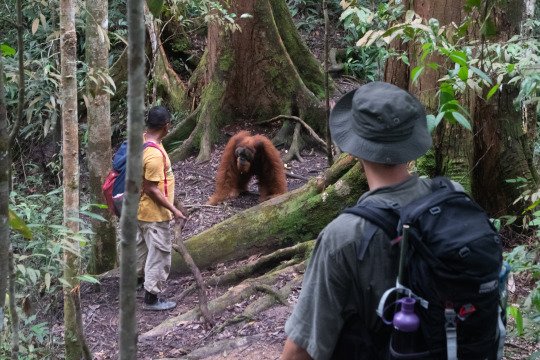

Photos Above: Jarwao appears; a quick snapshot with him; he continues to approach; he pauses and watches us for a while
Bincar and Ling made up little paper pouches of precooked noodles for us and then Ling kept watch looking up the hill. We had been sat about eating and chatting for a good ten minutes when Ling jumped up and told us that the male was coming down the hill. As we grabbed our bags, I saw Max look up and heard him say with shock “He’s there!”. I caught a flash of orange not far from us before everyone fled across the shallow river and began clambering up the steep trail on the other side. I was at the back of the group, with only Ling behind me. As I crossed the stream, I turned momentarily and found myself merely 4 metres from Jarwao, just as he arrived at the opposite bank. We locked eyes and I heard Ling shout a few metres to my side, fear in his voice, for me to RUN. I turned and hared it up the hill. Later, when Sam and I were chatting, we worked out that he had looked back down the hill at this very moment to see Ling throw his rucksack on the ground to distract Jarwao. I scrambled up madly and so only saw one snapshot after that: Ling running downstream between me and Jarwao, Jarwao turning to follow him. He yelled some instructions at Bincar—I presume he told him to lead us up the hill and away.
We all raced upwards not saying a word. Bincar swapped places with me so that he was bringing up the rear until we were right at the top and then he led us silently on. Besides my telling the others what had happened at the bottom, no one said a word. My mind kept turning to Ling flinging himself between me and Jarwao and I desperately hoped he was okay.
Shortly, we came to another group taking a rest and told them what had happened. The guides decided that we should leave one of their guides behind to try find Ling while their other guide and Bincar would escort us to camp. We all began climbing downwards. I was madly concentrating—with my old knee injury, I wasn’t the speediest at downhills, but I knew that injuring myself would present everyone with an even bigger problem. After a while, Ling and the other group’s guide caught up with us. I was glad to see Ling in one place, puffing madly on a cigarette and unscathed besides a bruise on one knee from falling over. He told us to keep hurrying though, so we kept moving until we reached our camp besides a large river at the bottom of the valley. Orangutans don’t come down to the river—it’s too dangerous for them to be out in the open—so the guides knew we’d be safe in the camp.
We dumped our bags, changed into our swimsuits, and slid into the eddies at the edge of the river, where the water wasn’t so strong that it would pull us downstream. After our much-needed chilly dip, we began piecing together the events of the afternoon.
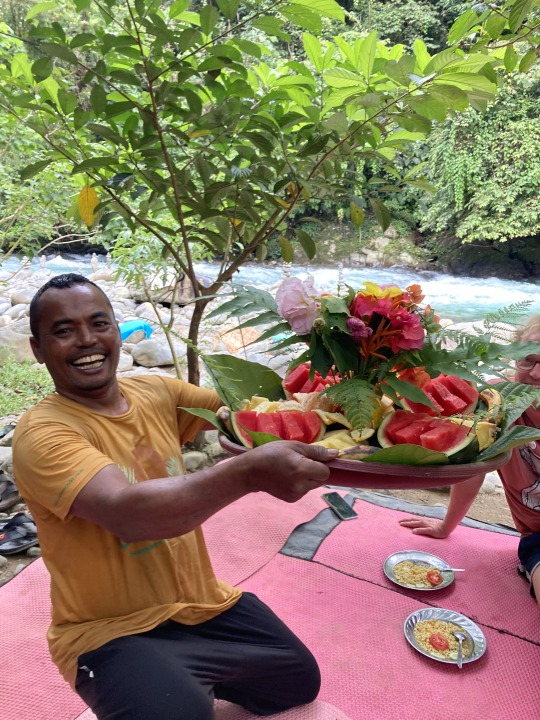
Photo Above: Ling with his beautiful rainforest floral arrangement
Ling told us that though he had had many experiences with males over his more than two decades working in the jungle, it had never been like this. Usually males keep a good 15 metres away, and if they do show any aggression, they quickly fall back when faced with his own tactical “display of aggression”. On top of that, Jarwao usually stayed deep in the jungle and had never been seen this far out, a mere two days walk into the forest. Ling had also never seen a male so angry—he told us that after he used his rucksack as a decoy (he managed to grab it when he ran past), he had run in a loop to keep Jarwao away from the group and twice fell over and nearly had him catch hold of his leg. His best guess as to why Jarwao was so angry was that a group had passed by earlier in the day and potentially fed him—although guides occasionally use fruit to distract a male if in real need, simply feeding orangutans is really discouraged as over time it can change their behaviour and cause more aggression. With all this said, once it became apparent that Ling was okay and that everyone was safe, I quickly felt as though we’d had a real adventure. After all, this was nature, Jarwao was a wild animal, and we were blessed to come out unscathed, in large part due to having such an experienced and courageous guide. When I went to bed that night, I thought of Jarwao standing a few metres across the stream from me and how that vivid moment will stick with me for the rest of my life.
I was up earlier than everyone else the next morning and straight into the river for my morning dip. We had another relaxed morning, with a late breakfast then a short walk upstream to a small waterfall with a deep plunge pool, where I sat under the waterfall itself, letting the stream pummel my shoulders with a deep massage. After lunch, we packed up and watched as the guides and cooks created a special raft for us. They tethered together four black inner tubes, two large in the middle and a smaller one either side. Then they took all our bags and cooking stuff, secured them in several layers of thick plastic bagging, and tied them on top of the inflatable rings. Finally, Sam and I got into one of the large rings in the middle, sitting side by side, while Magda and Max sat in the other large tube. Ling, equipped with a long bamboo pole, sat in the front small ring and one of the cooks, also with a long guiding pole, sat in the back small ring, while Bincar perched on the edge next to Magda. And with that, our team set off down the river. It was extremely fun rafting along for a good 45 minutes, Ling and our cook using the poles to keep us from the banks and guide us through the mini rapids. I spent most of the journey either gazing around at the beauty of the rainforest covering the slopes of the valley on either side of us or giggling at the sprays of cold water that hit us whenever we bumped over rapids.
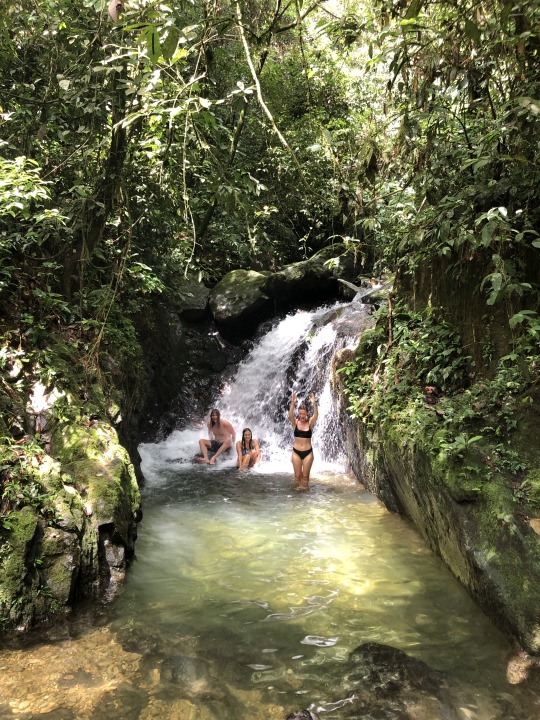
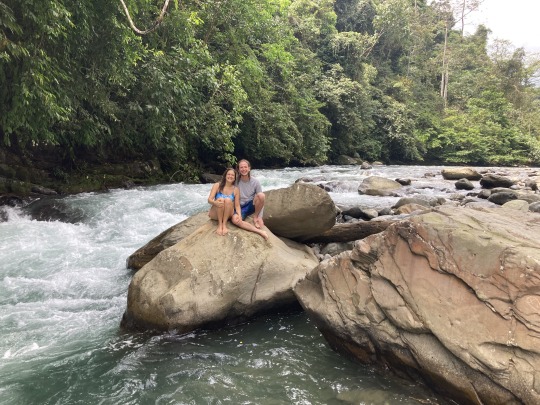
Photos Above: a waterfall massage; beside the river
When we were not too far from arriving back in Bukit Lawang, we pulled up at the riverbank. Our bags were unwrapped and we changed into our hiking gear, looked on by a mother orangutan and her roughly 4-year-old baby sat high in the trees above us. Then Ling led us once again into the forest for our final hike. Safe to say, after three days profusely sweating into our clothes, we all smelt about as strongly as orangutans. We had a fantastic last couple of hours in the rainforest, including seeing another mother, this time with a roughly 1 and a half year old baby, who swung through the branches much more tentatively than the baby we had just seen. As we neared Bukit Lawang, the sounds of the rainforest became punctuated first by a chainsaw, then by music drifting up from the village, and finally, just as we walked back into On the Rocks lodge, the afternoon call to prayer began to sound from the mosque.
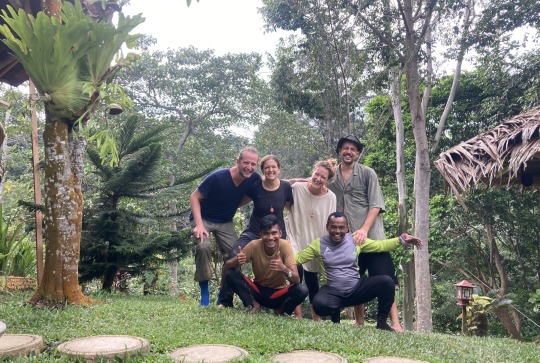
Photo Above: the "after trekking" shot—just as well you can't smell us!
youtube
Video Above: a short compilation of our trek, showing footage of trekking itself, the mother orangutan with her newborn baby, and finally the very few seconds of video we got of the large male, Jarwao
Our Final Indo Hurrah
Safe to say, we all headed straight for a shower. That evening, we ate a vast spread with Max and Magda in the On the Rocks restaurant, unpicking our adventures of the last few days.
The next morning, Sam and I packed up, said our goodbyes to our trekking team, who we felt very bonded with after our shared experience, and headed back to Medan.
Sam and I had just one full day left in Indonesia, so we decided to book into a fancy hotel for a final hurrah. In reality, most of the day was spent running errands and drafting up this update but we did manage a short spa session together, a few final excellent Indo meals, quite a few glasses of complimentary wine, and a whole lot of gazing out at the amazing view of the city from our room on the twenty-third floor.

Photo Above: the spectacular view from our hotel room window
But time has a way of rolling ever onwards, and so we packed our bags, headed to the airport, and boarded a plane for Singapore—for our final few days away, we’re visiting friends who moved out here recently. As the plane took off, we both gazed out of the window. Indonesia had been vast and chaotic and humbling, and above all, oh-so good to us.
2 notes
·
View notes
Text
Lembeh Larking
From Raja Ampat, our adventures continued about 1.5 hours flight due west in the Lembeh Strait off the Indonesian island of Sulawesi.
The Life of (Relative) Luxury
After the basic nature of our setup in Raja Ampat, we fancied a slightly more luxurious way of life for the next part of our adventures—aka somewhere with a FLUSHING TOILET (oh the thrill!).
So we chose to stay in a small resort, which meant a private bungalow each, complete with ensuite and a gorgeous view of the bay from the balcony. The lush green surrounds were home to a myriad of butterfly and bird species and one morning we even saw a monitor lizard swimming across the bay. Importantly, we were also treated to a slew of amazing vegan meals each day—the endless, delicious ways tofu and tempeh can be prepared is truly astounding.
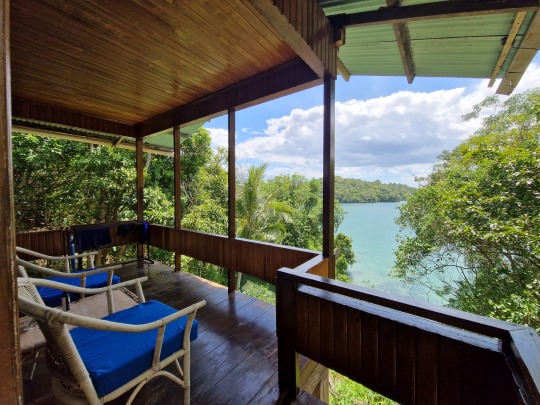
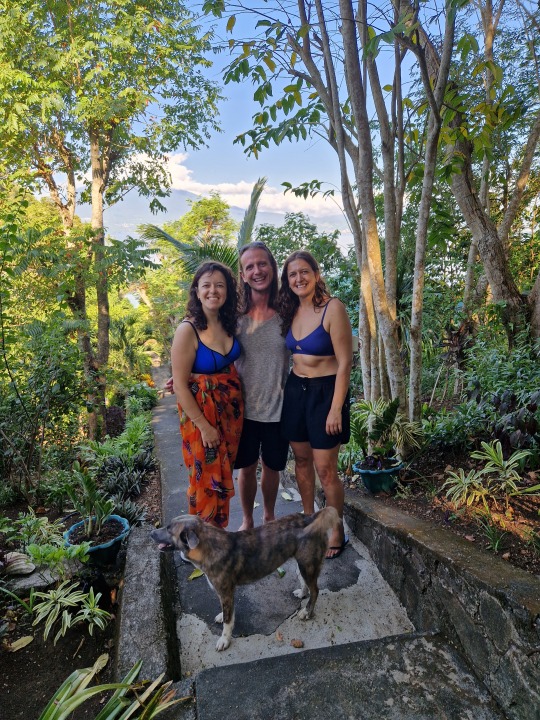
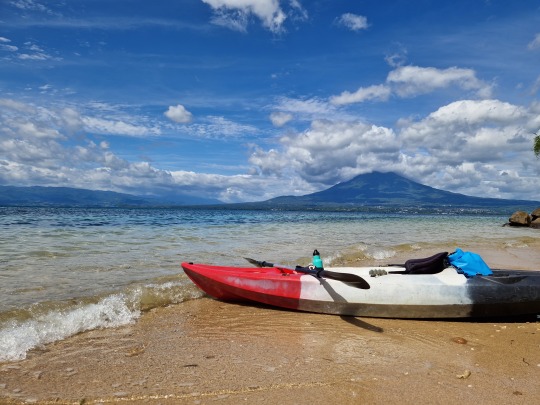

Photos Above: view from my bungalow balcony; the team; kayaking adventures; a little snake popped by to say hello
Diving the Lembeh Strait
Much like our accommodation, our diving was also a luxury experience—Helen and I had a sizable private boat with three able crewmen (the captain, first mate, and our dive guide Rinto) at our disposal the entire time.
The diving in Lembeh was very different from that in Raja Ampat. In Raja Ampat, although there were plenty of divers, there was little in the way of infrastructure on land, so you felt as though you were diving in the middle of nowhere, looking at bountiful reef ecosystems. In contrast, the Lembeh Strait is a slice of water between the industrial harbour town of Bitung and Lembeh island. It felt much more like diving in a man-made world both above and below the water—once we even moored up right next to two massive fishing vessels, plopped over the side of the boat, bobbed around on the surface (me having a mild panic attack and praying the boats had no plans to move any time soon) and slyly slunk below the waves. That dive started with the sound of a huge boat engine throbbing in our ears—vaguely like having a mild headache for the first 20 minutes of the dive. There was also the time we rolled backwards into the water from the diving boat, which reversed out of our eyeline to reveal a fishing vessel behind with around 20 men sat on deck smiling down at us. ‘Uh, hello!’ was, I believe, my nonplussed response.
Whilst Raja Ampat was reef diving, almost all of Lembeh was muck diving, which involves barely any coral reef—instead you descend to a rubbly or sandy bottom (invariably with an entire corner shops’ worth of manmade debris lying around too) and move in a slow zigzag movement, peering at the seabed for all manner of weird and wonderful creatures making this environment their home. The creatures there were masters of camouflage such that I have never seen. Everything looked like everything else. There were fish patterned like sand lying flat along the sandy bottom. Frogfish looking like coral. Even some of the nudibranches (a type of sea slug that are usually colourful blobs) have evolved to look like bog standard seagrass.
Some of the camouflaged creatures were, in my opinion, pushing their luck. Once, Rinto pointed out a tiny ball of orange fluff and declared this to be a shrimp. In fact, quite a few times Rinto would make the sign for shrimp and I would sigh and swim over to peer at a leaf, or grain of sand, and attempt to persuade myself it was a shrimp. On a dive towards the beginning of our experience, Helen called me over and kept enthusiastically pointing at a twig and asking me if I could see it. See what? A twig? With encouragement, I peered close until I could just about make out a snout and two eyes (if I squinted hard and really believed in it). A pipefish, apparently. Five minutes later on the same dive I excitedly gestured for Helen to come over and pointed sarcastically at an actual twig. When the sarcasm hit home, Helen collapsed into her first ever underwater giggle fit, which of course set me off laughing too—causing Rinto to look over in concern as we convulsed underwater (between giggles I was giving Rinto the ‘ok’ sign again and again to try and allay his suspicions that we might be suffering an attack of some sorts).
As well as ridiculous levels of banal camouflage, Lembeh Strait dished up some of the most amazingly weird creatures I’ve ever seen. High up on the list was just the head of an eel poking up out of the sand with its jaws open but locked down upon a juvenile cowfish (Helen said she could see the cowfish’s eye moving, but unfortunately, none of the rest of it). There was also a mimic octopus, whose short body and long elaborate tentacles changed colour and shape when we moved near. A blue-ringed octopus the size of my hand looked sandy coloured until we approached and then broke out with bright blue rings covering its entire body. We gently hovered our hands over it to see the blue rings and it was only upon returning to land (where Helen geeked out on the marine research from that day’s diving) that we discovered it was in fact highly venomous…
We saw cuttlefish galore, the smallest of which was half the size of my little fingernail but still glittering away enthusiastically. And on a night dive, a squid gave us an amazing shimmering show by torchlight—even hovering in front of Rinto’s torch so we could see through its translucent tentacles as it flashed at us and moved its tentacles in what can only be described as figure dancing.
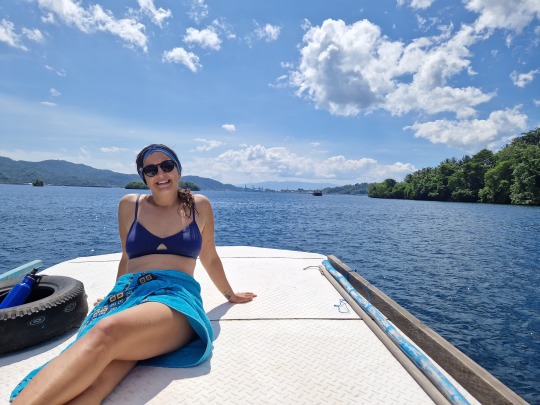

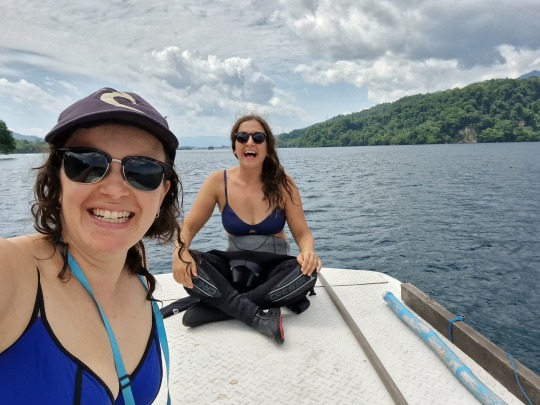

Photos Above: surface interval on our (private!) dive boat; graceful sunbathing; keen beans; with the resort staff team!
Mandarinfish Mating
The Lembeh Strait is known as one of the few places to come to see the elusive mandarinfish mating at dusk. We twice caught this beautiful phenomenon. As the light started to fade, we sunk down next to a pier where mandarinfish are known to live.
Mandarinfish are famous as one of the most beautiful fish in the sea, and I can testify this to be the case. They are iridescent blue, green, and purple and covered in lines of shimmering bronze. If you know when and where to go, it’s relatively easy to catch them in their famous courtship ritual. The ritual involves a flamboyant male catching the eye of nearby females by opening up his beautiful shimmery dorsal fin. After sufficient time spent impressing the local females, the male gradually herds them into one area of the reef and then one by one picks out a female. He lines up next to her, connecting side by side so that she rests on his pectoral fin. They rise up together in a flurry of fins for a few seconds before abruptly darting back to the safety of the rock whilst at the same time releasing their eggs and sperm in a tiny puff, to be fertilized in the water column. We watched a large male do this four or five times with different females on each dive—it was pretty special to see.
Better than my description though, you can see mandarinfish mating in this short clip on youtube.
My Final Stopover
From Lembeh we flew to Jakarta, the capital city, a smooth journey apart from the fact the flight was delayed by the airline and then by myself as I almost lost my brand new phone—a feat which involved me running off and on the airplane twice in my search as well as all the airport staff hunting high and low around the gates in case I'd dropped it. It was, of course, in my rucksack the entire time. But in good news, one wonderfully helpful Indonesian airport employee now has an enthusiastic selfie of our relieved faces to remember this incident with.
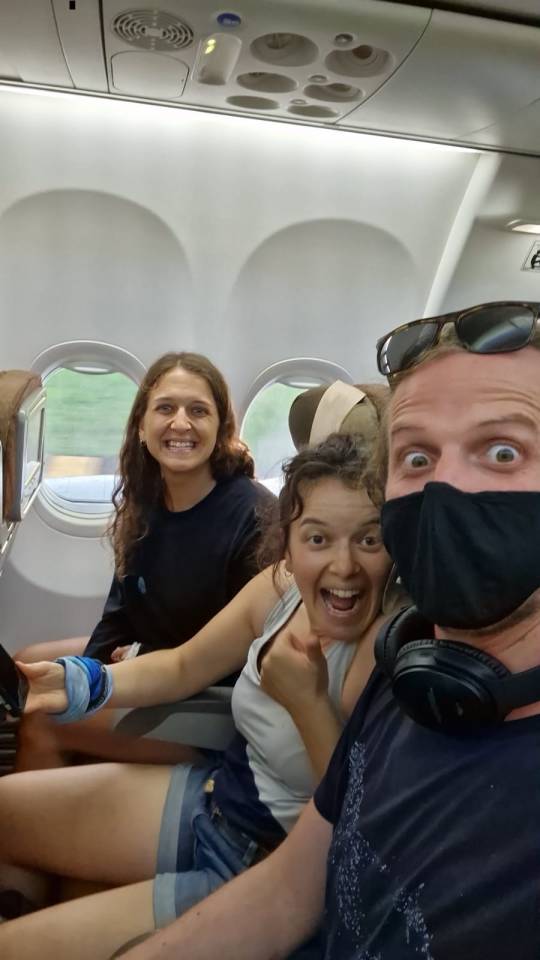
Photo Above: WE FOUND MY PHONE
In Jakarta, Anto and Bodhy (two new friends we made in Raja Ampat) generously offered us the use of the spare bedrooms available in their houseshare. So we made ourselves at home in their Jakarta mansion (complete with pool) and set about enjoying the luxuries only cities can offer.
We explored Jakarta’s vegan food scene—including impressing our hosts with surprisingly excellent vegan pizza—went for massages, hunted out oatmilk coffees, and generally rested and restored ourselves ahead of the next leg of the trip.
My final night we went out for dinner, drinks, and a dance, enjoying an… eclectic mix of Western pop music in a Jakarta bar (which all the young Indonesians knew off by heart). The only downside was that the roads were empty enough that Sam never got to experience his dream—a taste of the the insane traffic that Jakarta is infamous for (Helen and I weren't exactly sad about this). Finally, it was time to split ways and so it was I bid adieu to Helen and Sam at Jakarta airport as they set off to their next destination in Sumatra and I headed back to sub-zero temperatures in the UK.
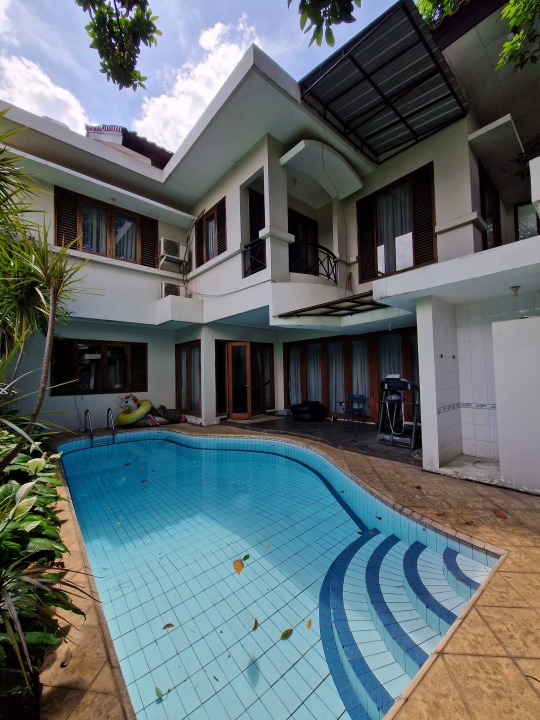



Photos Above: our Jakarta stopover; coffee time!; massage time!; out with new friends
2 notes
·
View notes
Text
It Was Manta Be…
Jo is in the building!
Welcome to the Jo-takeover! This is the part of the blog where Helen wisely decides the readers need a new perspective (hence the sisterly takeover), which, by happy coincidence, also means she gets a journalling break. So let’s pick up from where she last left…
At late notice, I decided to join Helen and Sam for a few weeks on their travels and so it was that on New Year’s Eve, I flew over most of Asia to head to the eastern most part of Indonesia—Papua. Indonesia is a vast country, so even from the capital, Jakarta, it was a four hour flight to reach our meeting point in the city of Sorong. I exited the airport in the early morning of 2nd January at the exact moment Helen and Sam stepped out of a taxi to pick me up and sweep me away to their hotel. There I met Etienne, a Swiss traveller who had been on the liveaboard with Helen and Sam and would be joining us for the next leg of the trip. Both Helen and Etienne had health issues on the liveaboard that meant they couldn’t fully dive, so the plan was to head back into Raja Ampat, with myself in tow, to absorb the underwater world. Sam unfortunately still had his ear problems and so would be snorkelling the waters.
From Sorong, the onwards journey involved a 2-hour ferry, followed by a 1-hour boat ride—plenty of time for me to observe the sad amount of plastic debris floating in the water in this otherwise tranquil and remote setting. Eventually we reached our base for the next ten days—a group of huts built on a random strip of bare sand in the Indo-Pacific Ocean.

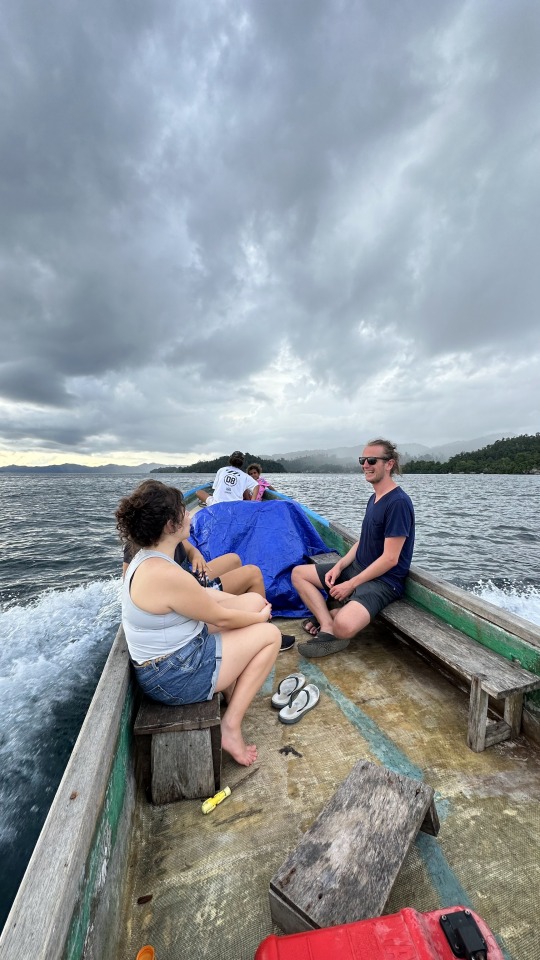
Photos Above: dive team ferry crossing; speed boat to our destination
The accommodation was very basic (the most basic Helen and Sam had yet to contend with) with a grass-thatched roof that leaked during the nightly thunderstorms and a bathroom in a separate building with a leaky pipe and distinct lack of flushing toilet. But it had a veranda with a full ocean view in front and a jungle full of lively bird calls behind. All that was missing was a hammock; within one day of being on the island I had successfully negotiated the use of the spare one from the local Divemaster trainee. We hung it up in the communal space, and with that I was declared the best sister-not-in-law around. Also quintessential for our stay turned out to be the vegan chocolate spread Sam picked up in a supermarket in Sorong –a ‘lifesaver’ (Etienne’s words) to accompany the breakfast of fried bananas, occasionally served on top of boiled bananas with a side of fresh banana (safe to say, the vegan memo was picked up by our hosts).




Photos Above: our bungalows; the dining 'room'; morning swim; golden hour
Diving Raja Ampat
We were quick to acquaint ourselves with the underwater world of Raja Ampat, which it’s fair to say, was absolutely drop dead stunning. The coral was colourful and abundant and life teamed everywhere you looked—not that I always found it easy to spot.
There were tiny pygmy seahorses the size of my fingernail and so camouflaged I could barely make them out against the pink coral. And there was a turtle sat under a rock, so big that Helen had to point twice before my vision was able to zoom out and absorb the scale of the creature. We saw electric clams flashing our torchlight back at us, and colourful urchins bimbling along on the sandy bottom. Tiny octopuses buried themselves in the sand, and orangutan crabs with spindly legs and covered in orange fluff wound themselves through the coral mesh. Black- and white-tipped reef sharks flitted in and out of the murky blue depths and two mobula rays flew overhead, silhouetted against the light of the surface. A bizarre looking wobbegong shark, looking like it’d been squashed by a roller, rested on a huge fan of coral. Huge shoals of fish encircled us as we hung weightless above the reef, watching the many individuals acting as one glittering mass.
youtube
Video Above: a few videographic snapshots of our (mindblowingly incredible) time in Raja Ampat, with huge thank yous to Etienne Cristini and Mario Kakante for letting us use their footage! And for being generally excellent humans. Music is "Daydream - Dance Remix" by Ash.
On one dive, I heard the urgent metallic tapping sound of Mario our dive guide tank-banging to get our attention, and looked over to see him literally dancing underwater—he had found a rare frogfish, coloured pink and green (and looking very much like coral to me), resting next to the reef.


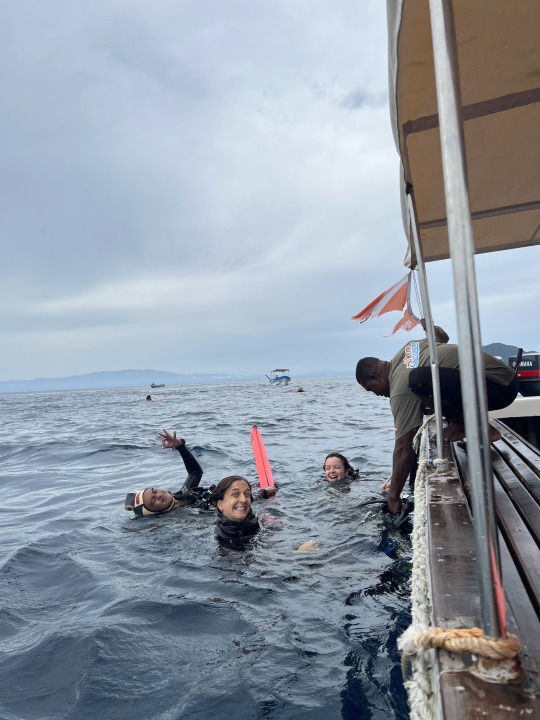

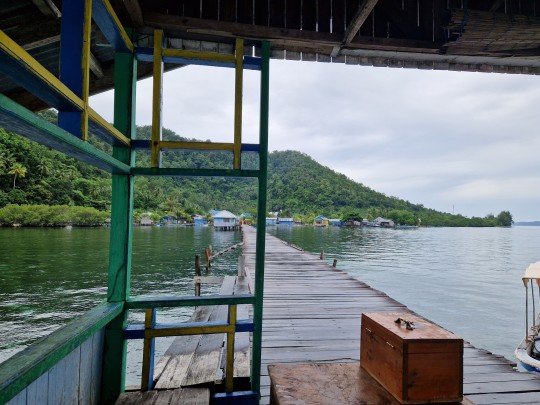
Photos Above: sisterly diving; coffee time during a surface interval; after a great dive; diving boat team; one of Raja Ampat's small villages
For those on Instagram looking to get an artistic flavour of diving Raja Ampt, I recommend Etienne’s excellent reel.
Is this the Real Life, or is this Just Mantasea?
The absolutely pinnacle of diving Raja Ampat had to be the mantastic moments with the glorious Reef Manta Rays.
My first interaction with them was on my second day of diving and involved dropping into the water on a section of reef called Manta Ridge—a cleaning station that mantas regularly drop by so that the fish that live on the reef can clean the manta’s skin. Once in the water there was a fair current, so we hooked into the rock and floated in place watching as a couple of mantas swept by us, one coming so close to me that I could feel its eye keenly observing and sizing me up.
A week later, feeling much more au fait with this whole diving thing, I requested a trip back to the mantas to absorb even more of them. Little could we imagine what waited for us.
Due to tidal patterns, we set off from the dive centre at lunchtime (an odd time to be heading out diving—normally you set off very early to be in for a chance at seeing mantas). Out in the water near Manta Ridge, we spot a few manta wingtips cresting the waves. We casually looked over—we’re in manta land so we expected to see a few on the surface. But, the more we looked, the more wingtips we saw. Was that 20, 30 mantas grouping together? Surely not, there would be no reason for them to be in a train like this. But there they were! Although itching to be in the water, we couldn’t dive in as they were swimming over deep blue through a strong current—a dangerous (and illogical) place to dive. Instead, we scrambled to put our masks and fins on and leapt into the water to float on the surface at the side of the manta train to watch many, so many mantas gliding in front, around and under us. I will happily admit I completely lost my shit at this point. I watched the back of two beasts receding into the blue, and turned around to find five of the creatures coming straight at me with their mouths open, feeding. My heart stopped, my jaw dropped, and I almost started to cry in pure awe.
Once the manta train had passed and the current swept us behind them, we clambered back on the boat and went back round for take two. Manta after manta after manta passing by—Helen later used GoPro footage filmed by Mario to estimate that there were 40–50 mantas. Un. Be. Lieveable.
After this experience, we descended down to Manta Ridge and hooked into the rock once more. Floating in the blue, watching the busy life of fish on coral reefs, I entered a meditative state, only to be interrupted by Helen enthusiastically grabbing my arm and pointing—enter mantas stage left! There were three males and one female who had swung by for a mantatory clean. Oblivious to the divers, they flew amongst and around us, one even hovering vertically and puffing out its gills right by Helen.
Fair to say, this was an experience to remember.
youtube
Video Above: the mantastic experience of snorkelling and diving with a whole load of mantas, GoPro footage courtesy of Mario
A Motley Crew
A wonderful band of people contributed to our time in Raja Ampat. In particular, I enjoyed finding my diving feet again under the guidance of Mario (divemaster and Rubik’s Cube extrordinaire) and whilst in the company of Etienne (who celebrated his 100th dive with us).
Our friend and fellow diver Bodhy nicknamed Helen the ‘Professor’ due to her seemingly inexhaustible knowledge of the underwater world. She would spend the time between dives answering all manner of questions from him and the rest of the diving squad on species of shark, behaviour of crabs, and how to determine the sex of mantas. And special mention goes to Anto also who we hope to see diving again, this time complete with a dive computer.
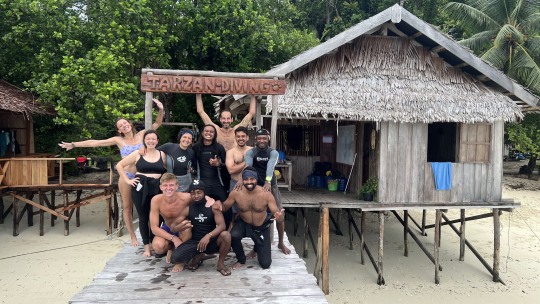
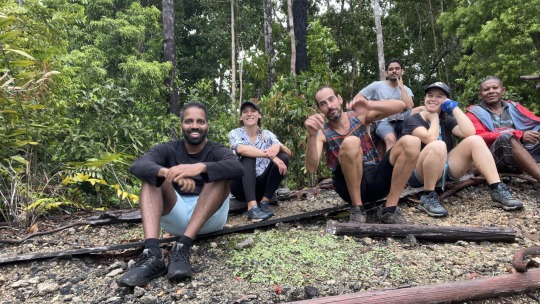
Photos Above: our lovely diving buddies; exploring the island's jungle
Meanwhile Sam became something of a legend at the dive shop (‘he planned a four-month diving holiday and hasn’t dived since week one?! *dramatic gasp* Oh my god I really feel for him’). Very understandably, he decided that after one week of hanging out in the hammock, his back needed some TLC and so took himself back off to civilisation for a massage and a decent hotel room.
Towards the end of our trip, our fellow travellers headed onwards to their next destination, leaving Helen, myself, and Mario to become something of a dream team both above and below water. I’d very much enjoyed having Helen as my own personal diving mentor and as time progressed, we developed a surprisingly fluid communication style whilst diving so that poor Mario still had to observe our incessant chatter even under the waves.

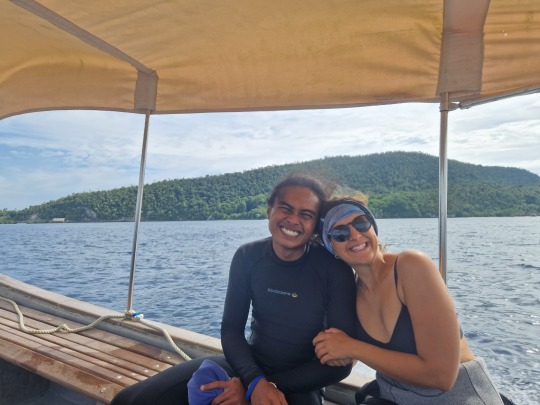
Photos Above: photobomber!; with our fab guide Mario
Onwards and Upwards
After 19 dives, our time observing the most diverse underwater ecosystem in the world was up. Helen and I packed up our kit and followed in Sam’s footsteps to be reunited with him in our next destination.


Photos Above: it's a hard life; so long Raja Ampat and thanks for all the fish!
2 notes
·
View notes
Text
Holiday Season on the High Seas
Our New Home
Happy New Year, dearest family and friends! And for those who celebrate it, I hope you had a lovely Christmas!
We last left off just as Sam and I were finishing our time in Alor. For the first time in our Indonesia trip, we had a hard deadline—on December 21st, we would be starting a liveaboard trip in the region of West Papua to explore Raja Ampat, a huge and famously biodiverse marine national park to the very west of Indonesia. This was the only thing we had booked ahead for the entire trip as it was one of our mega bucket list items.
Sorong, the city that the liveaboard trip would start from, is just over 1,000km as the crow flies from Alor. But as both Alor and Sorong are very remote, it was a case of patching together flights to make the journey work. This meant that Sam and I had to opt for a circuitous route of four mini flights across two days, travelling in a vast loop that covered three times the direct distance.
By the end of the final flight, I had noticed with some worry that I was starting to have issues swallowing, and by the time we reached Sorong, had one night to sort out our things, and then were picked up to start our liveaboard trip, I had completely lost my voice. Not excellent omens.
A dinghy took us out into the harbour, where La Galigo, our home for the next 12 days, was moored. She was a beautiful “phinisi” style boat, a kind of traditional sailing boat from south Sulawesi that had been converted to a) now be fitted out with motors, because otherwise there was no way we’d be able to make our long route around the marine national park, and b) run as a liveaboard boat. We were given a quick walkaround and shown to our cabin and it was clear immediately that she was a pretty luxurious boat for us, with wooden panelling all over the place, an air-conned restaurant area, our cabin on the deck above with several large windows looking out to sea, flushing toilets and warm-water showers, and a large dive deck at the back of the boat for prepping all the tanks and equipment. Its usual capacity was 14 guests (though our trip only had 9) plus a grand total of 17 crew members.
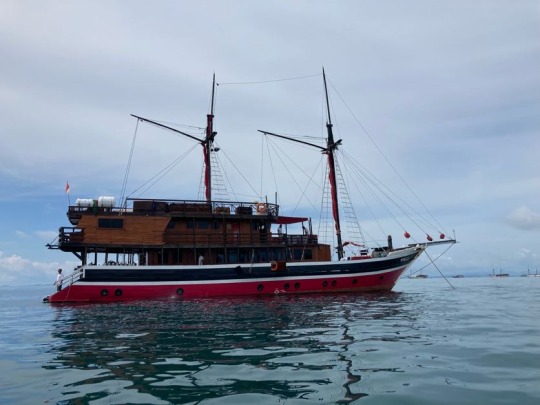
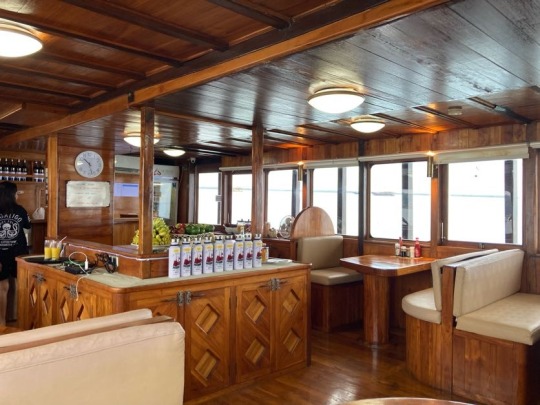
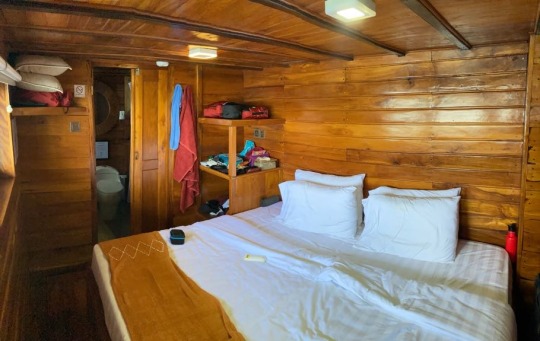
Photos Above: La Galigo; the restaurant area; our lovely cabin
The various guests slowly arrived and once everyone was on board, we slowly made our way out of the harbour as Fareez, the cruise director (i.e. coordinator, customer support, schedule planner, and general head honcho for the trip) introduced himself, and gave us a thorough briefing about the boat and the general down low on the rough outline of the trip.
Perfect Timing
That night I broke out in a full fever. It took me two days to shake it during which I was completely cabin bound (just sitting up hurt), with lovely Sam bringing me up food from the kitchen at mealtimes (though I was grateful that a covid test came up negative at least). By day 4 of the trip (Christmas Eve), I could leave my cabin and start to slowly move about the boat, just in time for a full Christmas Eve meal with all the guests and crew together in the restaurant area. The crew had decked it out in loads of decorations and the kitchen team made a huge effort with the meal so it was a joyful affair.

Photo Above: Christmas Eve dinner!
Though Sam and I had kept apart during the days, at night we had to sleep in the same cabin so even with the window open the whole time, it felt highly unlikely that he’d get off scot free. And indeed, on Christmas day he started feeling extremely rough and by lunch, he was in bed with a fever. And so now it was my turn to ferry up meals as Sam slowly recovered over the next few days.
Needless to say, neither of us could dive. I tried on one day somewhere in the middle of the trip and managed a couple of dives, but by the next morning, my ears had major problems and I realised I’d probably tried too early in my haste to get back underwater. There was absolutely no phone signal, which meant any external communication was out of the question (always lovely to have a break). Instead, I read for many many hours and enjoyed being on the boat itself, in the middle of the ocean, surrounded by little pops of tropical green as we navigated between the many islands. And whenever the dive site was suitable, I also snorkelled, floating over the vibrant reefs, or on one occasion, becoming a “manta drone” as I circled above a large manta ray who was herself slowly circling about 7 metres below me over a cleaning station on the seabed. Somewhere around day 8, Sam started to feel more himself and we could at least hang out together and have a good old giggle about how much of a farce our once-in-a-lifetime, bucket-list-level, most-expensive-holiday-ever trip was turning out to be.
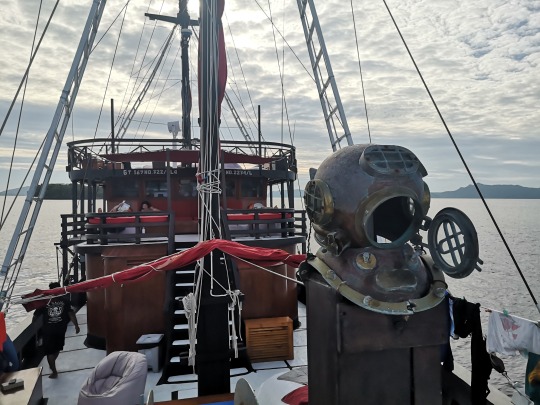
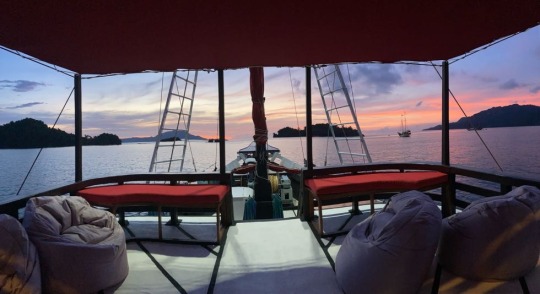
Photos Above: view from the front of the boat looking back; sunset on board
There were a few land-based activities that Sam and I could participate in. On Christmas day morning (when I had recovered enough to walk about a bit and before Sam’s fever had hit), the two dinghies took all us guests and some of the crew on a twenty-minute journey through a maze of islets called “beehives” for their steep, limestone pinnacles. We then did a 20-minute hike (although, it was more of a climb really) up one of them, pausing at the top for the stunning view—though it was pretty cloudy that day, the turquoise waters and islets were still a sight to behold.
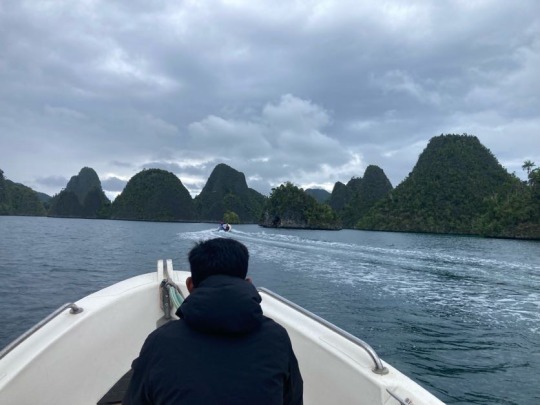

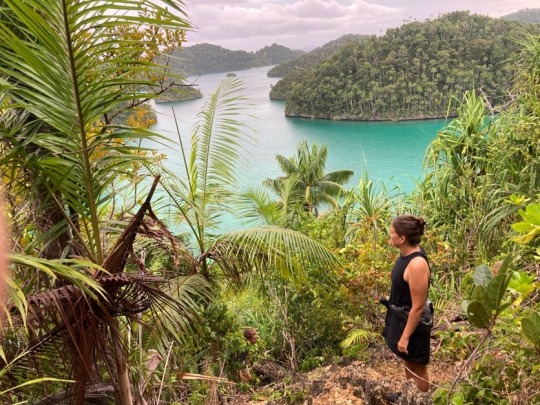
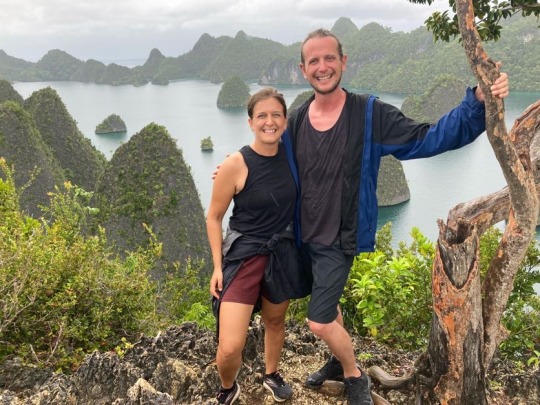
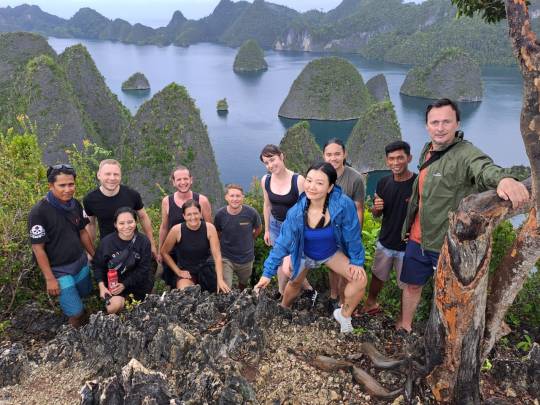
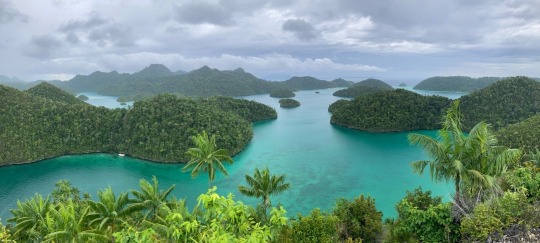
Photos Above: the boat ride to our hike; arriving at our chosen beehive; on the climb up; with Sam at the top; with some of the liveaboard guests and crew (photo courtesy of Sheila); the panoramic view
Later in the trip, we also paused on Pianemo island and did the boardwalk through the jungle to reach a panoramic viewpoint looking out across the ocean and surrounding islands.
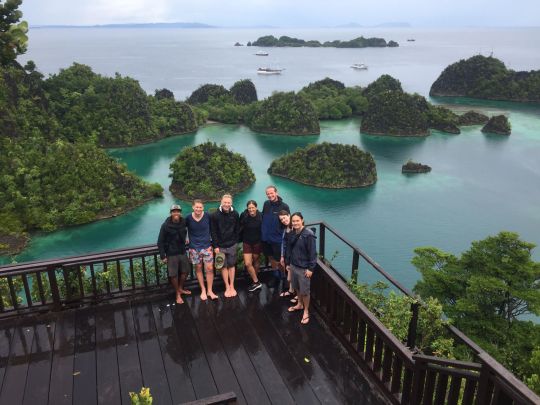
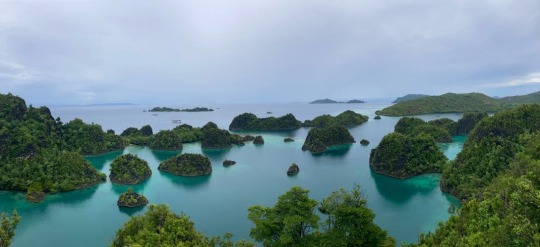
Photos Above: Pianemo viewpoint with Fareez and some of the liveaboard guests (photo courtesy of Fareez); the view
I did eventually manage to get in the water on our final two full days, so that by the end of the trip I had managed 8 out of the total 36 dives—not bad considering how ill I’d been. It was pretty wonderful to be a) almost back to full health (aside from a lingering chesty cough) and b) back in the beloved ocean. Even after only a few days not diving, it felt like a complete joy to be back underwater, and I saw my fair share of various reef shark species, vast schools of fish (barracuda, jacks, yellow snappers), and an amazing, diverse array of coral.
A couple of days from the end of the trip, the crew spent the entire afternoon ferrying items from the boat to a tiny islet called Mioskon, which was just a small pop of jungle with one beach. After the final dive of the day, all the crew and guests were ferried over to the island, where a barbecue was in full force, plus a full banquet table set up. While a bonfire blazed, we ate sat on long cushions on the ground at the low tables. It was an impressive affair and must have taken the crew hours to orchestrate.
In the afternoon of December 31st, we arrived back in Sorong’s harbour, ready to disembark the next morning—which meant that our very final evening on the boat was also New Year’s Eve! In contrast to our disappointment of Christmas, NYE turned out great. After dinner, the entire (always extremely smiley) crew filtered into the restaurant area and did a super fun performance of a number of Indonesian folk songs. By 9pm (when all the guests were usually in bed after a long day of four dives), Sam pulled out a bottle of rum that he had thought to pick up in duty free, and we shared it with the three other guests who had stayed up plus Fareez, our cruise director. After several hours of chatting and laughter, we all made our way to the top deck of the boat to watch the new year roll in. And what an absolute spectacle it proved to be! For several hours before midnight, a fair few fireworks were consistently going off, but at midnight they increased in fervour, so that suddenly all around the harbour there were more than 100 separate firework displays happening—the scale of it was so mind boggling that we hardly knew where to look and stood transfixed turning around heads side to side. Added to this, boats across the harbour began lighting flares that shot up as red sparks into the sky, curving down over the water to be extinguished by the black-dark sea. Who would have thought that a remote city in the far west of Indonesia would be so crazy about fireworks! They didn’t abate for a full 40 minutes, easily the longest and showiest display(s) I’ve ever seen.
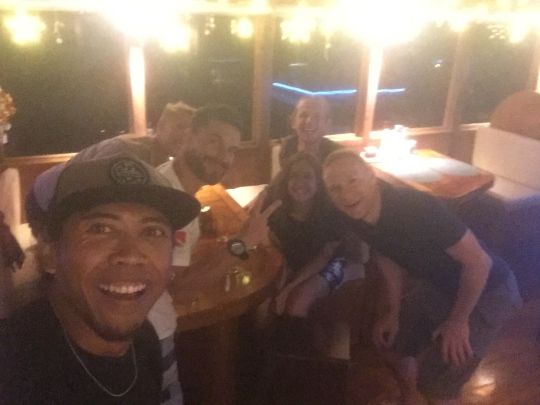
Photo Above: customary blurry New Year's Eve selfie, with the midnight crew (photo courtesy of Fareez)
On New Year’s Day, we disembarked the boat and spent the rest of the day catatonically tired and therefore not doing much except getting used to being back on land (you’d think this would have been more exciting but turns out we both love being on boats, even when we’re ill). And after all, it wouldn’t be long until the next adventure—my sister Jo was set to arrive the very next day!
1 note
·
View note
Text
Wonder and Splendour in Alor
The Calor of Alor
After we disembarked from the Komodo liveaboard boat, we spent a few days in the national park’s port town of Labuan Bajo, sorting out various logistics. Sam went to a doctor to check whether there was any progress with his ears (improving but still not right) and we lost a whole day to booking onward flights because the airline’s website made it near impossible to book flights within 48 hours of leaving. Eventually, we had to book the flights at the airport itself a few hours before departure—having previously joked about who on earth ever just turns up to the airport without a ticket!
We had selected the remote Alor Archipelago as our next destination, 750km east of Labuan Bajo. We had heard tell that because of a lack of tourism infrastructure and therefore few visitors, the diving there was knockout. Two short flights and one night transiting in a different city later and we were touching down on the island of Alor itself.

Photo Above: an aerial shot of the gorgeous land, islands, atolls, and reef
An hour’s taxi ride took us from the airport along a coastal road that ran alongside the large Kalabahi bay, until we reached the village of Alor Kecil. From there, it was a five-minute boat ride across a short stretch of water to reach Kepa, the very small island where our accommodation was located.

Photo Above: the boat ride over to Kepa island with our luggage
A moment for some wider context. The Alor Archipelago is made up of two larger islands (Alor and Pantar), five smaller, and numerous outcrops. The vast majority of the total 210,000 people of the archipelago live on the two larger islands. There is only one single town, on the island of Alor, and otherwise, all residents live in numerous villages dotted about the islands. A whopping 56 different languages are spoken across the archipelago, with 70% of its residents being Protestant and 20% Muslim. There barely any restaurants outside that one single town on Alor, very few accommodation options, and just six dive shops in total. The island we were staying on, Kepa, is home to 75 permanent residents only. We were staying at Marangki, a mini complex run by a lovely man called Harris, consisting of 4 bungalows and a dining hut. Our wooden bungalow had a wet room (with flushing toilet and shower, but no sink), bedroom (consisting of the bed with its mosquito net and a wardrobe), and veranda. The island has no electricity (so a generator was run for two hours each evening to allow us guests to charge electronics) or fresh water (every day, water was brought over in a number of large jerry cans from Alor on a boat and added to a huge water tank that fed our bathrooms).
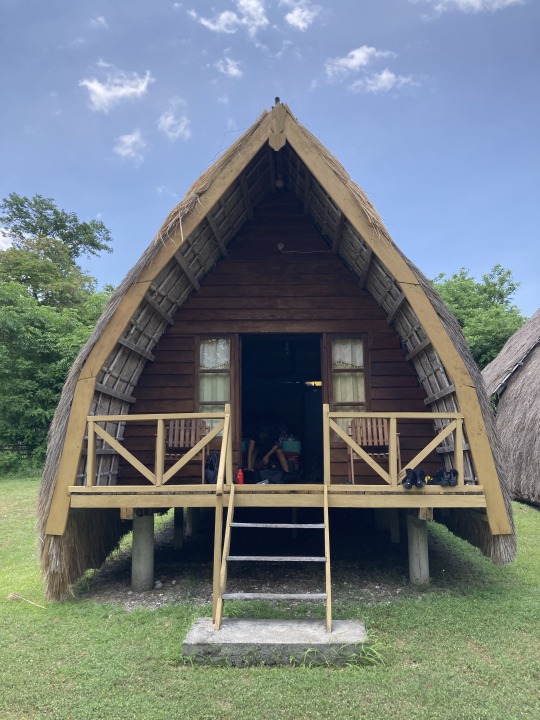
Photo Above: our bungalow!
The view from our veranda was stunning, looking down a short slope with several Flamboyan trees in full, bright bloom (also called December trees because their gorgeous red flowers only appear for a couple of months a year, just when we were there), across the bay to Alor Kecil on the other side. Within ten minutes of arrival, we saw a pod of dolphins curving through the water right in front of us—an excellent welcome all round. We also realised that as boats are the far more common form of transport (what good are land-based vehicles in an archipelago??), there was always something to see and as it turned out, hear—most of the boats had a cheap type of engine that was so loud and choppy that it sounded exactly like a helicopter landing right on the banks next to us (at all times of the night too, oh joy!).


Photos Above: the view from our bungalow; the view from one of the seating shacks of the ocean and the village of Alor Kecil
We met Tamar and Nico that first day, the dive instructors and new owners of Lazy Turtle Diving. Having worked in the dive industry for years, they had bought the dive shop just six months previously, taking over from the previous management, and so were pretty new to the area. Over the next few days, I quickly learnt that Nico had worked in diving for a solid 15 years, had quite a number of predominantly marine animals tattoos, and in his spare time liked to unwind by crocheting (while we were there, his ongoing project was the creation of a pair of SOCKS in the shape of SHARKS. Need I say more). Tamar was really welcoming, had fantastic life anecdotes (including cycling half the world in just under five years…), and was a complete whiz at repurposing and upcycling all manner of materials via her own crafty solutions—bike tyre inner tubes became dive mask straps, a beach ball in the shape of a globe became a handbag, plastic washing up liquid sachets became mobile phone pouches and purses. Both of them were so completely in love with diving, and especially the underwater wildlife, that they made for a fantastic guiding team.
The Remote Life
Our days quickly fell into a pattern. We’d be eating breakfast by 7a.m.—all our meals were cooked for us, given that all food supplies had to be shipped from Alor. We ate with the other guests in the dining hut, but as we were there right at the end of the season, there were only ever a maximum of two other guests. At 7.30, Tamar, Nico, and Jimen (the captain), would be waiting for me in the Naughty Nudi (their excellently named dive boat) on the shore right in front of our bungalow. There were more than seventy dive sites within 20 minutes, so we were never short of choice. We would zip our way through the sea, tracking our way amid the islands to our dive site of choice, often right in front of a village on one of the small islands. All the villages seemed divided by religion, so there would either be a disproportionately large church or a disproportionately large mosque perched on the hill overlooking the water. Lazy Turtle Diving have an ethos of only diving in small groups so there were very rarely more than a couple of other customers besides myself. They also have a great ethos of finishing the dive based on air consumption and not time—it’s far more usual in the dive industry to finish a dive at 60 minutes (as long as you haven’t hit 25% or less of your tank beforehand), so because I have decent air consumption this meant we often had 70–90 minute dives. We would dive twice in the mornings, with an hour’s surface interval in-between, and then be back at Marangki in time for lunch at 1pm. I often went out for a third dive after lunch, which was always a “muck” dive—a type of diving on the sandy, rubbly bottom of the sea (as opposed to full blown reefs), usually at a very slow pace and with a torch to find the incredibly weird and wonderful critters. Then once back at Marangki after the third dive, I’d enjoy the dense heat of the afternoon and the consistently noisy “helicopter” boats passing by with a nice strong coffee from the dining hut, and hunker down to fill in my logbook (the record for all my dives), have a catch up call with friends or family from home, or do logistics planning with Sam for the next section of our trip. At 5.45pm, the calls to prayer from the mosques across the water in Alor Kecil would start up. The mosque that Sam and I fondly named “Disco Mosque” (due to its shiny silver dome and four smaller, rotating silver minaret domes) would always lead the way with a very melodic call, quickly joined by the call from the very large mosque a few minutes up the hill from disco mosque, which made up for an intense lack of tunefulness with its extremely loud and low-quality speakers. And finally, the third mosque, just along the coast, would join in to complete the clashing trio for the next 45 minutes. I loved the call to prayer, even including the 4a.m. round, which I was almost always awakened by and lay listening to in bed before drifting back off to sleep. Not long after the evening call to prayer, we would have dinner, relax a bit more by the water, and then be in bed by 9.30pm. Without a fan, the sizzling heat of our first few nights there made sleeping pretty difficult (I tell a lie—I found the heat pretty delightful, but all other guests seemed to have a hell of a job sleeping). Considering we were visiting right at the end of the season just as the rains were coming in, we got really lucky with the weather. We experienced a week of sizzling heat, then the odd occasional shower began to creep in, and then a full day of rain on my very last day out on the water.
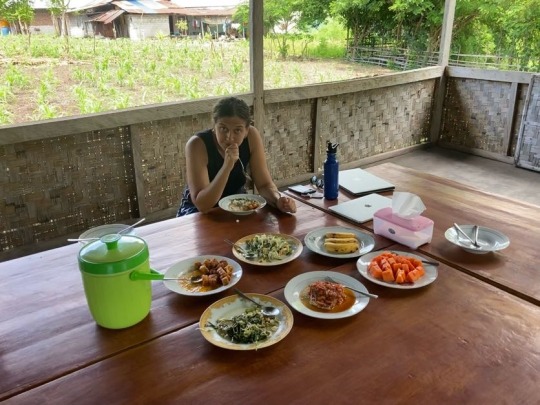


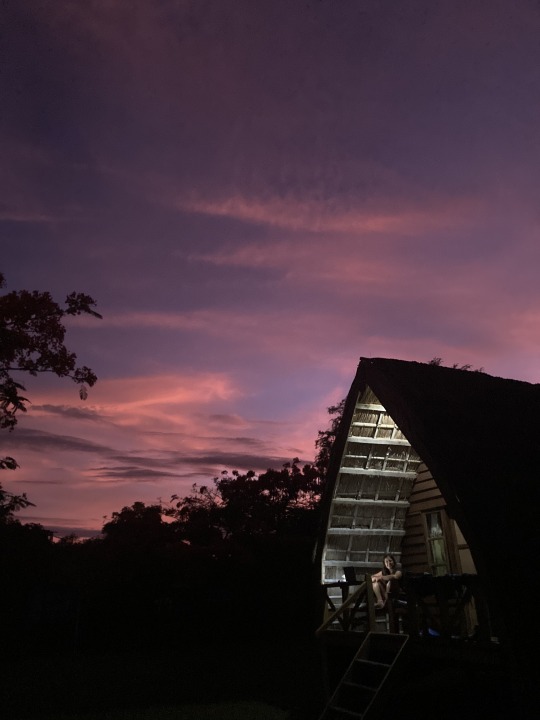
Photos Above: the dining hut with one of the amazing spreads; disco mosque; the beautiful island of Kepa; a sunset over our bungalow
We were hopeful that Sam would be able to dive by the end of our eleven days in Alor, but it wasn’t to be—although his ears eventually began to feel a bit better right at the end, they were never good enough to dive. Instead, a wonderful thing happened for Sam. In being cut off from electricity, and with very little to do or achieve, he slowly settled into a very present and enjoyable kind of experience. He often did yoga on the veranda, joined us on the boat for a couple of mornings to snorkel, and took his camera out in the water right in front of our accommodation a few times too. But most of the time, he sat on one of the wooden seating “shacks”, as he called them, in front of the water and just watched the world go by—the boats passing, the numerous dolphin sightings, the water flowing with its heavy currents that changed constantly throughout the day.
Video Above: Sam managed to catch one of the dolphins (probably Spinner Dolphins) backflipping!
I found the diving around Alor completely incredible. The marine park contains easily the most pristine reefs I’ve ever seen, with such an incredible variety of corals, marine life, sponges, you name it—at several sites, I saw barrel sponges the size of cars and individual table corals (large, flat coral) far larger than a king’s size bed. Though the currents could be incredibly changeable and speedy at times, I also did plenty of dives with no current or only a very gentle current drifting us along slowly, so that we had plenty of time to peer at all the macro life on the reef. There was a great variety of diving, from shallow reef dives, to huge drop off walls that filled you with awe and wonder at the sheer topographical beauty, to fantastic muck diving. We did one dive where we saw volcanic gas bubbling out of the sea bed at just a few metres; on another, there was a vast wall that both rose out above the surface and dropped down underwater in dramatic curving swoops to who knows how deep and was teeming with so much life that I could barely take it all in.



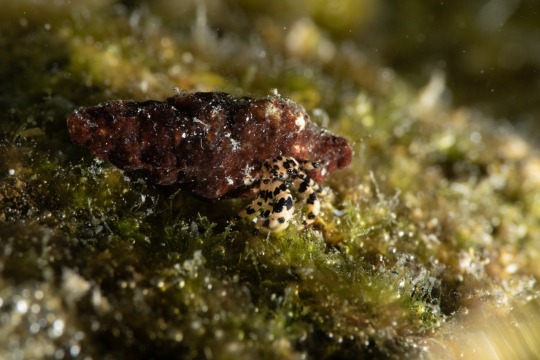



Photos Above (all courtesy of Sam's camera skills while snorkelling): the volcanic gases bubbling up from the sea bed; the teeming reef; a hermit crab; our diving group below the water, just about to ascend (hence the neon red surface buoy); a shot of me just as I'm about to surface; a snorkelling selfie!
I also did a spectacular cavern dive that was particularly special. Tamar and I descended to the reefy bottom at about 12m and entered a cavern (the important distinction between a cave and cavern—with cavern diving, you can always see the light from the entrance). As it’s been more than two years since I last cavern dived, I’d forgotten the amazing feeling of being suspended within a cavern, perfectly held between the floor and ceiling by the water—plus I always love looking back at the entrance and seeing the black framing silhouette of the cave’s entrance surrounding an oval of vivid blue light. It’s always fascinating to see the creatures that live in a low light environment, from the brightly coloured coral (think neon pink stems with vivid yellow fronds) to a glowing orange sea cucumber. Tamar showed me these brown, almost leathery looking sacks hanging from the cave wall, each about the size of my palm and often several grouped together. She held her torch behind each one, careful not to touch it, and it glowed orange, showing the yolk within. A couple of the eggs even had something flickering around the yolk, undulating side by side in the classic movement of a fish spine—they were the tiny offspring of a bamboo shark!
We slowly made our way around the cavern and back out, then swam a short distance to another cavern. After we had swum a short way in, we did a safety stop (the diving practice of pausing at 5m for 3 minutes when ascending, to greatly minimise chance of decompression sickness), and then completely ascended, coming out in an air pocket—but when I say air pocket, I mean quite a large, cavernous space (though we kept our regulators in our mouth most of the time as the air quality may have been questionable). We spotted a Banded Sea Krait, a type of sea snake on the rocks close to the water’s edge, banded black and blue. After we’d peered at it for while, we descended back into the underwater section of the cavern and swam towards the back, then turning off our torches. The water around us lit up with flashes of blue from Flashlight Fish, which have bioluminescent stripes on their cheeks that they can turn on and off. I felt like a kid who just kept wanting to stare and stare. The whole dive felt like quite the adventure.
On one special morning, as we were travelling the open water between our two dives sites, we spotted a pod of dolphins. Our boat slowed and moved towards them, and they must have realised we were there because they surrounded us. They zipped through the water, following the bow of the boat, leaping fully out of the water in great curves around us and moving so fast that they were just wavering grey shapes in the blue. Another dive boat that was also passing joined us, and for a solid ten minutes, our two boats and the pod moved back and forth together, the entire pod of dolphins circling back around several times to keep moving alongside the boats. I tried getting a sense of how many individuals there were—definitely a minimum of 50, but probably nearer 100!
Besides Harris, Tamar, and Nico, we also met some great people in the other guests at Marangki. For our first few days, there was Jeannine, a 70-something American who has been diving all over the world for the last 40 years and spends at least 4 – 6 months of every year outside the States, travelling and diving. As you can imagine, she was a wealth of diving knowledge, and a flipping interesting person to boot. And then for our last few days, there was David (northern English) and Stu (Kiwi), two international school teachers who had lived in Indonesia for more than ten years and had a load of local knowledge and fascinating anecdotes.
It wasn’t all perfectly idyllic. On one dive, we heard several explosions that vibrated through our bodies and realised that it was illegal dynamite fishing. This is exactly as it sounds: lobbing dynamite in the water to kill everything within radius with one mega explosion, decimating the reef and indiscriminatingly killing all life. Though it must have been not all that close to us (if it takes place within 1km underwater then apparently your whole body shakes) so we weren’t in any danger, but looking around at the reef, including sponges that were easily several hundred years old, it felt like a vast, painful loss.
And one day, when Harris was away visiting his family on Alor and Sam and I had been working on our laptops in the dining hut, I walked the one minute back to our bungalow to interrupt a man in our room who had, it became clear afterwards, just opened the wardrobe to start going through our things (my immediate thought was that he was obviously in there for a legitimate reason, such as fixing something in the room, so I actually exclaimed “oh, sorry!”). He immediately ran and I was left staring at the things he had been riffling through, which were RIGHT next to where our passports wallets, fully intact, were kept. Somehow, he had taken absolutely nothing. A sign from the universe that no matter how close we are to our room, we had to be better at always locking up.
But these were tiny downsides amid an incredible couple of weeks. Though we’d each had a very different experience of the place, we knew that we had found something really special. And given the tales we heard of developers buying up portions of land in the area, we suspect we got to experience the glory of Alor just in time.
2 notes
·
View notes
Text
Manta Magic
We will shortly be adding an update about our last few weeks, but first we wanted to share with you all a (spectacular, in my humble opinion) video of our manta ray experience in Komodo National Park that Sam has been beavering away on.
A few wee pointers before you watch the video. Firstly, you’ll spot me frequently in the footage—if in doubt, I’m the one with the large, flappy blue fins! Secondly, all this footage is in real time, i.e. Sam hasn’t slowed down anything (manta rays just swim that gracefully and slowly). And finally, we’d highly recommend watching this with the sound on, as Sam has beeeautifully timed the entire thing to music!
youtube
1 note
·
View note
Text
Dragons and Mantas and Sharks, Oh My!
Adventure Ahoy!
Though sad to be leaving Bali, we felt a real sense of excitement to be moving on. Through some form of magic (otherwise known as excellent organisational skills), Sam sorted us a 6-day/5-night liveaboard trip into Komodo National Park on a boat that usually takes four guests but, because it was the final week of the season, he bagged the trip for just the two of us for no extra cost. Sidenote for non-divers: a “liveaboard” is a boat with an air compressor, thus allowing for tank refills without the need to return to shore. This cuts out journey time so that you can do several dives per day while journeying through often remote regions that would otherwise be pretty inaccessible for diving. This was the first time Sam and I had ever been on a liveaboard trip.
This is all to say, within a few hours of arriving in the port town of Labuan Bajo on the island of Flores, 700km east of Bali, we somehow ended up on our very own private charter!
A dinghy took us out to where the Busy Girl, our home for the next six days, was moored. She is a compact former-fishing boat, hence the unusually small capacity of just four customers. We were introduced to the crew for the trip—Yunus, our dive guide; Suhar, el capitan; Herman, the engineer; Yoris, the cook; Fian, the dinghy driver; and Grace, a 17-year-old student doing an internship as part of the tourism course she’s studying). And to point out the potentially obvious, a ratio of six crew to two customers is extremely luxurious!
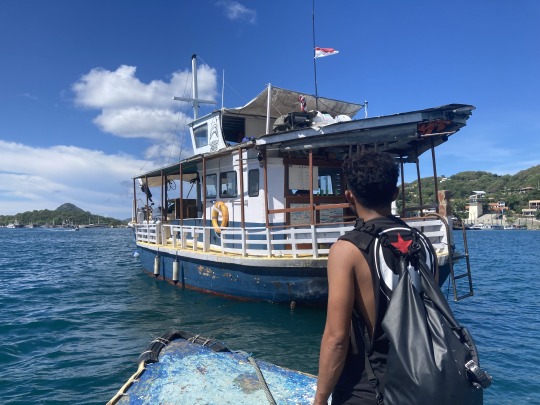

Photos Above: arriving at the Busy Girl for the first time; setting sail from Labuan Bajo's port
We left Labuan Bajo port midway through the afternoon and chugged straight for our first dive site, heading west into the national park. The surroundings were immediately stunning, the water punctuated with green islands here and there. They didn’t look tropical at all, more like very steep, dry moorland peppered with the occasional tree.
The biggest disappointment of the trip was the fact that Sam still couldn’t dive—he joined Yunus and myself for one dive partway through, but it wasn’t at all comfortable for his ears and he could tell they hadn’t healed fully, and so had to sit the rest of our dives out and instead often snorkelled the same sites.
Nonetheless, we quickly settled into life on the boat and ended up having a fantastic time. Given that I was doing three dives a day, the schedule felt pretty jampacked, with most of the time between 6.30a.m.–4.30p.m. each day spent prepping for diving, diving itself, and eating our freshly cooked meals in between. That said, living on a boat was hardly a tough life as we didn’t even have to sort out our own dive gear or cook our own food. So there was plenty of time for napping, drafting up my diving diary, digging deep into the reef fish and creatures identifications books on board, and relaxing on the deck as we glided through the beautiful national park. It was quickly apparent that Yoris was an excellent chef, serving up dishes such as crisp chilli tempe, tofu and caramelised onions in a sweet bean sauce, fresh green beans and beansprouts, various noodle creations, and battered aubergine pieces, to name just a few of his creations. And given that scuba diving is pretty heavy cardiovascular exercise and I was doing three hours’ worth in a day, I devoured Yoris’ creations with great keenness.
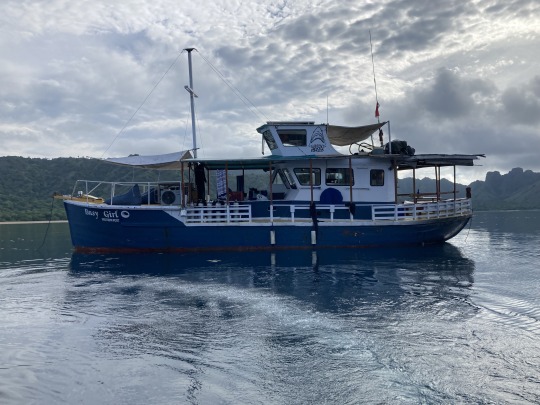
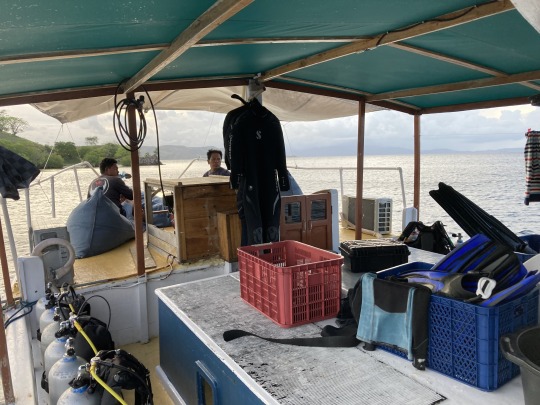

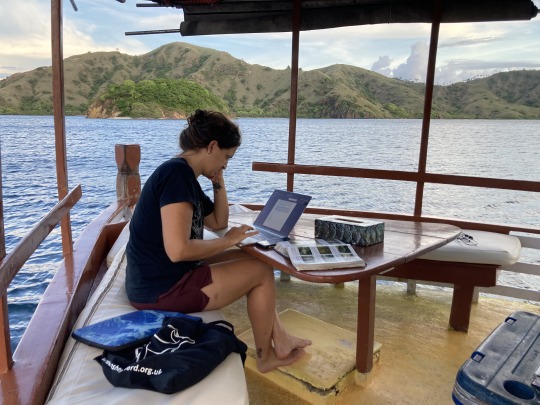
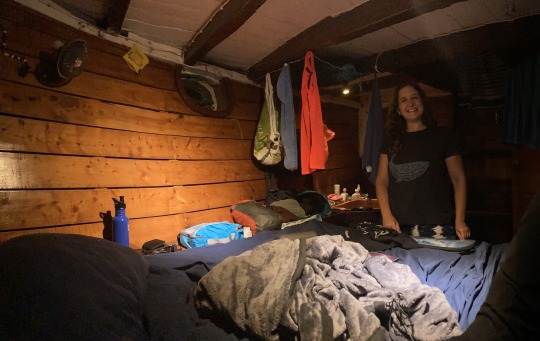
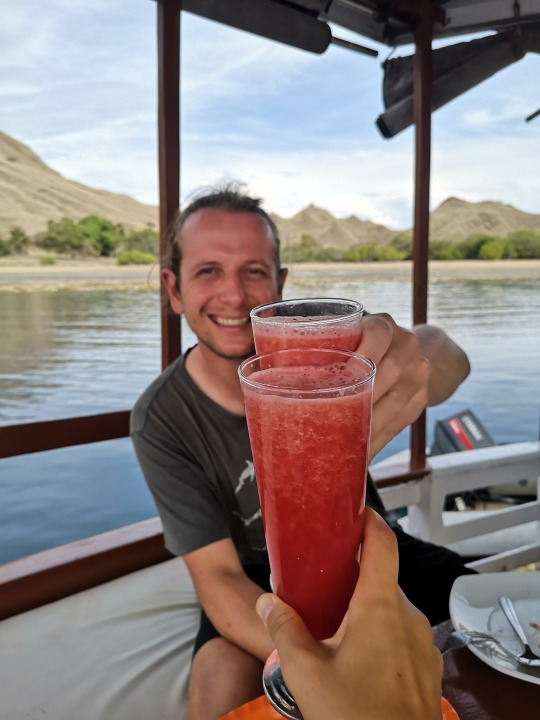
Photos Above: Busy Girl in all her glory; her dive setup area and front deck; the kitchen; me studiously working away with the reef identification books at the back seating area; our cabin; fresh juice in the mornings!
Over the course of the six days, we zigzagged our way around the north and central sections of the national park. We were incredibly lucky with the timing and weather. As it was the right at the end of the season, we saw very few other boats (usually, it’s roughly 15 boats moving around together), and I only saw other divers at 3 out of the 15 dive sites. We also only had a couple of hours of rain during the daytime in the entire six days, despite the fact that it’s the rainy season and it apparently rained heavily the previous week. What luck!
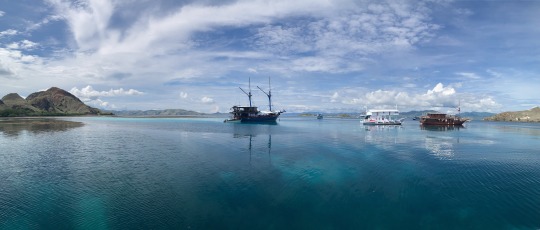
Photo Above: one of our mooring spots on day 2, amid the beautiful scenery
Though I kept a (far too fulsome) diary of every dive, as well as notes on other exciting events that happened on the trip, I suspect that reading a detailed account of fifteen individual dives might not make for the most fascinating read. So with this in mind, I’ve put together a condensed “Best Of” for you all below!
Day 1
Dive #1: Sebayur Kecil
We entered the water doing a front stride entry from the Busy Girl. Sam wasn’t able to descend with us, his ears not clearing properly so he almost immediately resurfaced, and Yunus and I continued. I was immediately struck by how different the reef was compared to all my recent dives around Nusa Lembongan and its sister islands, with a completely different variety of corals and colours. Alongside generally marvelling at all the fish life, we saw two Green Turtles and a Blacktip Shark also cruised by a couple of times. We were picked up afterward by the dinghy with Yunus instructing me to unclip my dive gear and pass it up first and then jump up into the dinghy “like a dolphin”. I think I may have quite a way to go before any dolphin will be accepting me into their pod.
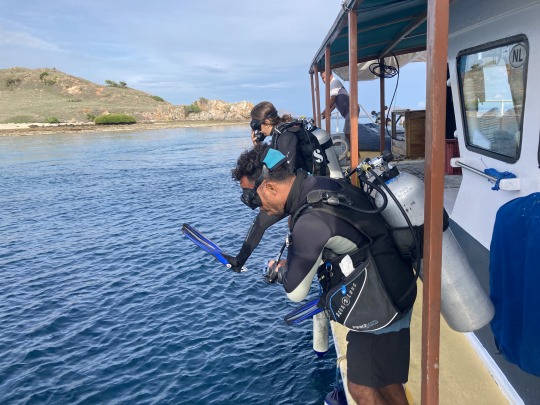
Photo Above: front-stride entry into the water from the Busy Girl
Day 2
Dive #2: Tatawa Besar
We were in the water by 7a.m. As a perpetually hungry person, I wondered what diving before breakfast would be like—turns out it’s a delight. Nothing quite like an hour in the tropical 29 degrees water, floating amid the coral and fish life to work up an appetite. And what a dive it was! The first third of the dive was hard work, with a strong downcurrent meaning that we had to constantly kick upwards. The reef was mostly made up of purple-grey sponges and green and yellow soft coral. The current began to ease and we zigzagged back and forth for the rest of the dive slowly getting shallower with each zig and zag. We saw several Green and Hawksbill turtles, foraging, resting, and going up for air. We also saw a huge cuttlefish, maybe half a metre long, flashing like a disco ball—they rapidly change colour both as a camouflage technique and to warn off potential predators so I wonder what we registered as. And then Yunus suddenly excitedly pointed upwards towards the shallow edge of the reef and there was a Reef Manta Ray gliding by! For the rest of the dive, two individuals glided back and forth around us—at one point Yunus turned toward me and his eyes widened in surprise as one of the mantas glided over my head with me completely unaware until the last moment. As we did our five-metre safety stop for three minutes (standard practice for every single recreational dive), the two mantas were feeding at the surface, circling right by us even as we also surfaced.
Dive #4: Golden Passage
This was the first dive that we didn’t enter the water straight from the Busy Girl—Fian took us out on the dinghy to the passage between Gili Lawa Darat and Komodo, where the narrow strait creates a strong current and acts as a sort of funnel for marine life in the area. I noted while underwater that this dive felt a bit like an orchestral overture, with distinctly different movements, changes in pace, and definite flourishes as the topography, coral, and marine life changes throughout the dive. It began with an intense crescendo when Yunus spotted a school of mobula ray fly past only a few minutes after descending (I counted eleven altogether!). Then things were legato for a while as a very light current gently drifted us across a sandy bottom peppered with corals and sponges here and there. As we followed the curve of the seabed around a corner, things began to get even more exciting when the current seriously picked up exactly as another school of mobulae swam by, so that we both hooked a finger into rocks on the seabed so that we could watch them swim by. Shortly afterwards, the seabed dropped away into the blue as the passage between the islands became much deeper and we followed the sloping reef for the rest of the dive. The reef was now intensely colourful, with purple, red, yellowy-green, and blue branching corals amid fan and mushroom corals (I sound as though I know what I’m talking about but I’m pretty sure I’ve made up the names of some of these types of corals). Schools of tiny silvery fish, the size of the circle of my finger and thumb together, floated above the reef like shimmering, buoyant confetti. Just as we did our safety stop, we spotted Sam snorkelling above us. He told me that he had been hanging out with a juvenile cuttlefish for ages, which apparently seemed wholly unfussed about his large presence near it.
Whales!:
We’re just back on the boat after an incredibly exciting hour. Just after showering after the final dive of the day, two national park staff pulled up to Busy Girl to check our paperwork. They let Yunus know that blue whales had been spotted very close to where we surfaced after our last dive just over an hour ago and that they were still around. We immediately pulled on swimsuits, jumped into the dinghy with Fian and Yunus, and headed out into the bay. Within minutes, the whales surfaced, and we could see their backs curved through the water and sprays of water shoot into the air as the exhaled through their blowholes—I’ll admit I was very close to tearing up with happiness. My first blue whales! We spent a full hour following them in a large loop around the bay—with not one single other boat around—and realised that there were three individuals, one of them likely a calf I would guess, based on its smaller size. They surfaced time and time again to breathe, gliding so gracefully that their tail flukes arced through the air behind them. A few times, we tried to jump into the water with our snorkels a short distance in front of where they last surfaced, but every time they were far too fast for us to keep up. Nonetheless, it was an exhilarating, beautiful experience. As we headed back towards the tiny bay where the Busy Girl was moored, the sun was setting behind the islands in front of us, a beautiful, final moment to round the experience off.
Video Above: video credit to Fian, who managed to drive the dinghy at speed at the same time as capturing this video, as we all realised that there were in fact THREE blue whales surfacing less than 50m away from us
Day 3
Dive #5: Castle Rock
That was a crazy dive! Yunus briefed me beforehand about the site and its conditions. As it’s a huge pinnacle rising up out of the seabed until very close to the surface and often has strong currents, the dive had certain technical challenges. Usually, you enter the water with your buoyancy control jacket (BCD) inflated so that you can bob at the surface checking everyone is okay and then all descend together. But for sites with strong currents, it’s safer to do negative entry, rolling backwards off the boat with your BCD deflated so that you drop straight down, ensuring that the current doesn’t zoom you away. As soon as we had done so, battling our way down against the current until we were at about 20m, Yunus then hooked me in with a reef hook (my first time using one), a metal claw that you hook into the rock, connected to a coiling spring that you clip to your BCD, to help keep you in place in areas with high current.
Once we were both hooked into the rock, facing outward into the current and away from the pinnacle, we spent the majority of the dive hanging out in that exact same spot, skydiving through the current streaming at us and watching the seascape in front of us. It was a exhilarating feeling! There were vast schools of Bluestreak Fusilier flashing silver and iridescent violet-blue, and Sergeants striped yellow and black, and gliding among them I spotted a grand total of eleven Whitetip Sharks, several of which were pregnant—including one female that had an almost incongruously huge belly (she was obviously my favourite).
Dive #7: Cauldron (aka Shotgun)
This was one of those dives that really felt like we’d gone on quite the journey. The dive site was in the passage between two islands and is also known as “shotgun” because of the strong current right in the middle of the passage. We dropped down quite close to one of the islands and slowly swam over the sandy bottom, past two Whitetip Sharks chilling at the bottom (they lie on the seabed facing into the current so that they can breathe as the water passes through their gills) until we came to the reef. Yunus spotted FOUR pygmy seahorses amazingly camouflaged as the exact same colour and texture as the little polyps on the purple coral fan that they had made their home. They were absolutely miniscule, about the size of a fingernail, and clung onto the fan with the little curl of their tails.
As we continued to swim, the current picked up and almost like a light switch it became incredibly strong. Yunus hooked me into a large rock on the sandy bottom with the reef hook and I lasted about 30 seconds before the entire rock actually flipped in the strength of the current and we decided to take that as a sign and that rather than hanging out there for a bit we should just enjoy the ride. So we sped along in the current until Yunus signalled for us to swim out of it to the nearby reef, where we zigzagged back and forth for the rest of the dive over the reef.
Sam snorkelled along a very similar route as us and managed to see not only two passing mobula ray but also two separate manta rays that swam close by as they passed him!
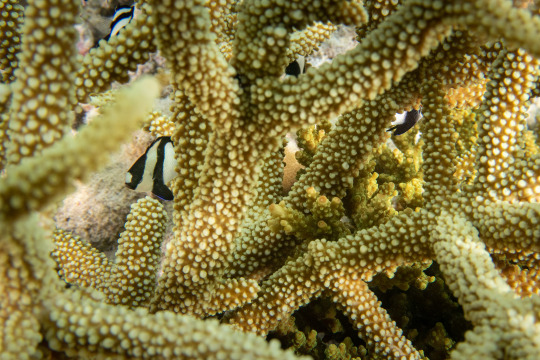
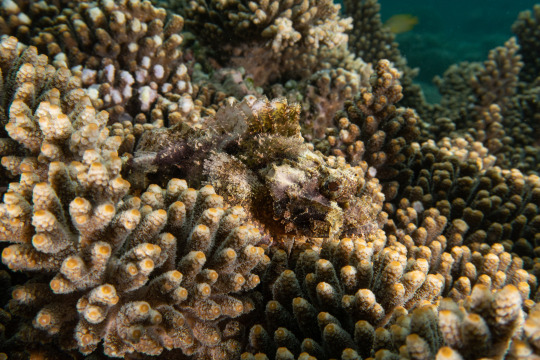
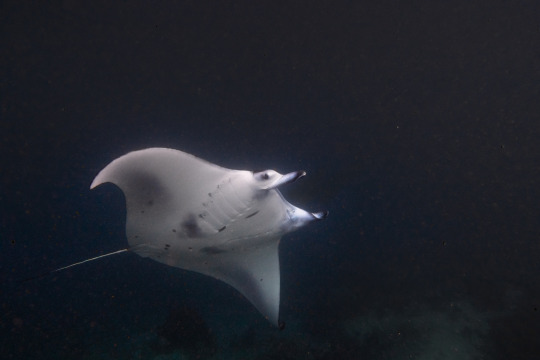
Photos Above: a damselfish hiding in branching coral; spot the stonefish!; Sam snaps one of the manta rays as it does a flyby
Day 4
Komodo Trekking:
Good news: we got a lie in until 7a.m.; bad news, the boat needed to start moving at 5a.m. to get us to our first stop on time, so of course by half 5 I was up on deck watching us glide along in the morning light.
At 8a.m. we moored up in a bay and the dinghy took us to the pier. On land (very weird to be on solid ground after a few days on the boat), we met a national park guide who took us on a mini trek to see the Komodo Dragons. As it was early morning, he suggested we start by the beach as they like to go sun themselves early. And sure enough, we immediately saw a huge male sitting amid a few logs on the sand (by which I mean Sam and our guide saw it immediately, whereas I only avoided stepping right on it thanks to the panicked cries of our guide…). Apparently the guide could tell it was male as it was a rusty red/brown colour (the females are more yellowy) and larger than females typically are—this one was easily 2m long. Komodo Dragons have quite the reputation—they can smell blood up to 7km away and kill their prey by biting and then allowing the fatal bacteria in their saliva to kill the animal slowly but surely. This is to say, they are exceedingly patient. They eat any meat, both carrion and prey, and as the island has buffalo, wild boar, and deer, there is plenty in supply—and though they eat about 80kg per sitting, they only need to eat once a month.
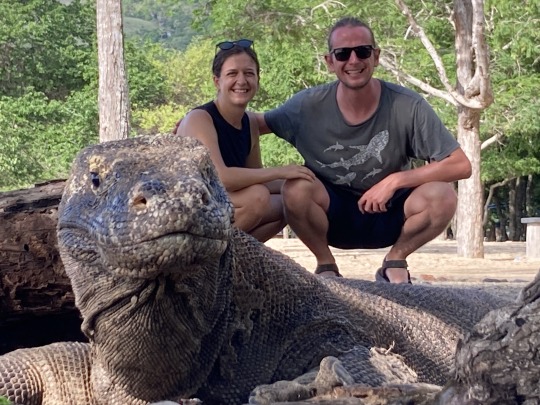
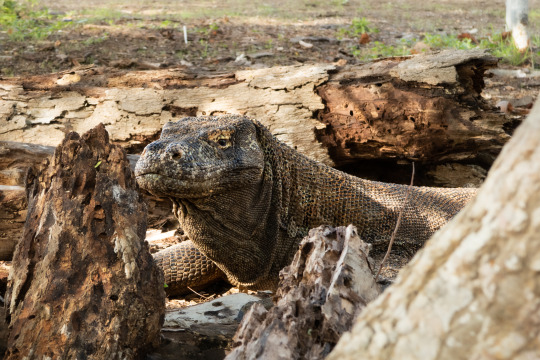
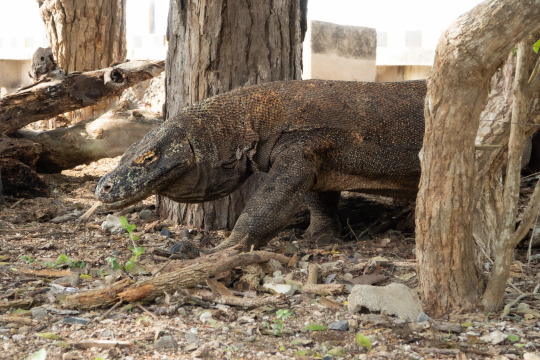
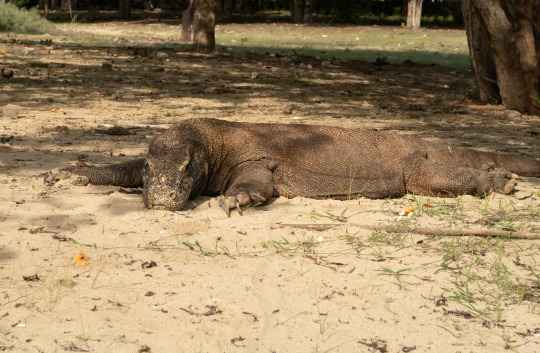
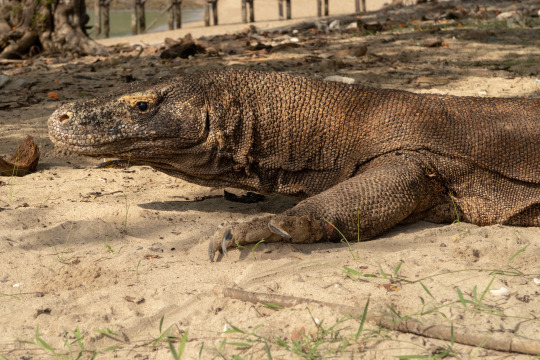

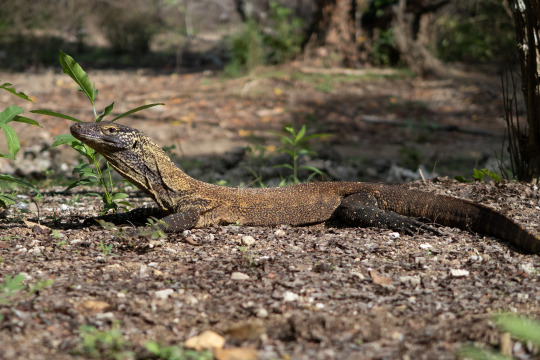
Photos Above: an excellent shot by our guide with the first adult male we encountered; the same adult male; going for a wander; another adult male splayed out on the sand; warming up; with our pet dinosaur; the agile juvenile
We continued walking along the beach and saw a grand total of four adult males (highly unusual apparently, as oftentimes visitors may see no dragons at all). We did a mini loop through the forest where we saw no further dragons but did acquire a cloud of mosquitos, and then just as we re-emerged back on the beach we spotted a much smaller (maybe 1m long?) juvenile darting about.
Dive #9: Manta Point
WHAT a dive! We left Sam on the surface snorkelling and descended down to the rubbly seabed. Despite the sand particulate floating around, reducing the visibility to about 15m, within a few minutes we saw our first manta ray—amid the rubble, there were small rocks here and there covered in coral and home to enough fish life as to create cleaning stations for the mantas. This one rocked up and hovered over the cleaning station for a few minutes while fish cleaned its underside, looking for all the world as though it were gracefully flying on the spot. It’s best practice to stay as close to the seabed as possible when diving with mantas (and it also gives you a much better chance of them choosing to swim close to you) so we made sure to stay down and hold onto the small rubbly rocks to help stay in one spot in the current. After a few minutes, we let the current drift us away and for the next more than hour, every time we spotted a manta we would descend to the seabed (in some instants flattening ourselves completely if a manta chose to drift closer to us) and watch it closely for several minutes until either it moved on or we were ready to do so. We definitely saw a few individuals twice—one was entirely black (melanistic) including its cephalic lobes except for a white star on its belly; another was missing one cephalic lobe entirely. I also noticed several individuals appearing to be in the early stages of pregnancy, with tiny bumps. An absolute highlight was watching three manta rays come to the same cleaning station and then slowly drift off in different directions, including one of them swimming over me a mere couple of metres above me (I was utterly flattened to the bottom to become one with the seabed at this point), genuinely blotting out the light for a brief moment. We must have seen at least ten individuals, though likely closer to fifteen. When we surfaced after nearly 70 minutes underwater, we went to pick Sam up. He had helped Grace to snorkel for the very first time, linking arms with her in the water to help guide her as she saw her first ever manta rays. Then, for at least half an hour he had followed one individual on the surface, watching it stop at a cleaning station, glide a few metres beneath him to feed, and generally going about its business totally accepting of the mere human delightedly following it about.
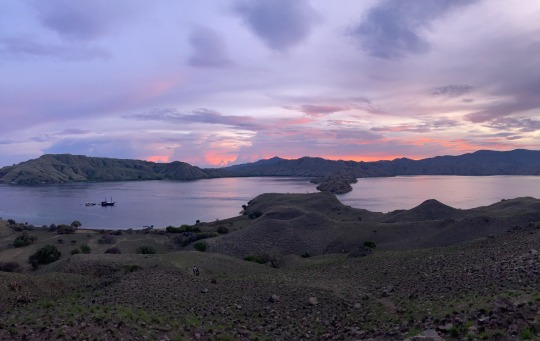
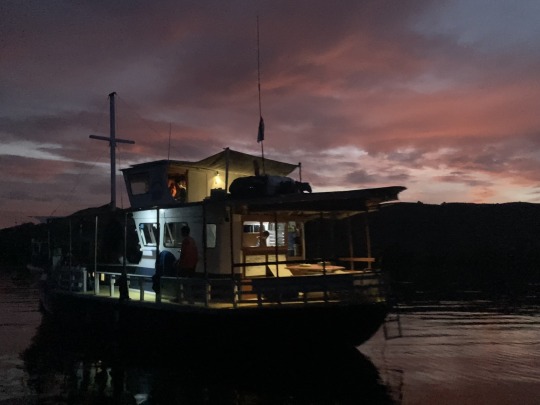
Photos Above: on day 4, we moored up on a nearby island and hiked up the hill for ten minutes to get this beautiful sunset view; returning to the Busy Girl in the fading light
Day 5
Dive #12: Batu Bolong South
Another knock-out dive. We did negative entry and dropped down the wall of the reef. The current was so mild here that we didn’t hook in and instead just put a finger and thumb onto the wall for support and watched the beautiful fluid movement of the sharks. This first half of the dive had particularly spectacular topography, with the huge wall disappearing deep into the blue below us and rising above us to the surface like vast mountain peaks, with canyons and ravines sweeping into the rock—vast formations like this always have the effect of making me feel small and humbled.
We drifted around a corner and out of the current and began slowly zigzagging up the slope of the reef, which was one of the most spectacular I’ve ever seen. It was multicoloured with so many different textures and there was SO much fish life, with the water around us absolutely full of schools of fish darting this way and that. With the iridescent flashing of the fish, the sunlight streaming in, the seagrass and soft corals swaying in the swell, and the brightness of the colours, it was dazzling. To top it all, we heard the sound of dolphins passing by somewhere out in the blue. For the last few minutes, we were accompanied above by Sam who was snorkelling on the surface. I noticed that he curiously kept looking under his armpits, and when we ascended he showed me two absolutely miniscule juvenile Sergeants (circular silver fish with vertical yellow and blue stripes on their body), each no bigger than 2cm, which had taken residence in the space under his armpits. He had fondly named them Doris and Deidre.
Dive #13: Mawan
WOW WOW WOW WOW, WHAT a dive!!! Easily one of our top life experiences.
Yunus and I dropped down to a fairly wide plateau at about 15m, swimming along it with the reef rising upwards several metres to our right and dropping down into the blue several metres to our left. As we swam along, four individual manta rays passed by us. Sam was snorkelling and spotted us below, tracking us for the rest of the dive. After a while the plateau curved around to the right and the bottom became sandier, with little reefy outcrops here and there, which were evidently a series of cleaning stations for the mantas. The next forty minutes were mind-blowingly special. The first really incredible experience came when one huge, (slightly) pregnant female swam in slow circles close to us as she was cleaned, coming so low over me as I flattened myself to the seabed that I could have touched her if I reached up—I definitely teared up into my mask. I looked up afterwards and saw that Sam had caught the whole thing on camera.
We swam a little further on and then things got really wild. Mantas started soaring from all directions and as we were so shallow (about 8m) that the sun lit everything up and on top of that, the visibility was decent, so the whole thing was spectacularly clear. At one point, Yunus and I excitedly counted seven manta rays around us at the same time. They were slowly circling above the various cleaning stations around us and I had somehow parked myself right next to one so as I lay flattened to the sandy bottom, remaining as still as possible, several of them became curious and flew very low over me to experience the bubbles of my exhalations on their wing tips and bellies (though I didn't realise at the time and tried to lessen my exhalations for fear of startling them!). There was something absolutely magical about the experience—instead of being apart and observing the manta rays, it felt as though Yunus and I below and Sam above were all held within the moment, experiencing nature from within the phenomenon. Slowly the mantas started gliding off and when no new individuals swam into the stations, we surfaced after 70 minutes underwater, absolutely high from what we had just experienced.




Photos Above: a male passes by Yunus and myself (if you peer closely, you can see I'm the one with blue fins); a male and female circle together; two mantas right above me; a female about to pass over me
Dive #14: Wainilu
Forth dive of the day! And a night dive to boot. We dropped down to about 15m over a sandy, rubbly bottom with soft pink coral sprinkled here and there, and spent the dive slowly zigzagging our way up. We each took a torch and floated slowly along the bottom moving our beams about slowly. Turns out Yunus has amazing eyes for spotting small stuff at night, pointing out SO many fascinating creatures. There was: a bright orange Starry Night Octopus covered in white-blue spots with all its tentacles furled up beneath it; a long red Short-Tailed Pipefish (a bit like a seahorse only long and straight); lots of really brightly coloured nudibranches (a type of sea slug) including some that were even neon green and blue; a crab whose back was camouflaged to look like rubble; and best of all, an Ornate Ghost Pipefish, a tiny (maybe 7cm), frilly, black fish related to the seahorse. When it came time to do our safety stop, we turned off our torches and then waved our arms and legs about as though we were dancing in zero gravity, watching as bioluminescence sparked around our flailing limbs.
Day 6
Definitely sad to be leaving the Busy Girl after an amazing few days. We both had that wonderful feeling of being completely disconnected, having hardly seen a person besides the crew for a week and certainly not having seen anything verging on mass civilisation. And despite Sam’s distinct lack of diving, we had several wildlife encounters that we’ll remember forever—certainly a fantastic first liveaboard experience.

Photo Above: with the WONDERFUL Busy Girl crew, from left to right: Fian, Grace, Yunus, Suhar, and Herman!
0 notes
Text
Ocean-side Once More
Back to the Ocean
We caught the ferry from mainland Bali back to the small island of Nusa Lembongan with excitement, happy to be returning.
The following ten days were idyllic. We returned back to the same wooden bungalow on the beach, run by a lovely local, a man named Suka who has gone above and beyond helping us to organise boats, supply us with huge containers of drinking water, and generally make our stay(s) really comfortable. We rented the same trusty (and rusty!) scooter from him again and went buzzing about the island, feeling almost as though we’d come home—though this time around, we were now the proud owners of South-East-Asian-level ponchos, which meant we were fully equipped for the occasional daytime rainstorm while we were out and about.
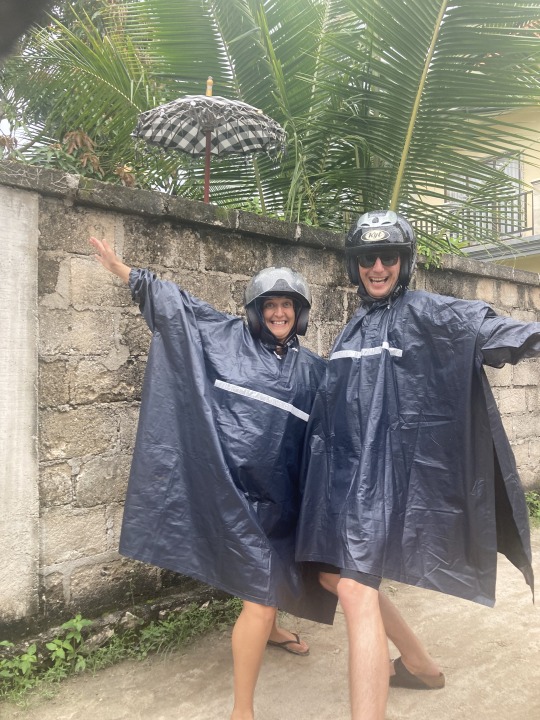
Photo above: looking exactly like the locals, of course
Video above: travelling from Lembongan village (in the bay where our dive shop was), over the hill past one of the island’s cemeteries and sunset point with its spectacular view, and down into Jungut Batu, the village in the bay where we were staying. I’ve kept it at original speed so you can hear the soundtrack of the island if you like, but I promise I won’t be offended with anyone who increases the playback speed for a quicker viewing!
We spent our days drinking exceptional coffee in the café next to our accommodation, reading, studying (both of us are loving having the time to dig into various topics we’re interested in), watching sunsets on the beach, and visiting our favourite restaurants all over the island (where the staff welcomed us back with genuine warmness). I got into the sea for the first time since my ear infection and found I could equalise my ears—though by this point, poor Sam had caught a very minor version of my cold that left him too sniffly to clear his.

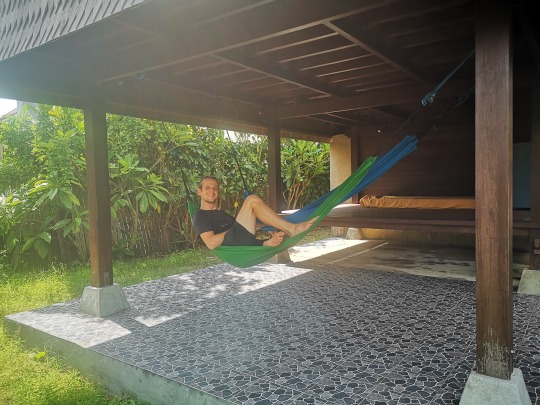

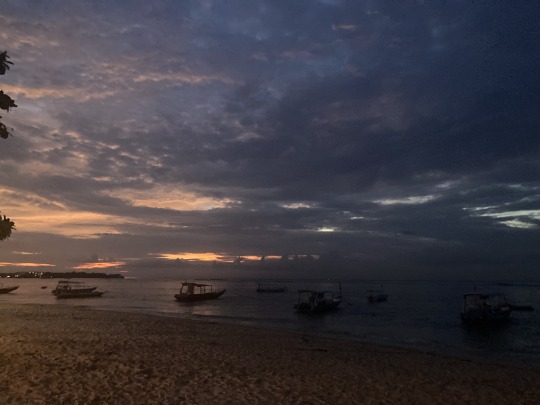
Photos above: right on our doorstep!; plenty of hammock time; sunset point at dusk; moody sunset vibes on the beach
One day, we were sat having coffee next door when a couple with two baby twin boys wandered in—we instantly recognised them from our plane journey over to Bali (I gave up my seat so that they could sit in the front row of economy together and therefore have two clip-in cots that the plane provided, instead of one—it felt only fair given that they were going to have to endure a plane journey with 6-month-old twins!). We passed a lovely afternoon in the café with the family, catching up on the nearly two months since we’ve seen them and playing with little Jonathan and Oliver in the sand. Amazing to have our paths cross again so organically.
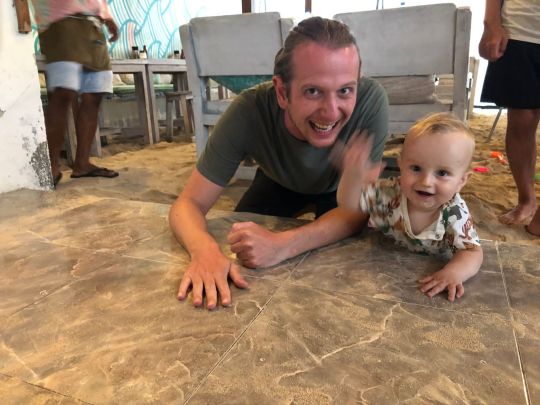

Photos above: Sam with Jonathan; myself with Oliver
Big Up Tamarind
When out eating another evening, we ran into Pepe, an instructor from Tamarind Divers (the dive shop that I’ve been diving with in Lembongan). In chatting with him, we learnt that he had just two days left on the island before returning to Spain for a few months (he spends roughly 6–8 months a year on Lembongan and the rest back home in Spain). So although Sam’s ears weren’t yet clearing, we decided to get on the boat for our last two days on the island, with Sam snorkelling on the first day and me diving both days so that we could spend some time with the staff who we’ve become friends with, before Pepe left and we too had to move on.
We had an amazing couple of days—it was great for Sam to be able to visit some sites in the north to snorkel, given that he hadn’t had the chance to do so diving and so hadn’t seen the amazing coral and rich life there. And for myself it was lovely being back in the water—I had no idea if my ear would be fully back to normal but after three weeks away from the ocean it was thankfully completely fine.
Diving with Tamarind Divers has been a special experience, specifically because the staff create such a wonderful ethos. The shop is locally owned and run, and the staff are a very close-knit team. Not only are they really on top of the safety aspect of diving, they also give really in-depth briefings before each dive, which Sam and I always note as a mark of a thorough and enthusiastic dive shop.
First up, there is Bunter, the guide for almost all my dives and fellow marine enthusiast. A Lembongan local, Bunter not only has nearly 6,000 dives in the area under his belt, he also has magic eyes for spotting the small stuff—and when I say small stuff, I mean he once pointed out a nudibranch (a type of sea slug) that was the size of a slither of fingernail. A slither of FINGERNAIL?! I mean, I could barely spot something that small on land. We got so comfortable diving together that we would frequently have a giggle underwater.
Next up, there is the wonderful Pepe. Pepe has been coming to Lembongan to teach for the last six years, though he has been diving for a whopping 46 years (with a track record of a mere 12,000 dives) and spent about 25 of those years as a video oceanographer before he moved into teaching. He’s one of only a handful of people whom Sam and I have met on our various travels who really and truly seems as though they belong to the ocean. Every day on the boat with Pepe was a good day, as he brought exuberance and passion to everything he did. He not only has some of most interesting life stories I’ve ever heard, he also has complete humility about his frankly incredible experiences.
Suka, dive guide and co-owner of the shop, was the very first instructor on Lembongan (18 years ago, I believe). His gentle nature pervades everything he does, from how welcome he made us feel as customers to how he runs the dive shop with such warmth and consideration. It’s clear that his team love working there and that he had created something really special.
And finally, a shout-out to the rest of the team, who kept the entire operation running not only smoothly but as if it was continuously a real joy. The fantastic (and EXTREMELY smiley) “Capitan” Mare, who navigated the open waves with serious expertise. Kadek and Bayu, the two dive shop helpers (who I suspect may one day make amazing dive guides in their own right). Wayan, the other co-owner who ferried us to and from our accommodation. And finally, Paul and Evy who had to leave to go back to Australia at the end of a long season working after we’d been in Lembongan for just a week but who made us feel really welcome and gave us the full initial lowdown on diving in the area.

Photo above: with some of the fantastic staff of Tamarind Divers, from left to right: Bunter (resident dive guide), Suka (co-owner and diver extraordinaire), and Pepe (one of life's true legends)
On our last day in Lembongan and my final day diving, I realised just as I was getting into the water that it was my 250th dive. Nothing as impressive as the tens of thousands of dives that the staff have combined but nonetheless, my own mini milestone!
After the final day diving, Sam and I were eating lunch at a local warung (roadside restaurant), when Pepe scootered past and informed us that we were invited to the staff-only leaving meal that they were having for him that evening. So on our own last evening on Lembongan, we rocked up at a restaurant and passed a lovely evening with the team. We talked about all manner of things from the Indonesian education system to football to the hilarity of the various English-speaking accents from around the world. But mostly we had a real laugh and felt lucky to have met and been so welcomed by such a great bunch.
Into the Unknown
After spending nearly a solid month of our first seven weeks in Indonesian on Lembongan, we definitely feel a sense of sadness to be leaving—the marker of a really special place. Though Sam’s ears unfortunately didn’t heal in time for him to dive on the island, they are now so close to being completely healed, thank goodness. And so today, we are getting the ferry to the mainland to begin our journey onwards, with something really exciting booked for the next leg of our adventure... And with that, we shall leave you all in suspense!
0 notes
Text
Ubud Part 2: Cooking, Cremation, and Holy Sites
Culinary Escapades
Welcome back for Part 2 of our Ubud adventures! As you may remember, I spent a significant chunk of our time in Ubud working through a litany of minor scrapes and colds, but luckily just before the cold really got a hold of me, Sam and I snuck in a culinary treat.
Given our obsession with food, Sam’s mum Ali had generously gifted us a Balinese cooking class. We picked a session with the Bali Farm Cooking School, which began first thing in the morning at a food market in Ubud. Our instructor, Deren, walked us between the stalls, taking us through various local produce. He then drove us about half an hour out of town to the farm, where we then toured the farmland itself, learning about what they grow and picking ingredients for our cooking. It’s a small farm, just 1 hectare (2.5 acres), used predominantly to grow food to run the courses and feed their family, though anything left over is sold at market. We walked between coconut palm trees to pick chillies, lemongrass, and lots of green produce such as pak choi, as well as a hunk of turmeric root and even a strip of cinnamon bark.


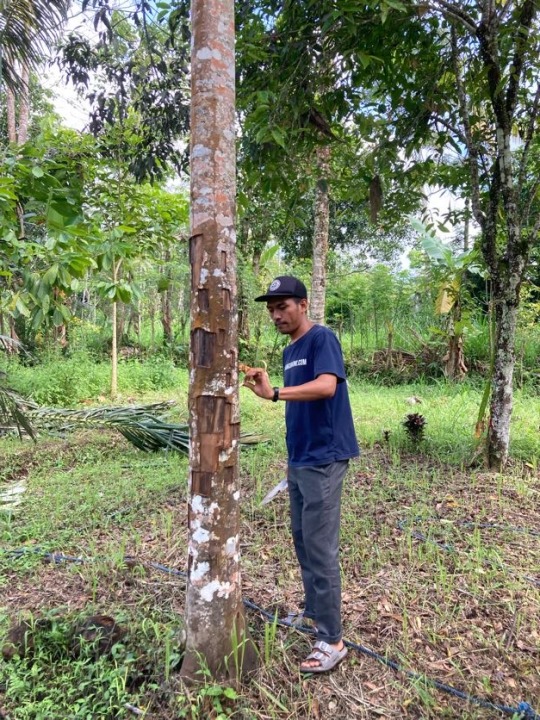
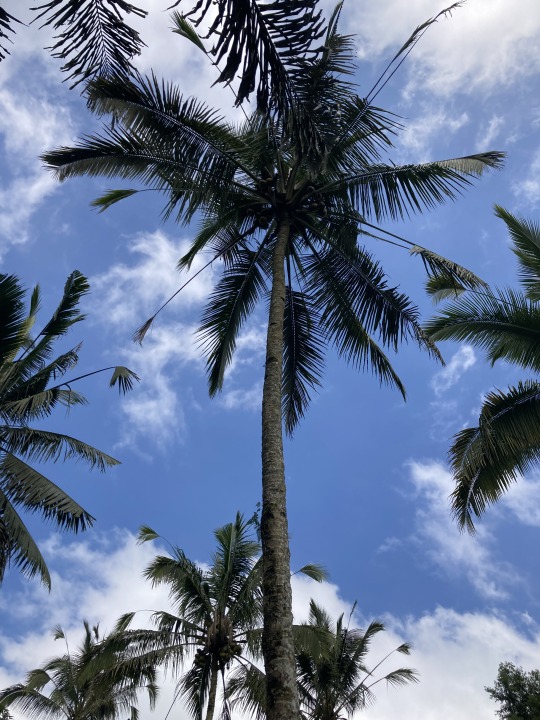
Photos above: Deren teaches us about different roots in the ginger family at the local market; picking leafy greens for our cooking; Deren cutting some cinnamon bark; coconut palms
The cooking itself took place under a thatched roof structure that was open at the sides so that we could look out at the farm as we cooked, as the day moved from persistent sunshine to full-on rainy-season rain. The class taught various menus simultaneously, so we opted for the vegetarian, which was either often innately vegan or easily adaptable. Deren was a fantastic instructor, making the whole process both great fun but also precise and full of interesting titbits. As well as learning about various new ingredients, we also made our own Bumbu Bali, a spice mix that forms the base of many Balinese dishes and involved a lot of manual crushing of ingredients using the heavy-duty pestle and mortar. Throughout the morning, we cooked a 6-course feast, working in stages to first create two appetisers and pause to eat them, before moving on to cook and eat our three mains, and finally our dessert. Our menu was, for starters, sweet and sour tempe plus fresh gado gado. For mains, we ate sizzling corn fitters, a tempe and tofu vegetable curry, and pepes (a mushroom mix steamed in banana leaf parcels). And to cap it all off, we tucked into black rice pudding with banana chunks and coconut milk. Scrum-diddly-umptious.
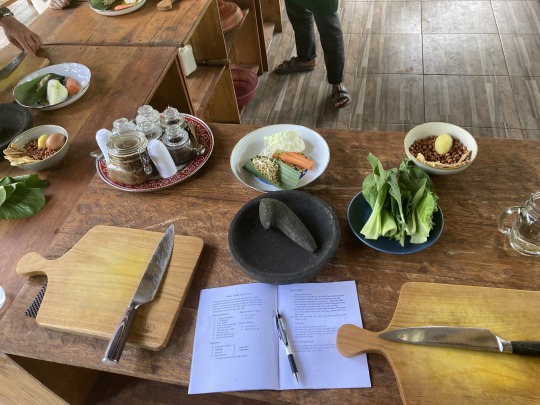


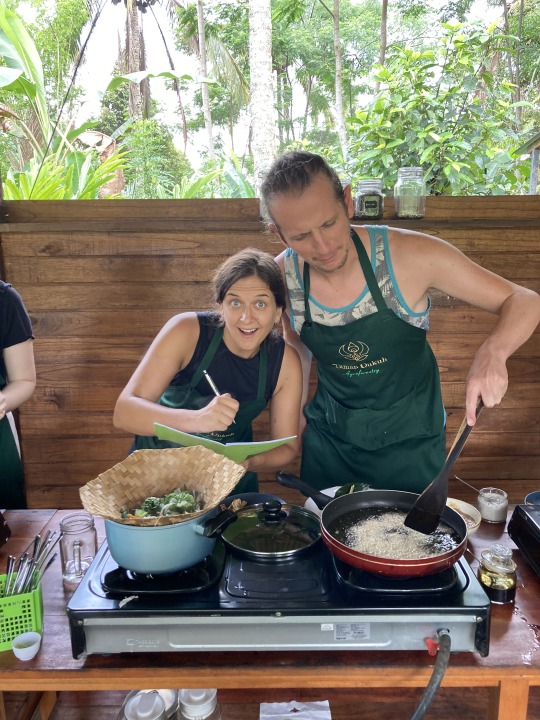





Photos above: our preparation station; Sam crushing spices; our cooking station; Sam cooking while I studiously annotate the recipes; Sam flipping the sweet and sour tempe; eating our appetisers; preparing the pepes (banana leaf parcels); frying up the corn fritters; our main course
A Royal Send-Off
On one of the days I was sick in bed, Sam headed into Ubud’s town centre where four cremation ceremonies were taking place. These are normally a spectacle, but the final one happened to be the cremation of a prince from Ubud’s royal family, so it was unusually extravagant affair. As part of the celebrations, a procession passes through the city. At the front is a float of a giant holy cow that the body and personal possessions are placed into for the cremation itself. Following behind are family members and offerings for the ceremony, and finally, a float that bears the body. In the case of the prince, this structure was a whopping 18m (60ft) high, with two large teams of men taking it in turn to carry this massive structure through the town. Once they arrived in the centre, a ceremony took place, before the body was burnt inside the holy cow.


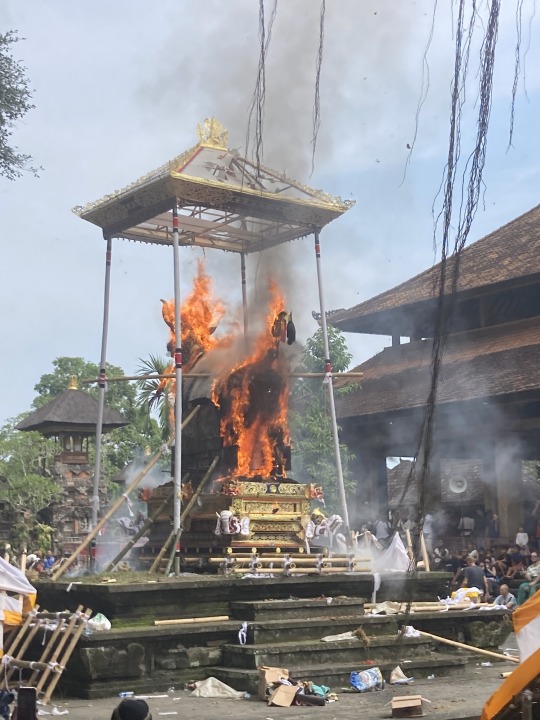
Photos above: the royal prince's 18m-tall float; transferring the coffin from the float down to the sacred cow; burning the body within the sacred cow effigy
Video above: the prince's float is carried through the streets
Sacred Explorations
After sampling the dancing, cuisine, and retail options that Ubud had to offer us, as well as hiring a scooter for the day to move about the town more easily (turns out one of life’s peak happiness moments is riding pillion on a scooter as you zoom through a tropical town with the person you love), we decided, on our last day, to explore the surrounding area. Madé (the taxi driver/Kecak performer and passionate Liverpool FC supporter we met through the dance performance) was our driver for the day and took us around a number of amazing sites. First up, we headed to Goa Gajah (or Elephant Cave), a 9th Century temple site created around a cave sanctuary carved into the rock. It was so named because it’s thought that the carved face might resemble an elephant (this was quite a stretch of the imagination for me given the complete lack of trunk) or else perhaps named after the Ganesha elephant figure inside the cave itself. The whole temple site is sat amid the surrounding forest so after walking around the temple itself and into the cave, we then climbed down various flights of stairs amid the trees until we were standing beside a small waterfall. It’s amazing how these beautiful temples are so often set within incredible scenes of nature.



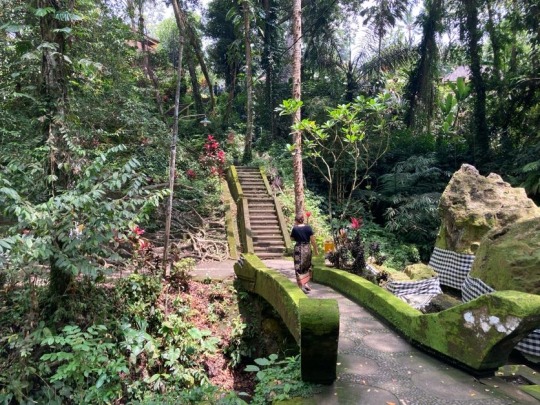

Photos above: with Madé at the Elephant Cave; inside the cave, smokey with incense; one of the temple's shrines; walking through the surrounding forest; a sacred bayan tree in the grounds
Next up, we headed to Gunung Kawi. To get to this sacred site, we had to climb down roughly 300 steps, past rice paddies, streams, and forest. Just as we reached the temple, the daily rain began and we immediately took cover. Rainy-season rain isn’t just like heavy rain in the UK—it’s so intense that you can become completely soaked within a minute (not a hint of exaggeration here, truly) and can last at this intensity for hours. In the end, we only had to sit it out for an hour until it abated and we could wander around. The 11th Century site is most famous for the ten shrines, five on each side of the narrow valley, carved directly out of the rock. Each one stands at 7 metres (23 ft) tall and they are thought to be dedicated to King Udayana, his queens, sons, and concubines.
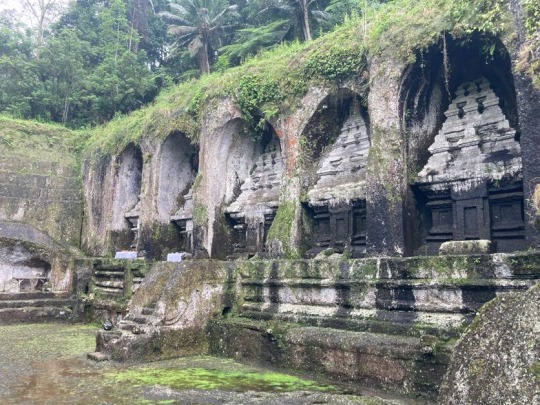

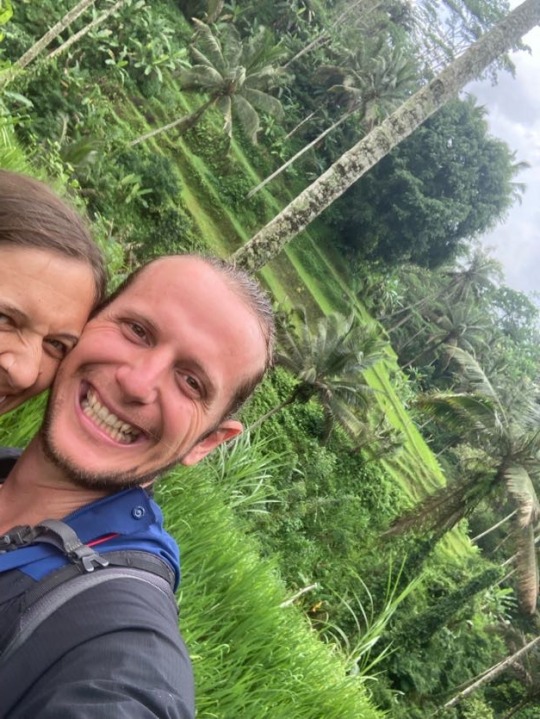
Photos above: five of the shrines on one side of the valley; several of the shrines on the other side of the valley with the stream in view; Sam's amazing photography skills when capturing the surrounding rice paddies
We paused on our journey for lunch and ended up at a road-side restaurant that was a kind of wooden tunnel built high on stilts (i.e. basically a TREEHOUSE RESTAURANT, hell yeah), so that the view was of a vast valley covered in rainforest (though the food was very average, and very expensive so the view certainly wasn’t free).
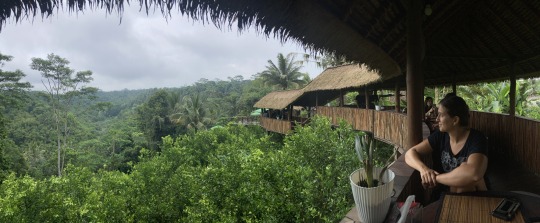
Our final sacred site of the day was the busiest—Tirta Empul (loosely translated from the Balinese to mean “water gushing from the earth”) is one of the five most sacred sites in Bali and so attracts a vast number of visitors. It was first founded in 962AD, around a water spring after, legend tells, an epic battle between a magical king named Mayadenawa and the God Indra (very long story short, Indra wins over the evil king and pierces the ground with his staff, from whence gushed forth the holy water). The temple is, unsurprising, dedicated to Vishnu, the Hindu god of water.
At the entrance, a vast, ancient bayan tree stood, huge branches spread thick with bromeliads and draping vines to the ground. We were given sarongs, as with any temple visit, and then wandered our way through the complex. We started at the purification baths, where anyone who wished to was invited to step into the water for the purifying ritual. Past the baths, we came to an inner courtyard filled with shrines and a large pool, built around the spring itself and containing crystal clear water, showing the bright green of the reeds growing within it. On the way out, we passed the Koi Pond, where hundreds of Koi Carp fiercely swarmed together whenever anyone sprinkled the fish food on sale into the water.

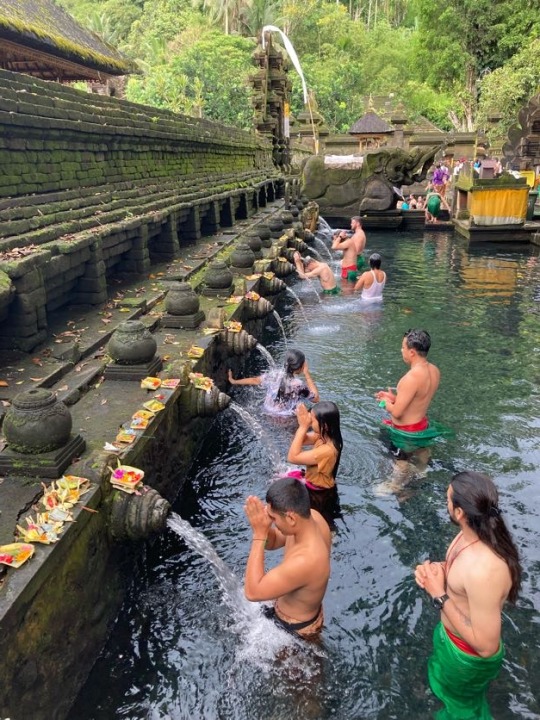
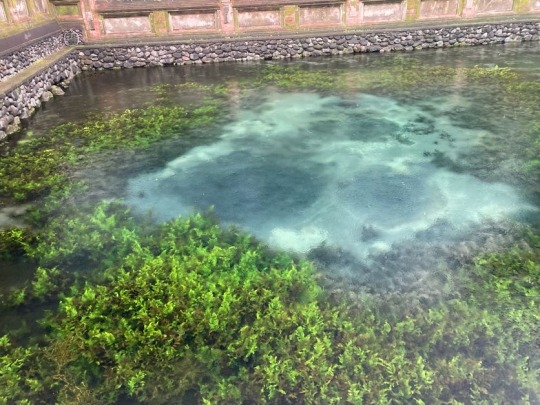

Photos above: being shy with Madé's exuberant photo-taking at the temple entrance; the purification ritual; the holy spring; the Koi Carp
Our last stop was at the Tegallalang rice terraces. This swathe of farmland is famed for its beautiful paddies cut into the side of the valley, but we were actually quite disappointed—the way to look over the landscape was by paying an entrance fee to a kind of park that seemed entirely made up of various “selfie” spots and swings from which to take photos for Instagram. There are probably better spots to check out the terraces from, but this one was not our cup of tea, especially considering that Sam and I are both horribly awkward whenever a camera is pointed at the both of us together.

Photo above: a huge photo spot feature set in front of the rice terraces
Lembongan Take Two
After nearly two weeks in Ubud, we headed back to Nusa Lembongan (the island we were previously staying on). Though I’m still recovering from the vestiges of the cold, our hope is that Sam, finally, will be able to dive here—fingers crossed!
0 notes
Text
An Extra Treat!
If you have just read our blog post from today, you’ll know that this week I’m including a wee extra titbit for you all—but if you haven’t yet read the post, definitely scroll down and update yourself there first before sliding back up here.
This week, the wonderful Pepe, one of the instructors on Nusa Lembongan who was previously an ocean videographer for 25 years and boasts an extremely amazing record of experience (think National Geographic) sent me some GoPro footage that he snagged of me recently. In the video below, Pepe filmed me (I’m the diver in the background) and a reef manta ray at the very moment that he (yep, we could see that the manta was very definitely a male) passed within a couple of metres of me. Leaving me to ponder, can life really get more magical than this?
Video above: Helen communing with a manta ray. To check out more of Pepe’s work, please take a look at his Vimeo profile.
0 notes
Text
Ubud Part 1: Injuries, Illness, and Glowing Embers
A Change of Scenery
Welcome to Part 1 of 2 about our mini holiday-from-our-holiday! Last we left off, I had managed to get an ear infection just as Sam’s own ear issue was resolving itself, meaning that I, too, now couldn’t dive (being able to clear your ears is imperative for diving in order to be able to ascend as the water pressure increases). As Sam was still a few days off diving himself, we decided to cut our losses and leave the beautiful island of Nusa Lembongan for a while to explore the Bali beyond diving.
We hopped on a ferry to the mainland, and then caught a taxi for the hour’s journey from the port up into the foothills of the mountains, to reach the town of Ubud. Ubud is known for many things: being the arts and crafts centre of Bali; the lush rainforest pressing in on all sides; the rice paddies sprinkled throughout the town itself; its Sacred Monkey Forest Sanctuary; and finally, as being the hub for yoga in Bali.
After arriving in Ubud, we took things very slowly. In our nearly two weeks here, while getting over my ear infection, I’ve managed to fall over on a wet pathway and scrape one foot so badly that I couldn’t walk properly or wear shoes for several days, and then to top it all, I caught a cold that hit me so hard that I was confined to bed for several days. Though we’ve sprinkled in occasional sightseeing, we decided these were probably signs to mostly do not too much.
For the first few days, we stayed in a homestay south of the centre created and managed by the lovely Erwin, staying in a large room with its own terrace in a gorgeous, tropical garden, tucked away from the traffic of the area. Once I could walk again, we spent a lot of time meandering around Ubud. It’s a beautiful town, with rice paddies set amid the houses, and green foliage and bright flowers dripping over the pathways as the rainforest weaves its way through the streets—case in point, just a few days ago, as we walked along a narrow pathway alongside a stream, a teeny tiny snake wiggled its way beside us (which of course, fascinated me so much that we had to stop and peer at it for a while).
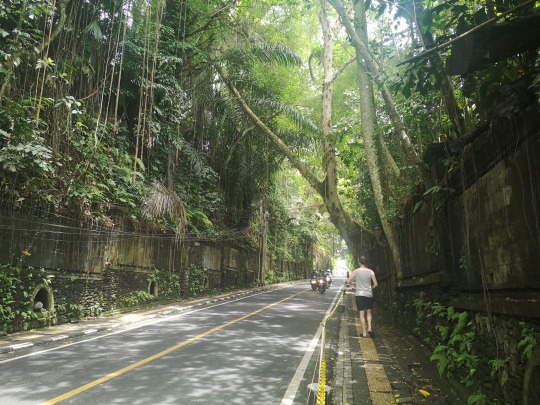
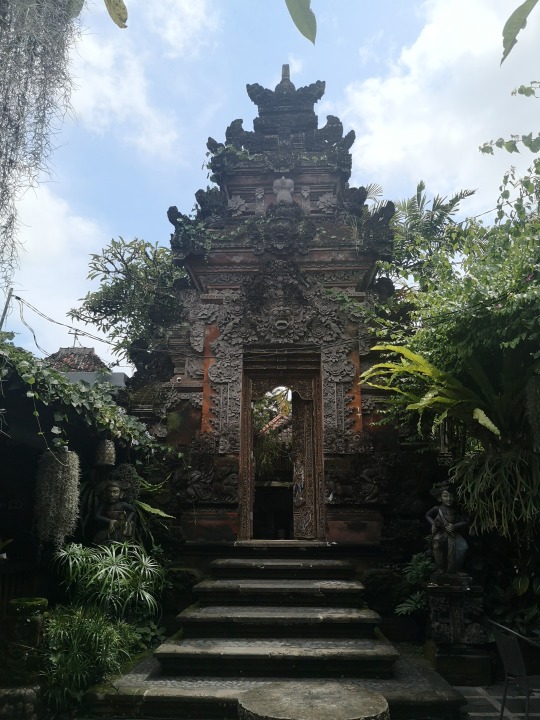
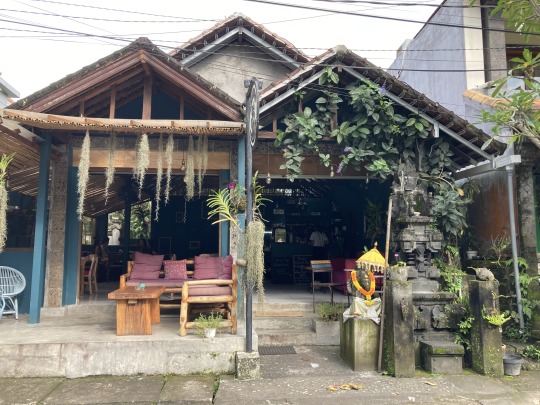

Photos above: the leafy streets of Ubud; an ornate doorway to a house; a small shrine outside a cafe (almost every single individual establishment and house has its own shrine in Bali); street art and rainforest intertwine in Ubud
The walk to and from our homestay to the centre passed around the Sacred Monkey Forest Sanctuary, a 25-acre area of protected forest, where about 1,200 Balinese long-tailed macaques live. The forest itself has three temples and along with its primate residents is considered sacred by locals. Walking the narrow concrete pathway that runs around its outside, we watched the scooters zoom along the fenced edge of the forest as monkeys loped about, either peering at or resolutely ignoring the humans.
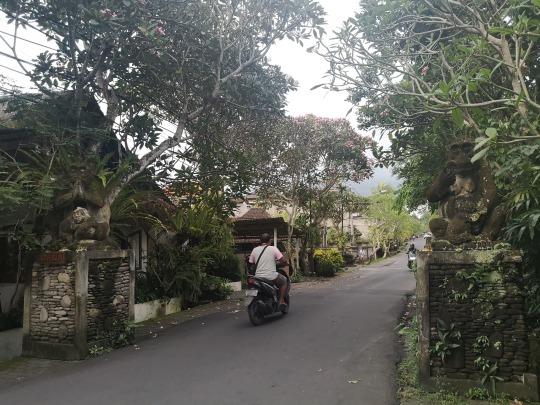
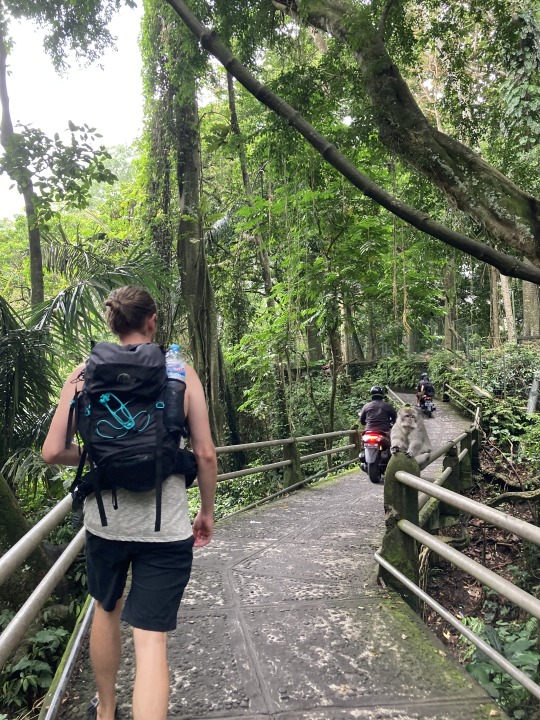
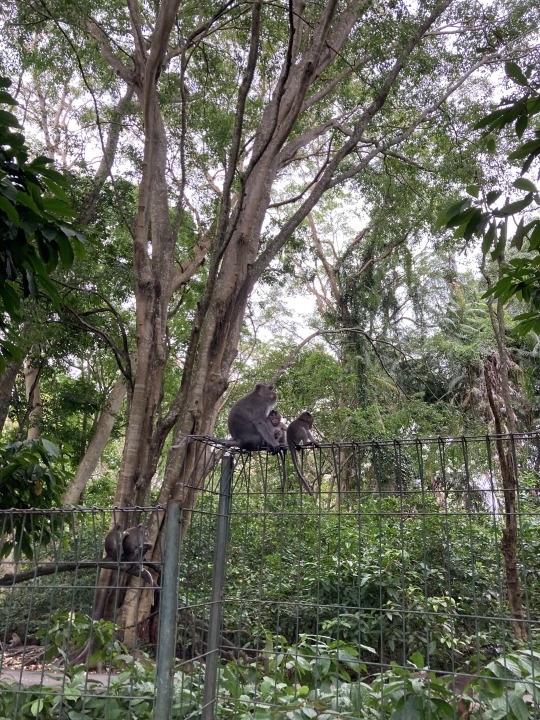
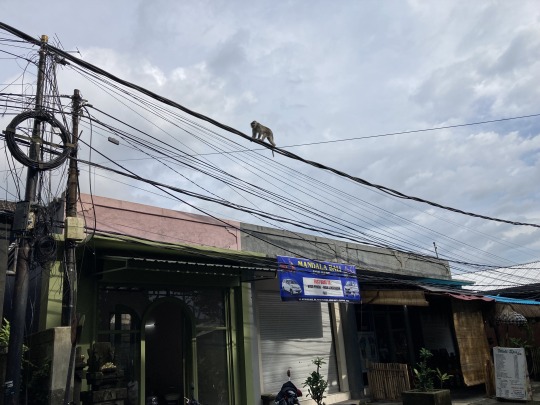
Photos above: two monkey shrines flank the road leading to the forest sanctuary; Sam, scooters, and one very chill macaque; a mother and her young; a monkey trapeze artist
Ubud’s centre consists of a handful of blocks lined with restaurants, art galleries, and clothes shops. We spent several days drifting around the area, eating a lot of good food, drinking a lot of tasty coffee, gazing at the artwork, and doing a bit of shopping ourselves—you may spy some photos at some point of Helen in tie-dyed, blue-and-white shorts done in the batik style Bali is known for. Sam has also made it to quite a few yoga sessions (though I had to sit these out while I recovered from my menagerie of injuries/illness).
As well as having a deep-tissue massage that left us feeling both partially beaten up and extremely at ease in our bodies (quite the paradox), we also tried a “cream bath”, a local spa treatment credited with being the reason why so many Balinese men and women keep their lush, dark hair well into old age. For the grand old price of £5.50 (approx. $6.50 USD), we received an hour-long treatment that consisted of: a hair wash, application of a local conditioning cream (in our case, made of avocados), a head massage to work the cream into the hair, neck massage while the cream soaked in, hand massage while the hair was steamed, and finally, it was all washed out and a hair tonic applied. As it turns out, I may be the kind of woman who drinks sugary ginger tea while her hair is steamed and her hands are massaged of a Monday afternoon—who knew?!
Artistic Flair
After a few days getting to know Ubud, we made it to ARMA (the Agung Rai Museum of Art), an art complex a short distance from our homestay. The gardens were a work of art themselves, Hindu shrines and sculptures set amid the greenery, and walkways built between water channels and rice terraces, the whole thing a man-made shrine to the surrounding nature.
There were several different buildings, their walls lined with art. We began with the more traditional artwork and moved through to modern interpretations (though we weren't allowed to take any photos of the artworks inside so I'm afraid my descriptions will have to do). The traditional artwork was almost entirely from the 20th Century and of the “Batuan” style, developed in the village of Batuan, a few miles south of Ubud. This artwork often used quite muted colours (black and white or sepia tones), and was highly detailed and stylised, depicting vast village scenes with every leaf and minor figure shaded and detailed—you could honestly stare at each piece for hours and still not notice every little detail. Often the artwork showed either scenes from religious life (for example, a whole village participating in a cremation) or scenes from one of the Hindu epics, particularly the Ramayana. As we moved towards the more modern art, the style remained very heavily inspired by the Batuan aesthetic but used much more vivid colour and even sometimes depicted modern events—for example, we saw one piece showing the sinking of the Titanic and another depicting the 2013 crash of the Lion Air aeroplane (for those of you who may not remember, a Lion Air plane missed the runway when coming in to land in Bali, and instead landed in the water, breaking in two, and though miraculously no one died, quite a number of passengers were injured).
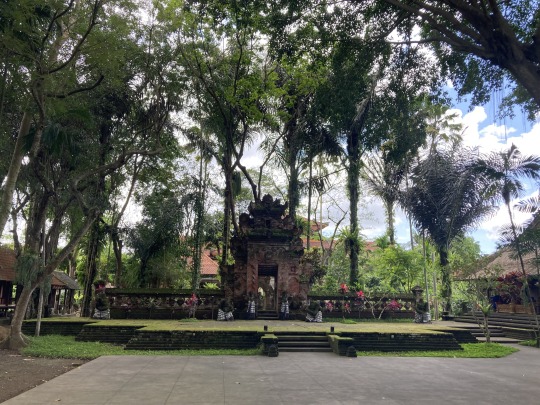

Photos above: the ornate entrance to the ARMA complex; a gorgeous motif outside one of its buildings
There was also an outdoor, covered area where several artists, themselves from Batuan, had huge canvases set up and were working on their artwork as we watched. They were keen to talk to us about the process of creating them and explained that one piece, huge, vividly coloured, and highly detailed, had already taken two years and wasn’t yet complete.
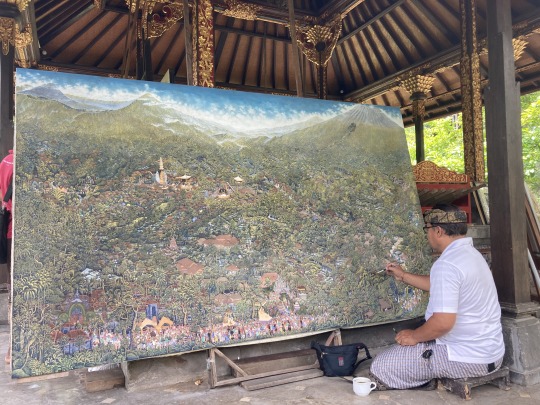
Photo above: two years in and still going strong!
After a few days in Ubud, we decided to move from Erwin's lovely homestay to experience a different area of town. We picked a small hotel in a neighbourhood that, though much closer to the centre, was surrounded by paddy fields and tiny streets, making it only accessible by scooter. We were given arguably the nicest room in the hotel, with a large balcony not overlooked by anyone but looking out over the verdant surroundings, terracotta tiled roofs poking out. I was delighted when, on the first evening, I noticed that at dusk the surrounding foliage lit up with twinkling fireflies.
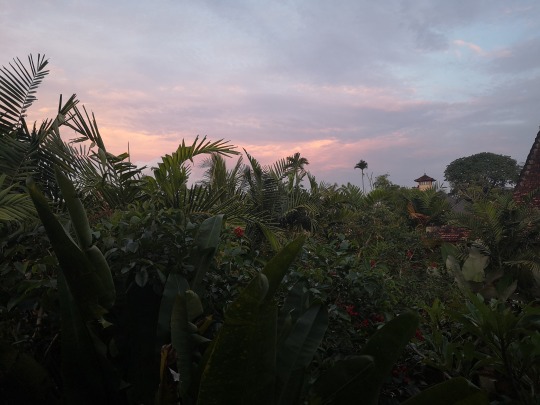


Photos above: the view from our balcony; the view from one of the hotel's buildings with the roof in the middle being our own room; the hotel's leafy surroundings
Truly Epic
The evening after moving across town, we headed into a temple in the centre, called Pura Dalem Taman Kaja, for a dance performance. There are multiple dance styles specific to Bali, but after a lot of research I decided to opt for a Kecak performance. This dance style has its origins in Sanghyang, an ancient ritual used to repel evil spirits through the acapella chanting of the dancers, and was developed through collaboration between a Balinese dance and German painter in the 1930s.
The setting was beautiful, the stage an open-air courtyard in front of the ornate temple itself. For the first half of the dance, 70 men sat in a several-layered circle, a white frangipani flower tucked behind the left ear of each dancer and a red bloom behind each right ear, performing the Kecak chanting, providing both the soundtrack for the dance and the living, moving set. In their middle, several dancers enacted a section of the Ramayana, in which King Rama’s beloved wife, Princess Sita, is kidnapped by the demonic King Rahwana. As I was familiar with this section of the epic as a child, I was super excited to see it performed and enthusiastically detailed the relevant plot points to Sam before the performance so that interpreting the action would be made easier. It was absolutely wonderful, an emotive, unusual, beautiful retelling—I particularly loved Hanuman, the white monkey god, though all the characters and their costumes were a sight to see.
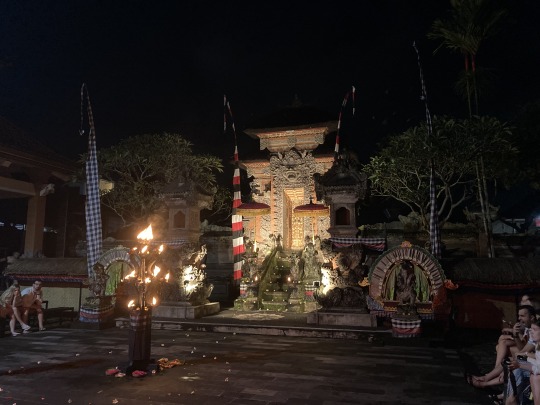
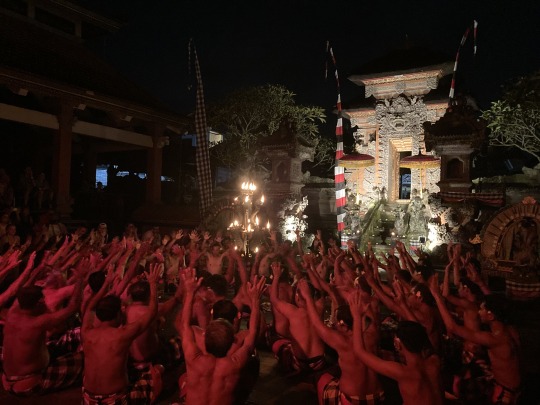
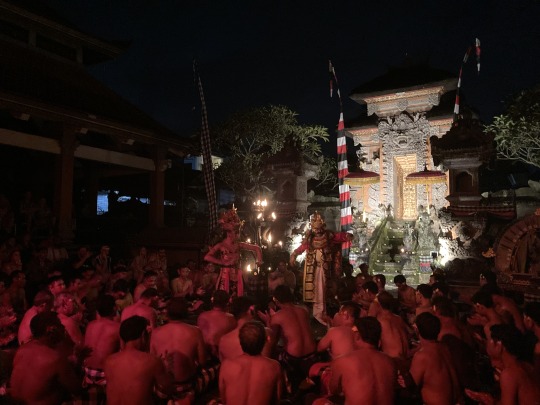

Photos above: the stage is set; the Kecak performers mid flow; King Rahwana appears to kidnap Princess Sita; Hanuman, the white monkey god, leaps into view
Video above; due to the lighting, the performance was extremely hard to capture by video, but if you turn the sound on, hopefully this short segment will give you an idea of the Kecak chanting that drove the storytelling
In the second half of the performance, the Kecak performers sat at the back of the courtyard, chanting, while a pile of coconut husks was lit in front of them. A man later referred to as the “Fire Man” entered, barefoot and with a kind of hobby horse between his legs (this hobby horse is traditionally used for trance work in Bali and on the island of Java too), and kicked the husks apart until they were scattered glowing embers covering the floor. He then proceeded to dart amidst the glowing remnants, kicking the burning husks so that the floor of the stone courtyard became covered in a sparking layer of glowing orange embers. Once he had finely scattered all the embers, two men (who were very definitely wearing flip flops) rushed in and swept everything back into a pile again, and then Fire Man began the scattering process again and again. It was mesmerising to watch, and made all the more amazing when he finished, the lights came up, and he sat down, showing us his soot covered feet with absolutely no burns. Our taxi driver (who was himself one of the Kecak performers) later told us that Fire Man is the single only person from their village who can perform this feat, and does to twice a week, every single week without fail, by going into a kind of meditative trance.
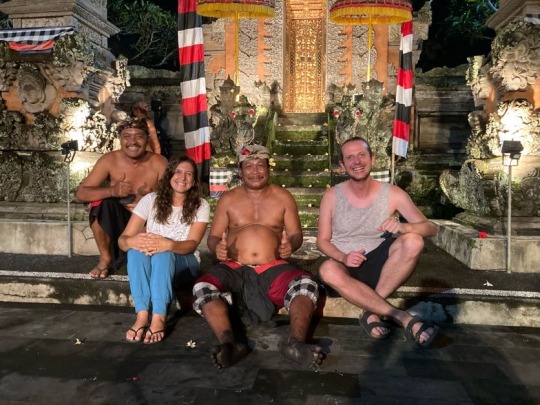
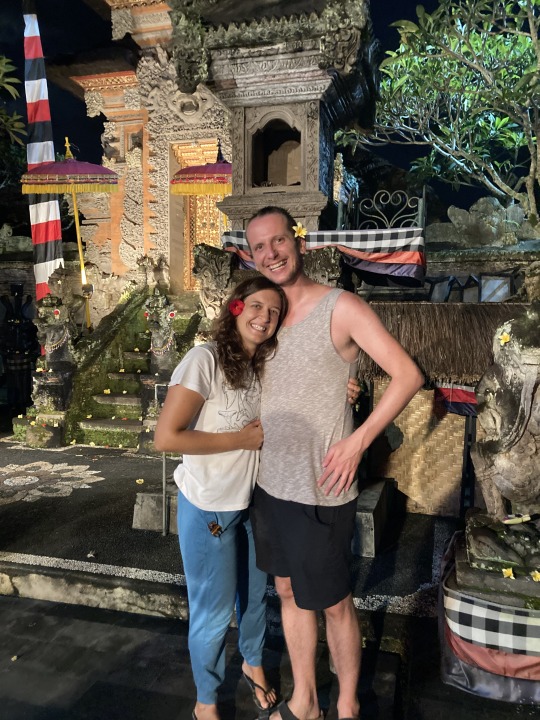
Photos above: with our taxi driver/Kecak performer called Madé and Fire Man himself; the two of us sporting the flowers that Madé gave us to wear
With that, we shall bid you adieu and leave you on tenterhooks for Part 2 of our Ubud adventures! But by way of a mini extra gift, keep your eyes peeled—as Tumblr only allows one video per post, I’ll be immediately posting another very short blog entry in order to sign off with a bit of a treat!
1 note
·
View note
Text
Underwater and Off-Road Sightseeing
The Beautiful Briny Sea
I gave myself a couple of very slow days to get over food poisoning, and once I felt back to normal, I got straight back into the water for more diving.
Over the last week and a half, I’ve had an amazing time diving around Nusa Lembongan, the island where we’re staying, and its two neighbour islands. There are two distinct areas where we dive. South of the three islands, the waters are usually a bit cooler at this time of year, so there is less coral and lower visibility but plenty of mantas—I’ve now dived with them a total of three times and if anything, the experience keeps getting more incredible. There’s nothing quite like a manta ray calmly gliding within a couple of metres of you, swivelling their eye to watch you, or seeing six circling together above the cleaning station rock to make you marvel at life.
Then in the stretch north of the islands, the warmers are a bit warmer and there are plenty of currents, so the reef is absolutely amazing, with a huge variety of soft and hard coral. This makes the sightseeing really colourful and full of life, from multiple turtle sightings (on one dive, we saw ten separate individuals), to schooling shoals of fish, to absolutely miniscule macro life if you have a great guide who has magic eyes for spotting tiny things, which I empathically do have (shout out to the amazing Bunter!).
The Road Less Travelled
While I’ve been diving, Sam has been giving his ears time to heal. He’s been going to yoga every day and has also become a real pro on a scooter after picking me up from the dive shop each day and running errands here and there. Between diving, I’ve taken some days off to hang out together. We have done an intense amount of planning for our next couple of months travel (the logistics of moving around Indonesia while also factoring in climate—rainy season is approaching in a lot of areas—and marine wildlife required many hours of research) and of course, given how obsessed we both are with food, we’ve eaten a vast amount of extremely tasty local food. One afternoon, we took the scooter and went on an explore. We ended up crossing the Yellow Bridge to Ceningan, the miniscule island next to Lembongan. We set off on the single road that loops around the island and were quite surprised not to meet a soul coming in the opposite direction until we realised that for nearly half of the loop, large sections of the tarmac had been washed away and the “road” is extremely uphill, so the going was both super challenging and absolutely hilarious (I got the giggles a lot as we bumped our way over each rock). We managed to make it all the way to the high point of the island though, where we found a local restaurant built right on the top of the cliffs, with a stunning view of the ocean and next island. Turned out that the second half of the loop to get us back to the Yellow Bridge was beautifully tarmacked and extremely easy going. Who would have guessed?!
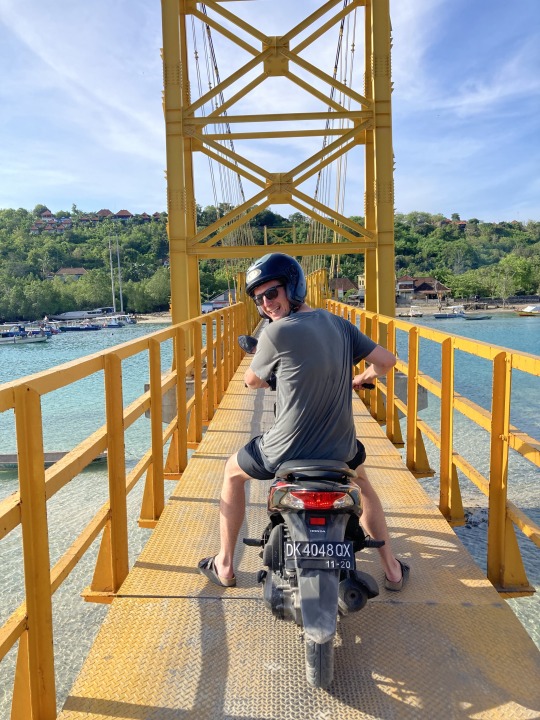
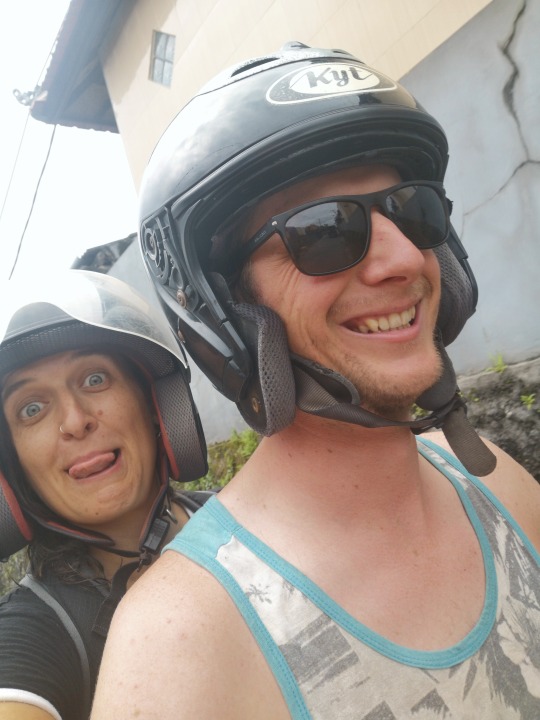
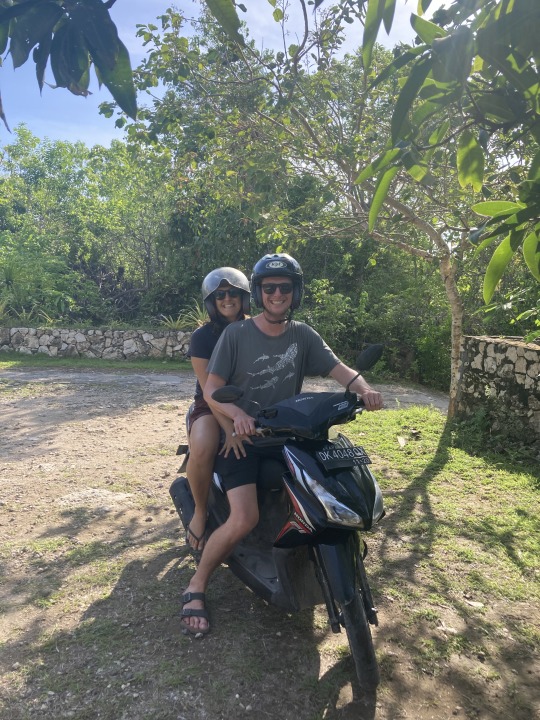

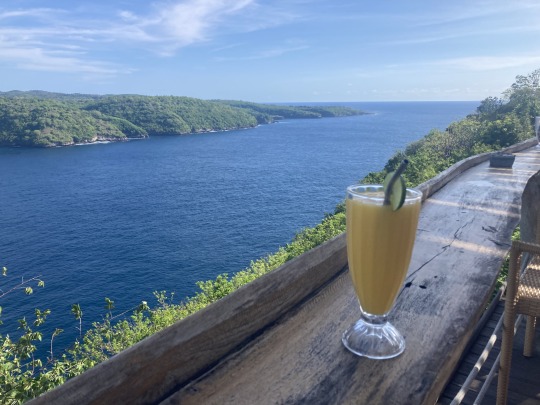
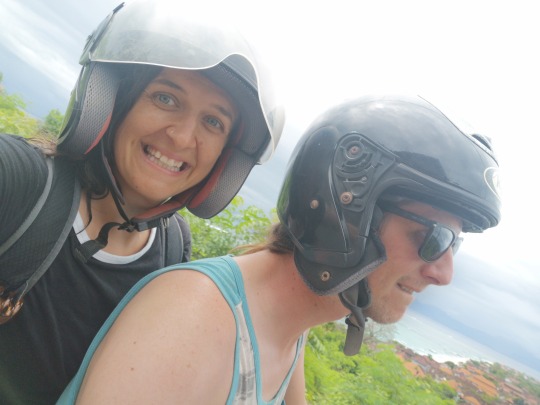
Photos above: crossing the Yellow Bridge!; scooter selfie; together on our trusty scooter stead; the view from the Ceningan "road"; the view from the Ceningan cliff restaurant; a selfie as we pass a beautiful panoramic scene (not that you can tell!)
Video above: crossing the Yellow Bridge!
Sam has been back to the doctor and his ears are thankfully slowly on the mend so we’re hoping to dive together soon. But then when I was diving yesterday, I had a real issue with my right ear when descending, and a quick check by the doctor suggests that I’ve got a bacterial infection in my outer ear. This is actually good news, in the sense that it’s a minor issue that will likely heal within a few days. But given that neither of us can currently dive, we’ve decided to go back to Bali for a few days to visit a town in the mountains that we’ve been keen to experience, to give all ears involved the time to heal before we commune with the sea again. After several weeks on this beautiful island, Sam is really keen to dive here, so we’ll be back again in a week, but for now, we’re off to experience some land-based sightseeing!
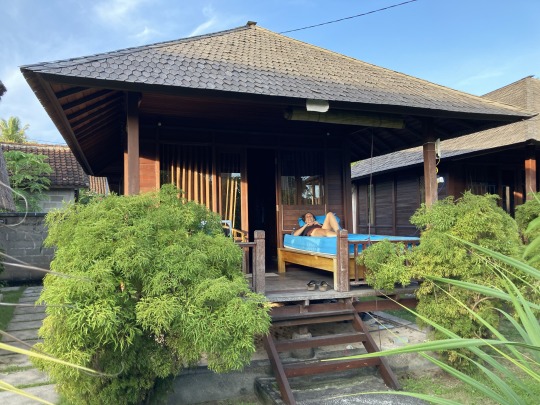
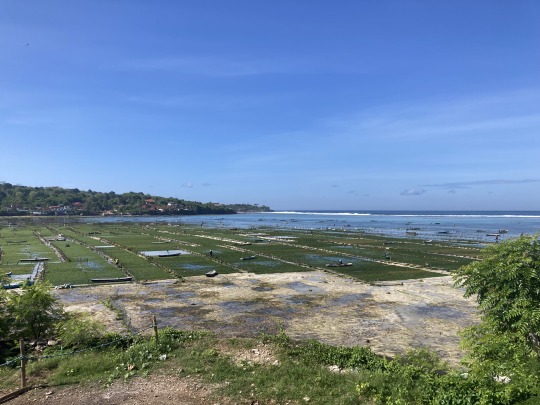

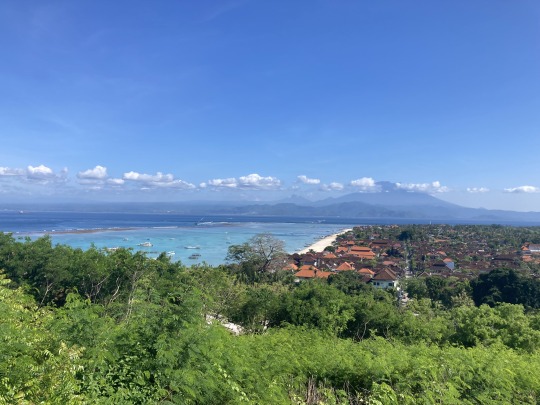
Photos above: our lovely island bungalow; the seaweed farms at low tide; one of the two banyon tree shrines on Lembongan; the panoramic view on the high pass between the two villages of the island during low tide
1 note
·
View note
Text
Slowing Down: The Island Life
Reunion
We last updated you all just as Sam and I arrived back in Bali’s capital of Denpasar. We booked into a hostel in the neighbourhood of Kuta—probably best known outside Bali as the site of the Bali bombings exactly twenty years ago. Now, Kuta is a crowded neighbourhood, a network of streets and alleyways lined with bars and street stalls and buzzing with an endless stream of scooters. We heard that it used to be the centre for tourists, but after the quiet of Covid, the crowds came back to a different neighbourhood, leaving a place past its best, with pretty pushy vendors and nearly empty bars. Though definitely not our usual vibe, our hostel itself was pretty quiet, with two large pools and a load of green foliage, and most importantly, it was a great, cheap place to stay with two of Sam’s schoolfriends for their reunion.
Jake turned up at the hostel within a few hours. Sam and Jake have known each other since they met at sixth form aged 16. Jake is one of life’s free spirits, having lived and worked abroad for years, always up for a party, always ready to celebrate life. Though he was back in the UK for the summer, he is shortly returning to Australia—where he’s been living for the last year or so—to work, and decided to stop by Bali on the way back for a couple of weeks. The reunion was joyfully celebrated by drinking Arak (the local Bali spirit) straight from the bottle while sat by the hostel pool. I went to bed early, but Sam and Jake stayed up to welcome Lloyd—another of their schoolfriends—at the airport in the early hours of the morning. Lloyd recently got a job as a travel coordinator and this 8-day tour of Bali would be his very first trip, timing perfectly with when Sam and Jake would be in Bali too. Sam and Lloyd met when they were both 11, and together with Jake they’re still part of a 9-man strong group of schoolfriends. As if Jake’s joie de vivre wasn’t enough, Lloyd is also wonderfully outgoing, a real partier, and fantastic travel buddy. I strongly suspect a lot more Arak was drunk once I was in bed—Jake and Sam used Grab (the local equivalent of Uber) to order scooters (much faster and cheaper than a car in the tiny, packed streets of Kuta) to get to the airport to meet Lloyd, but somehow only Sam turned up and Jake never recovered any memory of where he went so it will have to remain one of life’s great mysteries. Sam did make it to the airport and proudly stood waiting with a sign with a version of Lloyd’s catchphrase scrawled on it (Lloyd’s catchphrase being “Get loose, get goose”—don’t ask why—Sam was aiming for the “Loosest Goose” but apparently in the rush of creating the sign on a scrap of paper on the airport floor, he lost his ability to spell!).
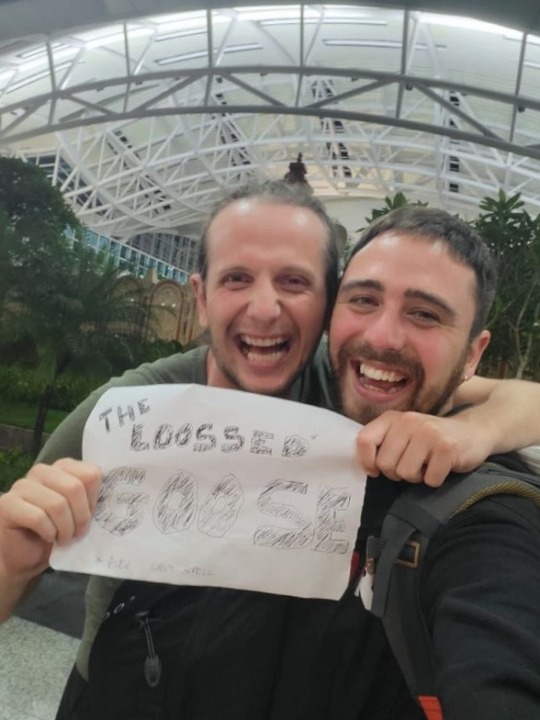
Over the next couple of days, we chilled in the hostel pool, ate out together, caught up, and of course, went on a big night out. For our night of partying, we headed to Canggu, the popular beach neighbourhood next to Kuta, where Freddie—the brother of yet another of their schoolfriends—has been living for the last few years. We met a huge group of Freddie’s friends, all foreigners working in Bali, at a local brewery. We had a great night out, drinking many a beer and espresso martinis at the brewery before heading next door to a karaoke bar for the remainder of the night (though unfortunately Lloyd’s song request never came up, which Jake, Sam, and Freddie were all prepped as backing singers for—what a gem of an experience that would have been to watch).


The Magic of a Small Island
At the end of the weekend, we parted with Lloyd as he left to start his tour, and Sam, Jake, myself, and Cora (Jake’s Spanish friend whom he lived with in Australia and who is also, completely coincidentally, in Bali at the moment) all caught a boat from Sanur, Denpasar’s port, across the water to Nusa Lembongan, one of three small islands off the south-east coast of Bali. There was no jetty at either end, so all passengers removed their shoes and waded into the sea to climb on and off the boat for the 45-minute journey.
Upon arrival, a taxi took us from the island’s port over the hill into the next bay where our accommodation was. The taxis from the port are pick-up trucks fitted with benches, which made for an excellent way to enjoy the lush tropical green of the island’s countryside, the extremely potholed roads, and the stunning panoramic view at the highest point of the hill pass, looking out across the village of Jungutbatu, its bay, and the dappled blue of the ocean. Our accommodation proved to be lovely too, a wooden bungalow not even thirty metres from the beach, once again with its own porch and porch bed (otherwise known as the reading bed for me, obviously).

It took us much less than a day of wandering for us to fall in love with the island. Lembongan has an estimated permanent population of 5,000 people and is a mere 8 kilometres squared. It’s curved, a bit like a bean, with the north-western side of the island lined with some incredible beaches and the couple of villages, while the south-eastern half has just a few roads amid its foliage and large mangrove forests. There are a few pick-up truck taxis and golf-buggy style vehicles, but mostly people get around on scooters or on foot. The village streets are lined with warungs (almost like permanent street food stalls for Indonesian food), restaurants, dive shops, houses, and ornate family temples (the vast majority of the local population is Hindu, as on Bali), and the ocean is never more than a few minutes’ walk. In the way of small islands, it has a slower pace—life seems to move in rhythm with the sound of the waves. On the beach right by our bungalows, we could sit on sun loungers each evening and watch the sun set to our left and see the vast beauty of Mount Agung, one of Bali’s volcanoes, across the water to our right. The first two nights, there were huge thunderstorms, the thunder cracking so loudly that we could feel the bed vibrate and the delicious sound of heavy rain on the bungalow roof for hours. We mostly lucked out with little rain during the day, except for one morning when we had to wade through the alleyway-turned-stream that led from our bungalows to the main road.


On our second day on Lembongan, we hired a local driver who owned one of the large golf buggies and we spent a day exploring the island. First we headed to the north, passing squares of seaweed left out on tarpaulins to dry (Lembongan seaweed is used for both cosmetics and food), to reach the mangrove forest. A local punted us through the waterways of the mangroves and a hush fell almost like in a cathedral.




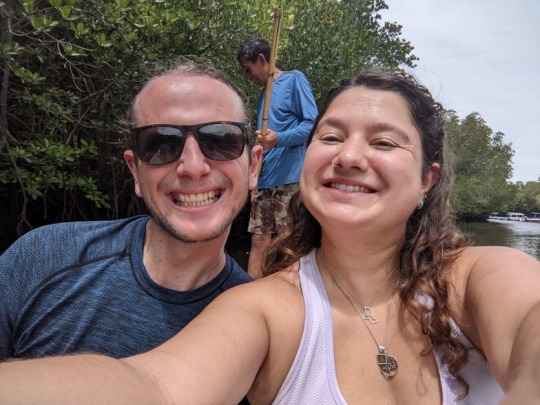

Next up, we stopped by Devil’s Tear, a rock formation on the south coast of the island that has been carved out by the continuous pounding of the ocean. We noticed that amid the crashing and spray of the immense blue waves, two Hawksbill turtles kept surfacing for breath. We then stopped by Dream beach for a dip in the sea—though the experience was somewhat marred by the vast amount of plastic in the sea which we later found out had been washed in from the ocean in the thunderstorms over the preceding couple of nights. Finally, we walked across Yellow Bridge, a bright yellow suspension bridge connecting Lembongan with its neighbouring, tiny island of Ceningan.

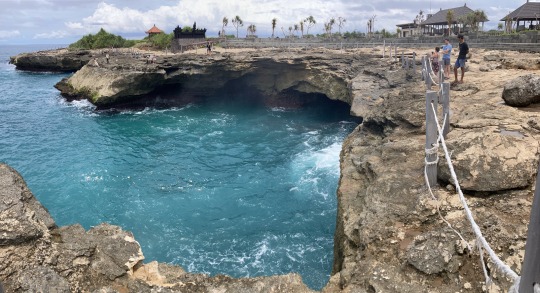


Over the next couple of days, Jake and I dived together. Sam’s ears were unfortunately still playing up and Cora wasn’t a diver, so on the first day, the two of them came along in the boat and snorkelled while we dived. This ended up being an excellent shout—we went south, to a dive site called Manta point and both on the surface snorkelling and diving down below, we all saw our fair share of manta rays. The visibility was pretty poor that day at roughly 5–7m (15–21ft), which made it really atmospheric as the mantas loomed out of the gloom and came cruising by, completely unfussed by the divers. Mantas are known for coming to this particular spot for cleaning and it is not exaggeration to say that Jake and I lost count of how many we saw—especially as they circle the site so we may have seen several individuals multiple times. Despite the visibility, Sam somehow managed to snap a magical shot of one individual from the surface.

On our second day diving, Jake and I headed north of Lembongan, diving out from the coast near its mangrove forests. We did a particularly cool drift dive, where we dropped into the water and then floated along with the current so that it was a bit like going on an anti-gravity, scenic tour of an incredible aquarium. As the north tends to get warmer waters and is more sheltered, there was a lot of bright coral, so much fish life, and the reef looked absolutely stunning.
Between diving and our other escapades, I also began creating a series of maps of large sections of Indonesia in order to map out the best diving spots, where to see which marine animals at what time of year, and add recommendations from people we meet along the way. I may be on holiday but there’s no leaving my nerdiness behind.
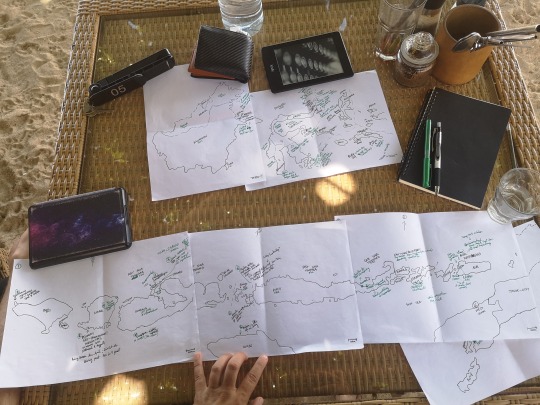
Misadventure
At the end of an amazing week together, we said goodbye to our travel buddies and Jake and Cora took the boat back to Bali to finish off their final few days of travelling. We also took the boat back to Denpasar for a long day of life admin. First up, we went to the immigration office to sort out the paperwork for our visa extension (to ensure we can stay in Indonesia for four months, rather than the initial two months already granted on the type of visa we have). Sam had started the day feeling pretty rough with an upset stomach and over breakfast I also realised I was feeling a bit off. By the time we left immigration to work through our other errands, I had become positively ill with Bali belly, so as we headed to a hardware store and then two different dive equipment thus preceded what can only be described as a vomit tour of the city. I eventually realised that my body needed to call it quits and somehow, magically, managed to survive the taxi ride back to the port, 45-minute boat ride back to the island, and 15-minute taxi back to our bungalow without any mishaps. Once back in our bungalow, I spent 12 hours lying in bed and fighting off a fever, but by the next morning I was tentatively starting to feel better. I spent that whole next day in bed, sleeping or listening to an audiobook, while Sam graciously brought me small portions of plain food at intervals, and slowly I started to feel more human again. Horrendous as this all sounds, I found it tragic and hilarious in equal measures almost immediately, even in the midst of feeling ill—there’s nothing quite like the lows of travelling to really accentuate the highs!
1 note
·
View note
Text
Arrival, Acclimatisation, and Amed
Hello dearest friends and family! Thursday marked our first full week since touching down in Bali, so we figured it’s about high time we updated you all.
Arriving in Amed
Our flights to Bali both flew by (oh yes, pun intended) without a hitch. Sam had organised an airport transfer from Bali’s capital, Denpasar, to Amed, a fishing village on the north-eastern curve of the island. It was evening and pitch black by the time we emerged from the airport so our first impressions on that three-hour journey were of the heavy, tropical air; the jampacked, scooter-buzzing traffic of Denpasar easing off as we moved into snaking mountain roads; and the glorious smell of earth and flowers after rain. Twenty-eight hours after we’d set off in the UK, we arrived in Amed and checked into a beautiful wooden bungalow right by the beach.
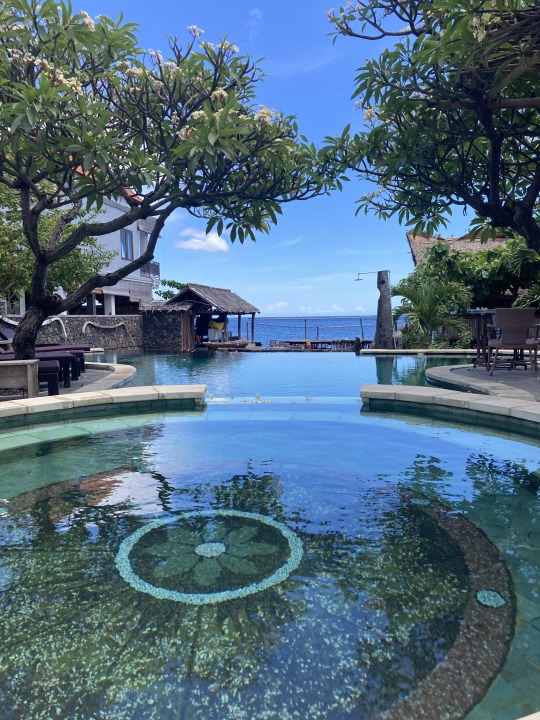

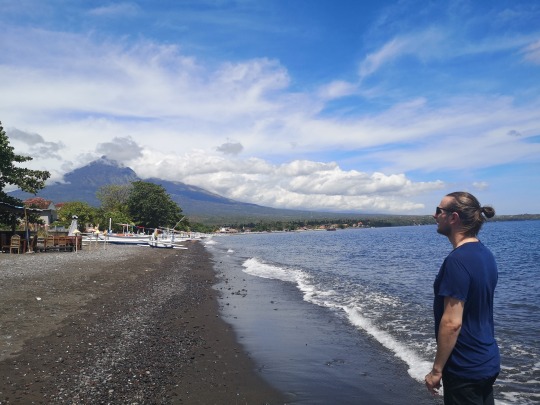
The next day, we awoke to an incredible view from our porch: the wooden bungalows arranged around a turquoise swimming pool surrounded by frangipani trees laden with the white and yellow flowers that Bali is famous for, all looking out across the blue of the ocean. A beautiful sight for jetlagged eyes. And turning to look the other way, I spotted Mount Agung, one of Bali’s volcanoes, rising up behind Amed, covered with lush forest that disappeared into the clouds shrouding its peak.
For the first couple of days in Amed we took things slow as we got over jetlag and found our bearings. I read more than I’ve been able to do in months, we swam a lot, both in the pool and ocean in front of our accommodation, and we began learning what the various Indonesian dishes were, sampling a lot of amazing food—so far being vegan has proved to be both easy and utterly delicious.
Return to Diving
After we’d had a chance to catch up on sleep and get acclimatised, we booked in for a couple of days of diving. It’d been a long time since we were last in the water—since Mexico in February 2020, right before the pandemic—so we figured it would be good to get back into the swing of things. Turned out that despite the intervening time away, it was much like getting back on a bike—it took us each less than one dive to feel at ease underwater again. And it only took a few minutes for me to feel utter delight at the underwater portal we had stepped through and the sheer joy of the weightlessness and freedom that diving gives. It helped that the sightseeing was so beautiful—we spent our time gliding over vibrant, healthy coral, surrounded by so much fish life and peering at amazing macro creatures living on the reef. We even met a couple of turtles along the way when exploring the reef-covered wreck of an American ship sunk by the Japanese during WWII.
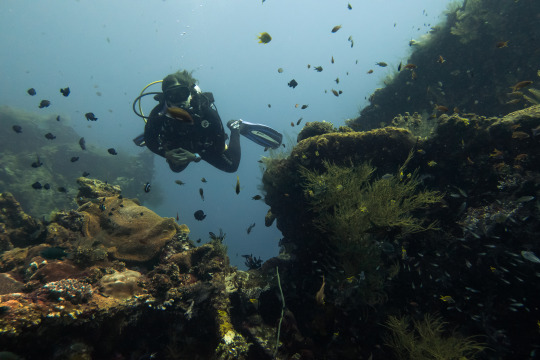
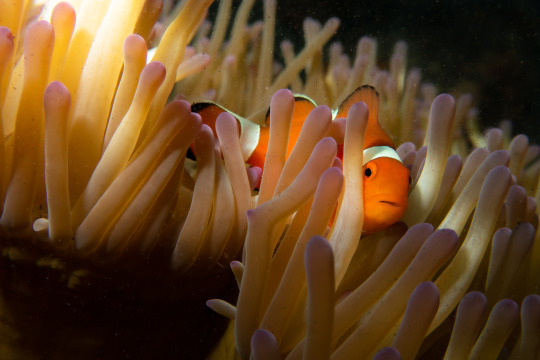
Explorations
Back on land, we also attended a local ceremony as part of the village’s Hindu celebrations for the full moon. One afternoon, we walked along the beach to join several hundred locals on the sand. They were all dressed in white shirts with colourful sarongs wrapped around their legs, white headdresses for the men and offerings for the temple balanced on the heads of the women. Everyone sat on the beach chatting amongst themselves as a group in the centre led the chanting and gong-playing. We settled down on the sand too and soon made friends with two local three-year-old twins. We may not have spoken the same languages as each other but turns out a lot of fun can be had with sticks and empty plastic water bottles, so we merrily played away for a good two hours. Suddenly a hush fell, and for a few minutes everyone sat facing the sea, palms together at their forehead in worship and eyes shut. There should have been complete silence but instead the air rang with the sound of two giggling children and I opened one eye to find the little boy twin gently poking Sam in the eye as both him and his sister dissolved in fits of giggles about it.
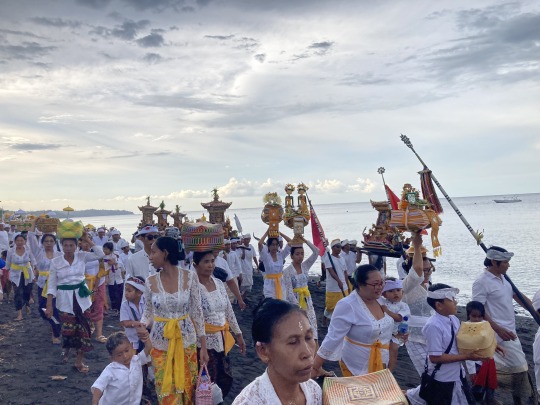
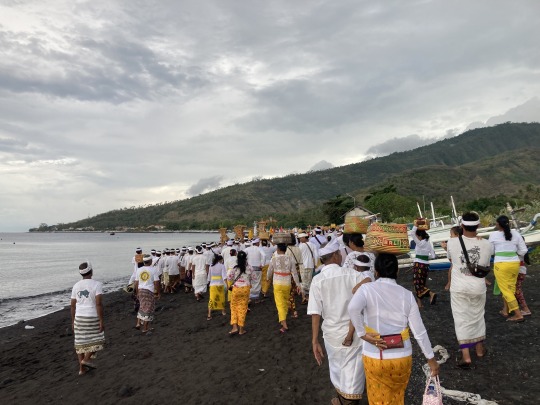
On our final day in Amed, we walked along to the next bay and I spent a couple of hours snorkelling (easily the most amazing snorkelling I’ve seen with so much life only a few metres from the surface) and then we climbed a short road above the village to Blue Earth Village, a community project of hatched platforms on stilts spanning a hotel, restaurant, freediving school, and yoga space. We did a Deep Flow Yoga session in the most beautiful yoga location I’ve ever seen—a wooden platform covered in a high thatched roof but open on all sides looking out over the village and ocean. As we did our practice, we heard chanting from the nearby temple, the croak of frogs, and the heavy evening rain, and as the sun set, a thunderstorm could be seen far away across the ocean as lightning lit up the clouds and water in purple and yellow streaks.
Our First Day Sightseeing on Land
The next day, we hired a private taxi to drive us back to Denpasar so that we could stop off at a few sites along the way. First up, we paused at the foothills of Mount Lempuyang and took a shuttle bus up to Pura Penataran Agung Lempuyang, a Hindu temple located on its slopes, one of the oldest and most sacred sites in Bali. It was breathtaking, with several parallel staircases and green terraces rolling up the slope of the mountain into the temple itself (which could only be entered if you were praying). The Gate of Heaven was particularly stunning—a set of stone gates parted to exactly frame Mount Agung (the same volcano that overlooks Amed). The queue to take a photo alone at the Gate was horrendously long so instead we spent our time wandering around the site and enjoying the spectacular views. It was easy to understand why it’s so sacred.

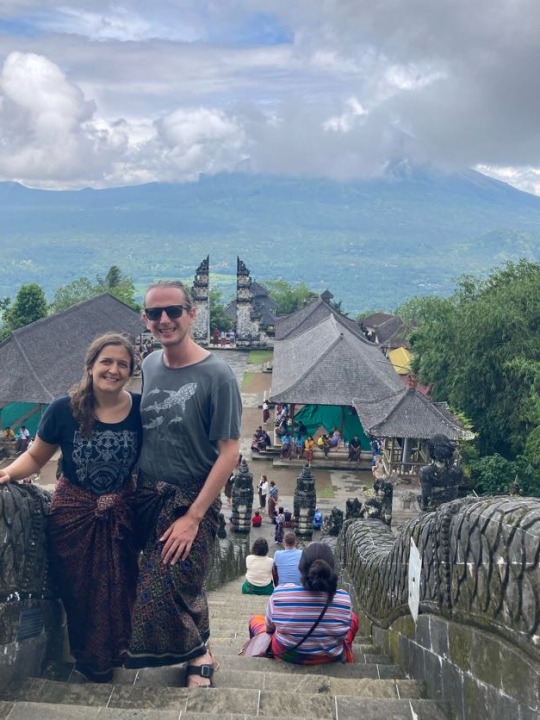
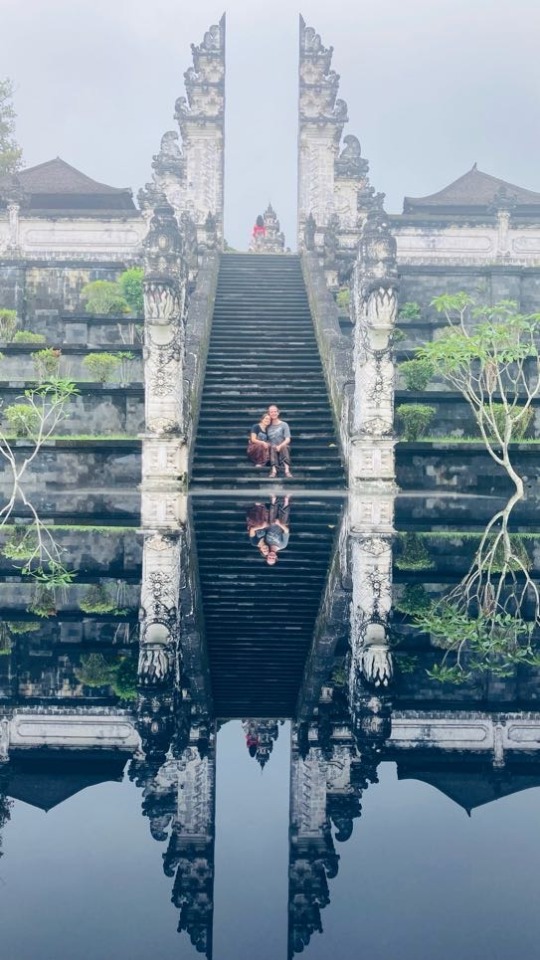
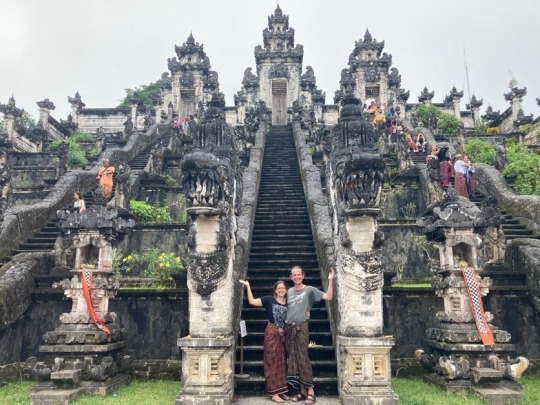
Next on our tour, we stopped by a plantation where coffee, cocoa, and various teas were grown. We were shown the original trees and plants, then the process for drying and/or grinding them into produce. We were even presented with a wonderful tray of tasters, spanning fifteen samples including coconut, avocado, and vanilla coffees, and rosella and mangosteen tea (all absolutely delicious). The area is most famous for Luwak coffee. I wasn’t sold on it though—the process involves grinding beans that an Asian palm civet (a small nocturnal mammal) has ingested and defecated (because they can discern which beans are perfectly ripe and which aren’t), so the coffee is highly prized and very expensive, but I didn’t love the miniscule wire cages the civets were kept in.
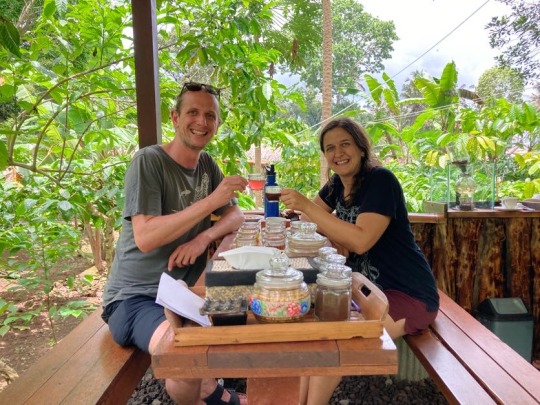
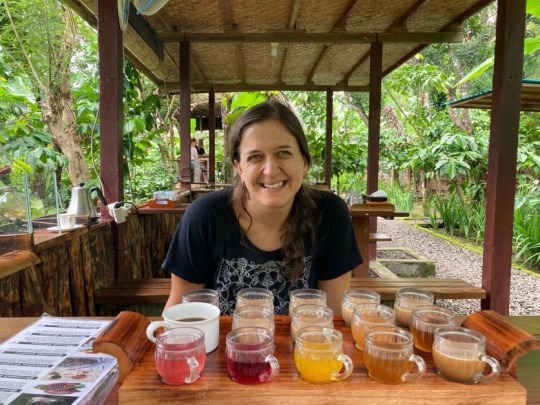
Finally, we stopped by Tirta Gangga, a royal palace named after the sacred Ganges river in India. Given its namesake, it was a homage to water, a series of pools, channels, and fountains, connected by bridges, stone pathways, and stepping stones, and adorned with ornately carved statues. The pools were filled with the largest koi carp I’ve seen in my life, so with the fish swimming, the water flowing and moving, and the lush tropical foliage and flowers, the place felt vividly alive.
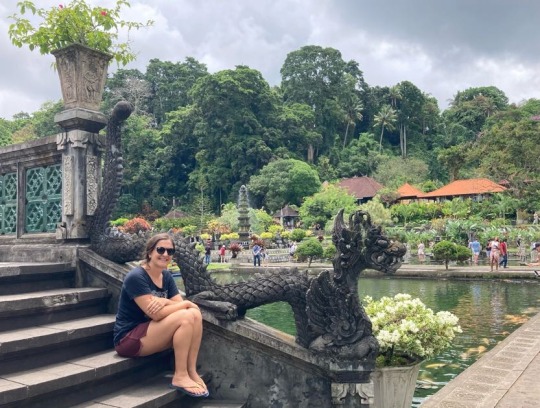
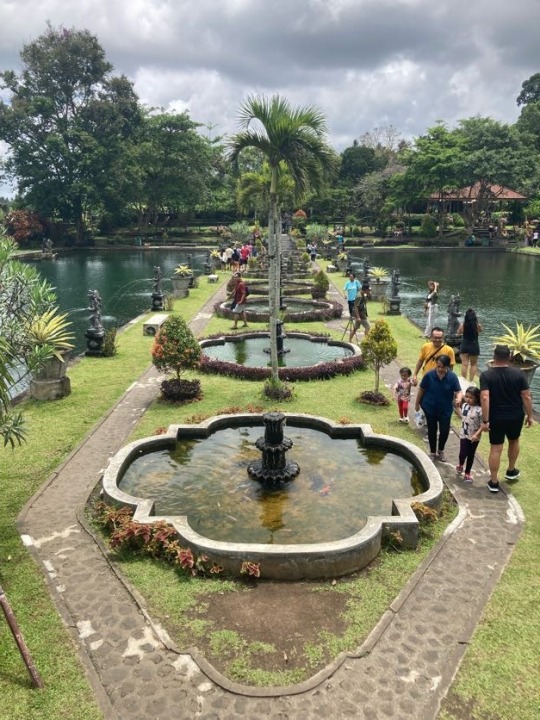

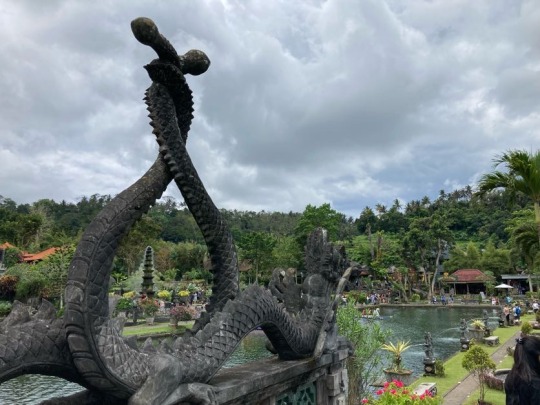


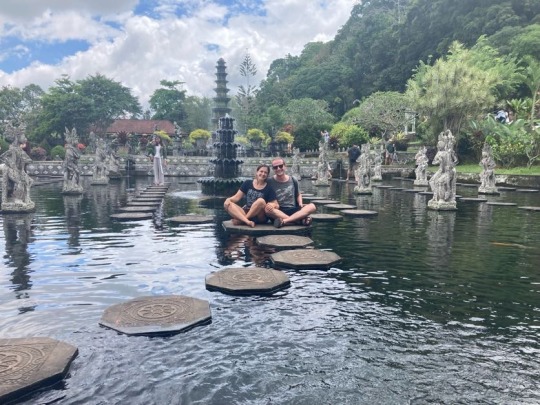
With our sightseeing done for the day, we drove south back to Denpasar. We had booked a hostel in advance because shortly two of Sam’s schoolfriends will arrive—amazingly they are completely coincidentally visiting Bali at the same time as us, one for work here as a guide, one on his way from the UK back to his work in Australia.
And with that, our first week in Bali zoomed by. More coming soon, so for now, over and out!
1 note
·
View note
Text
Resurrecting Meanderful: The Start of a New Adventure
It has been quite some time—three years and seven months to be precise—since we last posted on Meanderful, our blog scrapbook of ramblings about our meanderings.
Back in March 2020, Sam and I had just flown back into the UK a mere handful of days before the national lockdown was announced, after four months living, diving, and working remotely in Costa Rica and Mexico.
We now find ourselves several years and many life events later. Since March 2020, we’ve moved from Norwich, the lovely city in which we met and our home for a decade, to Bristol, which has actual hilly terrain and several of our closest friends. After our Brizzle move, Sam joined a software consultancy and loves his work, particularly the staff culture and interpersonal aspect of his role. And I continued in my role as COO of the storytelling charity, Brink Literacy Project, as we not only weathered the fallout of the pandemic but somehow managed to launch our most successful fundraising campaign ever.
Since our move, we’ve lived in two rentals properties in Bristol with my sister Jo, which has been hugely fun. And then just last week, Sam and I finally, after nearly two years of looking and withstanding the horrifying purchasing process in England, bought our very own house together. OH YES WE DID! And what better way to celebrate a new home than instantly zooming off halfway around the world on a four-month sabbatical to have yet another adventure?!

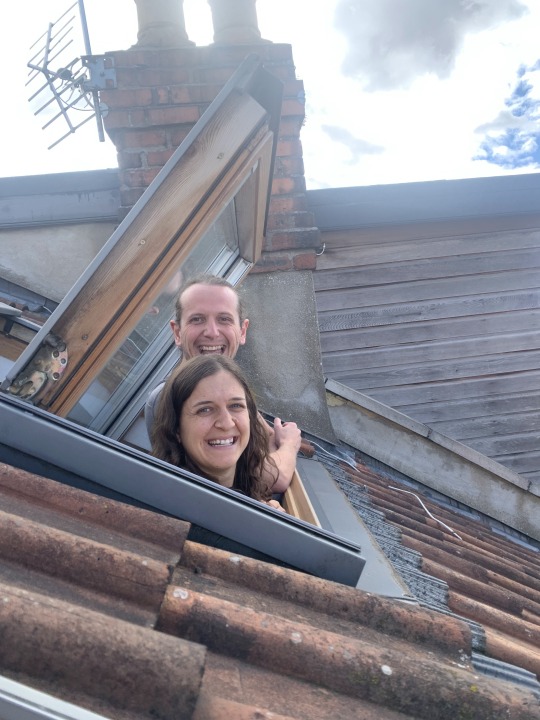
Over the last few weeks, we’ve both wrapped up our work (our workplaces have been incredible about us taking the next few months off for a sabbatical), packed up our rental place, and moved and unpacked in our new home.
Which brings us to the present moment, in which we find ourselves all packed up and ready to set off tomorrow to Indonesia. Everything’s been oh-so hectic this past month that nothing feels real yet… I guess it will hit us once we are on the plane?!
P.S. We have set up an automated email notification for whenever we post a new update, so just ping us a message if you’d like to be added to this list!
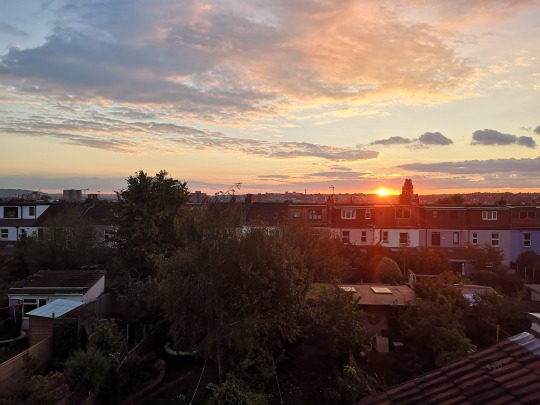
1 note
·
View note
Text
Return
Hello friends and family, It has been quite some time since we last wrote an update about what we have been up to and, given everything that has happened in the last few weeks, we realise it is important to let you all know how and where we are. We seem to have been very fortunate with the timing of our trip as we booked our return flight for March 18th months ago. So, after one packed plane ride back between eerily deserted airports, we are now safe and cozily self-isolating with Helen's family in Cambridgeshire, just in case we picked up anything on the flight. It's been a strange last couple of weeks, but we were able to enjoy the island of Cozumel in amongst all the troubling news. A particular highlight was hiring a car for our final weekend to explore some of the island. A 70 km road creates a circuit around most of Cozumel, taking you out of the urban area, through the jungle to cross to the far coast, then all along the sea until you complete the loop back into the only the town. Our favourite part of the drive was cruising along the coast on the uninhabited, far side of the island. It’s the windward side of the island, where the brilliant blue Caribbean sea meets virtually untouched sandy beaches that have a certain wild feel to them. Our destination was a small nature park on the southernmost tip, where you could relax on a beautiful beach, take a boat ride through the mangroves and climb the lighthouse to take in the natural beauty. It was helpful to top up with one final weekend of warmth before returning to chilly England.
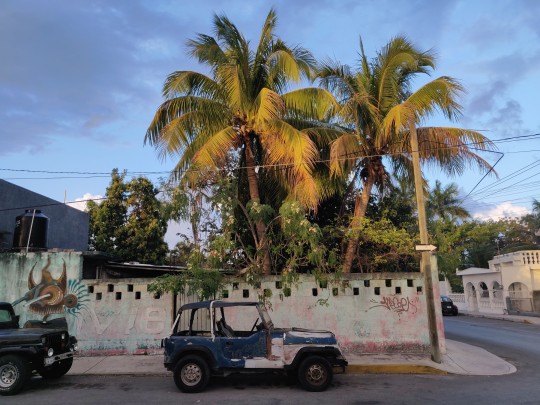
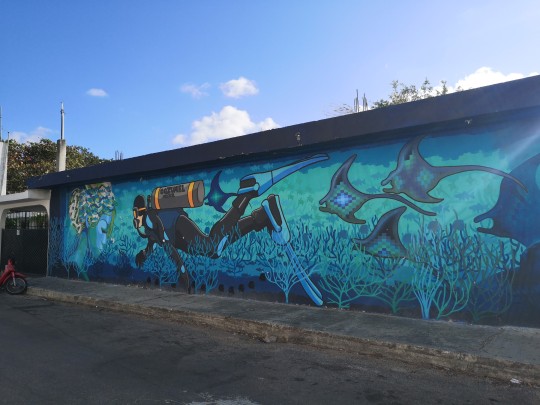

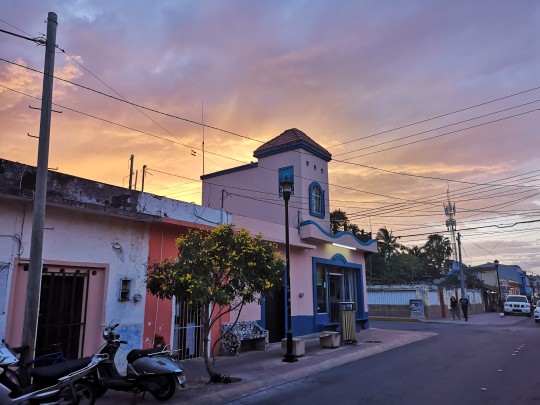

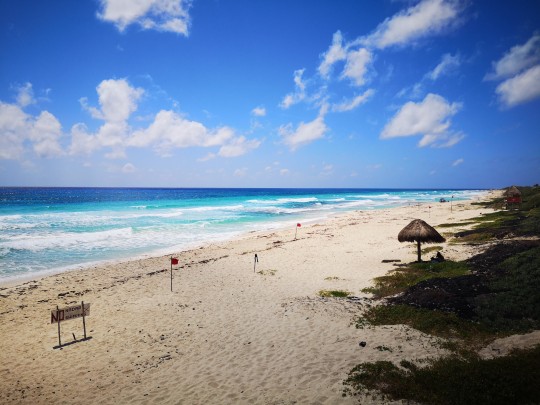
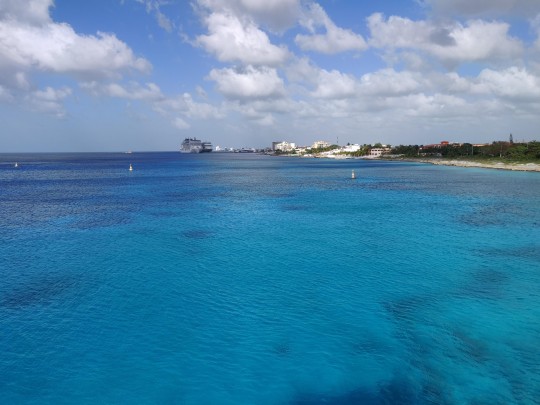
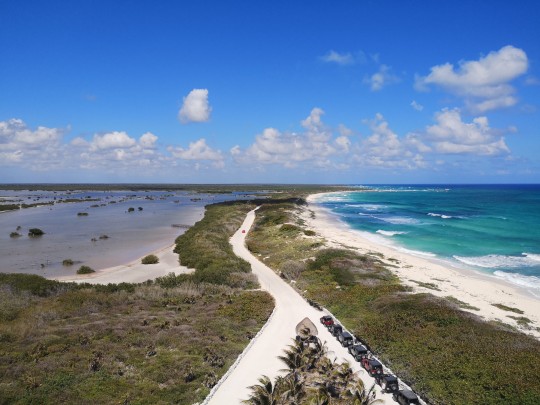

And now we are back and adjusting to this new world that we all find ourselves in. Trying to work out what it all means for society at large, but also for the microcosm of what next steps we will take together. It is also a time when we are thankful for all of the experience that we are fortunate enough to have in our lives, be that visiting other countries and cultures, the pleasure that can be found in simple day to day life or when sharing time with each of you, who mean so much to us. I hope that you are safe, well and that it will not be too long until we get to see each of you again, but in the meantime we send you all lots and lots of love. Sam and Helen Xxxxxxxx
1 note
·
View note